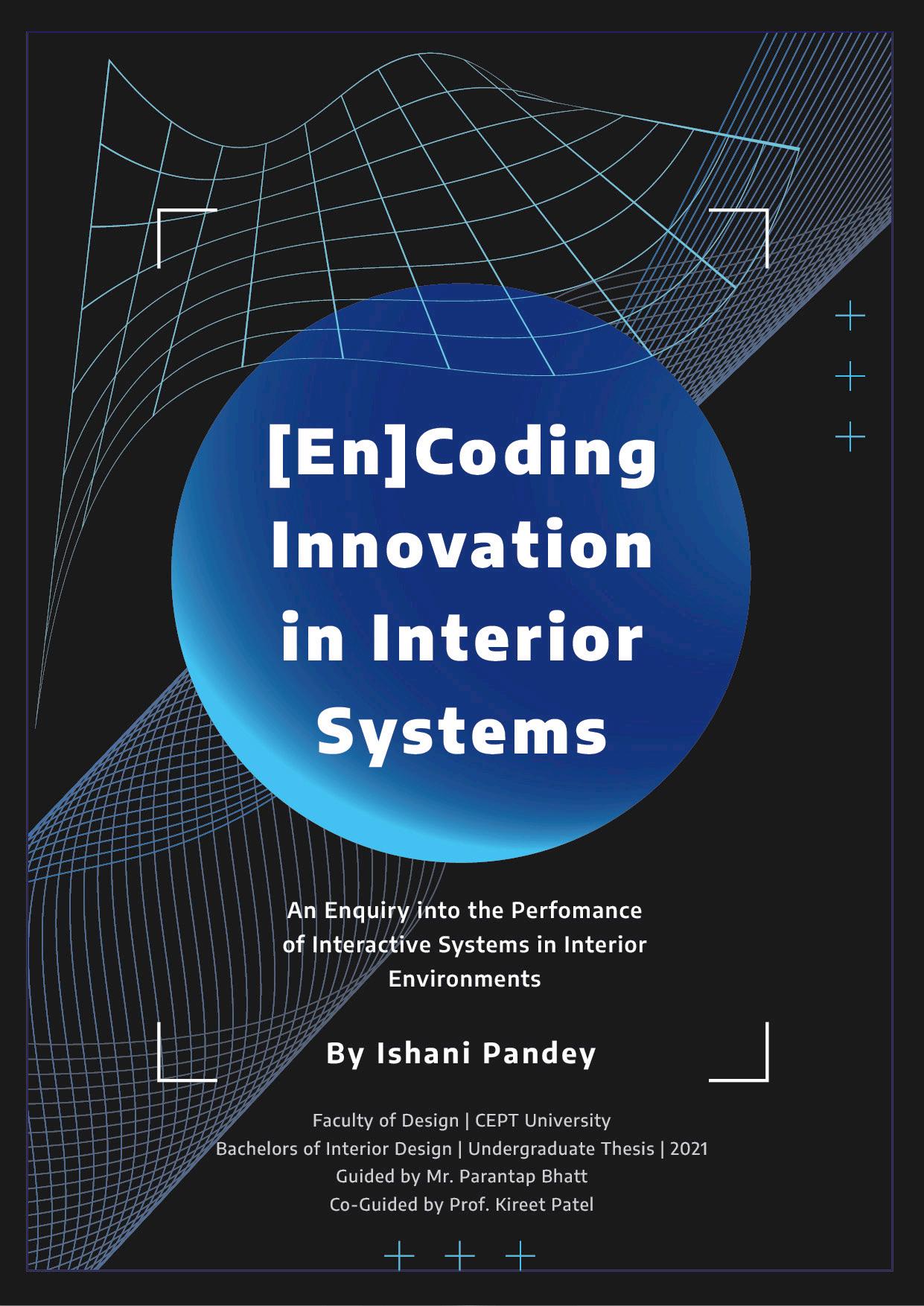


APPROVAL

The following study is hereby approved as a creditable work on the approved subject carried out and presented in the manner, sufficiently satisfactory to warrant its acceptance as a pre-requisite to the degree of Bachelor of Interior Design for which it has been submitted.
It is to be understood that by this approval, the undersigned does not endorse or approve the statements made, opinions expressed or conclusion drawn therein, but approves the study only for the purpose for which it has been submitted and satisfies him/her to the requirements laid down in the academic programme.
Kireet Patel Name & Signature of the Co-Guide Dean, Faculty of Design

FACULTY
WWW.CEPT.AC.IN T +91 79 26302470 F +91 79 26302075 KASTURBHAI LALBHAI CAMPUS UNIVERSITY ROAD, NAVRANGPURA AHMEDABAD 380009. GUJARAT, INDIA
OF DESIGN
Student Name & Code : Ishani Pandey ( UI2116 )
Thesis Title : [En]Coding Innovation in Interior Systems
Prof.

Acknowledgment
It was a tremendously inspiring and challenging journey to complete my thesis during the most demanding time we have faced. Through the strength provided to me by many, I reach the end of my academic journey at CEPT. I want to express my deep gratitude to my Guide - Mr Parantap Bhatt, for inspiring me, supporting me and introducing me to the world of interaction and design. Thank you, sir, for giving me inspiration and strength despite being ill due to COVID. I would thank my Co-Guide - Prof. Kireet Patel, for teaching me the value of hard work, individualism and originality. Thank you, sir, for inspiring me in my five-year journey at the School of Interior Design, CEPT University. You are and will always be my “Guru”, thank you for teaching me the true meaning of that word. Thank you for teaching me the true importance and responsibility of being a designer in the real world I am about to step into.
I would like to thank Amal sir for introducing me to innovation and design and always inspiring me, and supporting me to strive for better. Thank you for sharing your perspective on design knowledge and books, which inspired me to go down this road. I would like to thank our Dean, Prof Anand Behle, for the inspiring insight and critique during our discussions. Thank you for always lending a helping hand to us. I would like to thank Jay sir and Rishav sir for introducing me to the field of research and experience. My learning from DICRC has immensely helped me to pursue my research despite all obstacles. I would thank KD sir and Chandra ma’am for constant support and help during thesis or work related to the role of Academic Secretary.
I would like to thank my mother, Mrs Ragini Pandey and father, Mr Pankaj Pandey, for all the love, strength and support they have provided me through such times and always. I would like to thank my brother, Ishaan Pandey, for always helping and being my best friend.
I would like to thank Pankti and Anshula for constant love, enthusiasm, care, discussions and support always. I would thank Shivam for his inspiring thoughts, care and help. I would like to thank my best friends, Sohita, Mahek, Ankita and Bhawnesh, for their immense love, service and support throughout the tough times and good ones. I would like to thank Shlok for helping me gain a new perspective on technology and lending me any help needed to pursue my research.
Lastly, I would like to thank Babu and Buddy for loving me and keeping me stress-free during the challenges that came about.
Thank you all for your support in good times and bad.
Dedicated to all those who are fighting through harsh realities during the COVID - 19 Pandemic
11 10
“ Technology is the answer, but what was the question ? ”
Cedric Price
Table of Contents 00 01 02 03 04 05 I II 0.1 Abstract 0.2 Introduction to the Study 0.3 Research Questions 0.4 Conceptual Framework 0.5 Research Methodology 0.6 Significance of Study 0.7 Scope and Limitations 1.1 [En]Coding + 1.1.1 Phenomenon of Interaction 1.1.2 Phenomenon in Nature 1.1.3 Phenomenon in Systems 1.2 Anatomy of Interactive systems 1.2.1 Interaction + Digital Space 1.2.2 Interaction + Physical Space 2.1 Interaction + Interior Environments 2.1.1 Interactive environment through Actor-Network Theory 2.1.2 Interactive environment from a Cybernetic Perspective 2.2 [En]Coding through Technology 2.2.1 Technology as Tool of Adaptation 2.2.2 Technology as Tool for Innovation 2.3 Application and Operation of Novel Tools and Heuristics 2.4 [En]Coded Systems + User Experience 3.1
systems + Design Process 3.2
3.3
as
4.1
4.1.1
4.2
4.3
4.4
4.5
4.6
[En]coding Interaction in Interior systems Introduction Multi-Mediated Environments [En]coding Innovation + Interior Design
the Research
5.1
-
-
-
-
-
5.2
I.I Glossary of Terms I.II Reviews and Actions II.I
II.II
Citation 15 26 - 37 16 17 18 20 22 23 38 - 43 46 - 55 56 - 66 67 - 71 72 - 75 78 - 81 82 - 83 84 - 83 88 90 - 95 96 97 98
140 142
145 146 150 - 155 156 160 162 166 174
[En]Coded
Novel Application of Spatial Optimization
[En]Coded Interior Systems
an Approach
Introduction to the theory
Factors governing Interactive Spatial Environment
Case Study Methodology
Selection of Case Studies
Case Studies
Comparative Matrix
Inference
[De]coding Interactive Environments Outcome of
Appendices
Conclusion
[En]Coding as a phenomenon for interactive systems
Enhancing user experience through sixth sense
Sensorial Environment as a Need
Innovative Interior Practices
Re-Interpreted Role of Interior Designer
Future Research
Bibliography
Images
-
-
Interior Design Interaction Design
the physical realm the digital realm
The flow of information through interior system. Interaction through the spatial artifacts.
Interactive Built Environment
In the digital age of transformation, the role of interior designer is no longer restricted to being the organizer of space and matter; it has extended to designing complex systems with multi-layered components.
The Montreal Design Declaration defines design as “the application of intent: the process through which we create the material, spatial, visual and experiential environments in a world made ever more malleable by advances in technology and materials, and increasingly vulnerable to the effects of unleashed global development.”

The ongoing paradigm shift in the role and profession of the interior design field in the age of code is beyond coherent differentiation between the disciplines or beyond the linear communication channels, which has impacted and transformed the industry of design since the industrial revolution.
In the age of linear code, interior design’s emerging practices transform to develop innovative “multimediated” spatial environments. Interactive environments have now made a significant presence in the domain of private and public life. As a spatial medium, intelligent systems and responsive environments are revolutionizing and reinventing our home, as well as our work and leisure spaces. This research investigates interactive interior environments and how the virtual and physical worlds’ perceptual boundaries are intertwined. The study aims to understand how interactive environments’ spatial elements creatively adopt the fourth dimension of newly evolved technologies. Through understanding multiple factors influencing the innovation and evolution of such environments, the study will aim to comprehend the need and capability of such interactive spaces.
Keywords: Interactive design, Interior systems, Responsive environments, Multidisciplinary approach.
15 + Abstract
+ Introduction to the Study
As technology transforms the world today, designers have the capability and the tools to merge the two different realities of physical and virtual environments. With the aid of augmented reality, virtual reality, kinetic systems, mechanical systems, and interactive elements, we can bring a sensorial impact into space with the help of virtual spaces facilitating physical dimensions. The interaction can be limited to the gestural performance and multi-mediated systems to communicate with space, such as turning on light by clapping or being complex, completely transforming the space into a hyper-reality environment. These interactive tools and their impact on the spatial systems develop into essential elements of space and need to be analyzed and understood by interior designers.
Nowadays, there is an increased effort to reduce the movement from one place to another, and the significance of spatial diversity has increased, due to which a need has arisen for flexible spaces. Such spaces can transform to the user’s need and transform and adapt to the surrounding environment. This kind of interior system offers maximum flexibility and personalization to the users, enhancing the relationship between user and space.
These hybrid interactive spaces create new realities and possibilities in interior design and should be developed as a designer’s tool. Such systems would need to be understood from different perspectives of space-making approaches and virtual and mechanical transformations in space. It is essential to consider how these spaces would impact the psychological and sociological aspects and create new ways to understand the utilization and optimization of spaces.
This thesis aims to focus on innovation in interior design due to the evolution of hybrid interactive spaces. This research will critically evaluate the space-making approaches from an interior designer’s perspective and explore the implications and importance of the potential development of encoded interactive spaces.

+ Research Questions
Primary Research Question
• How does the integration of Interactive components in the Interior system offer the potential to enhance the experience of built environments?
Secondary Research Question
• What is the significance of interactive systems in Interior design?
• What is the role of interaction in interior environments and its impact on how the user perceives a spatial design?
• How do sensorial environments aid in the development of intimate connections between the viewer and the portrayed subject?
• What needs do the users of the space have that are adequately met?
• How are responsive elements manifested as an integral and poetic element in the interior environments?
• What are the various methods or models of integration?
• Understanding the need for a transdisciplinary approach and developing a process?
17
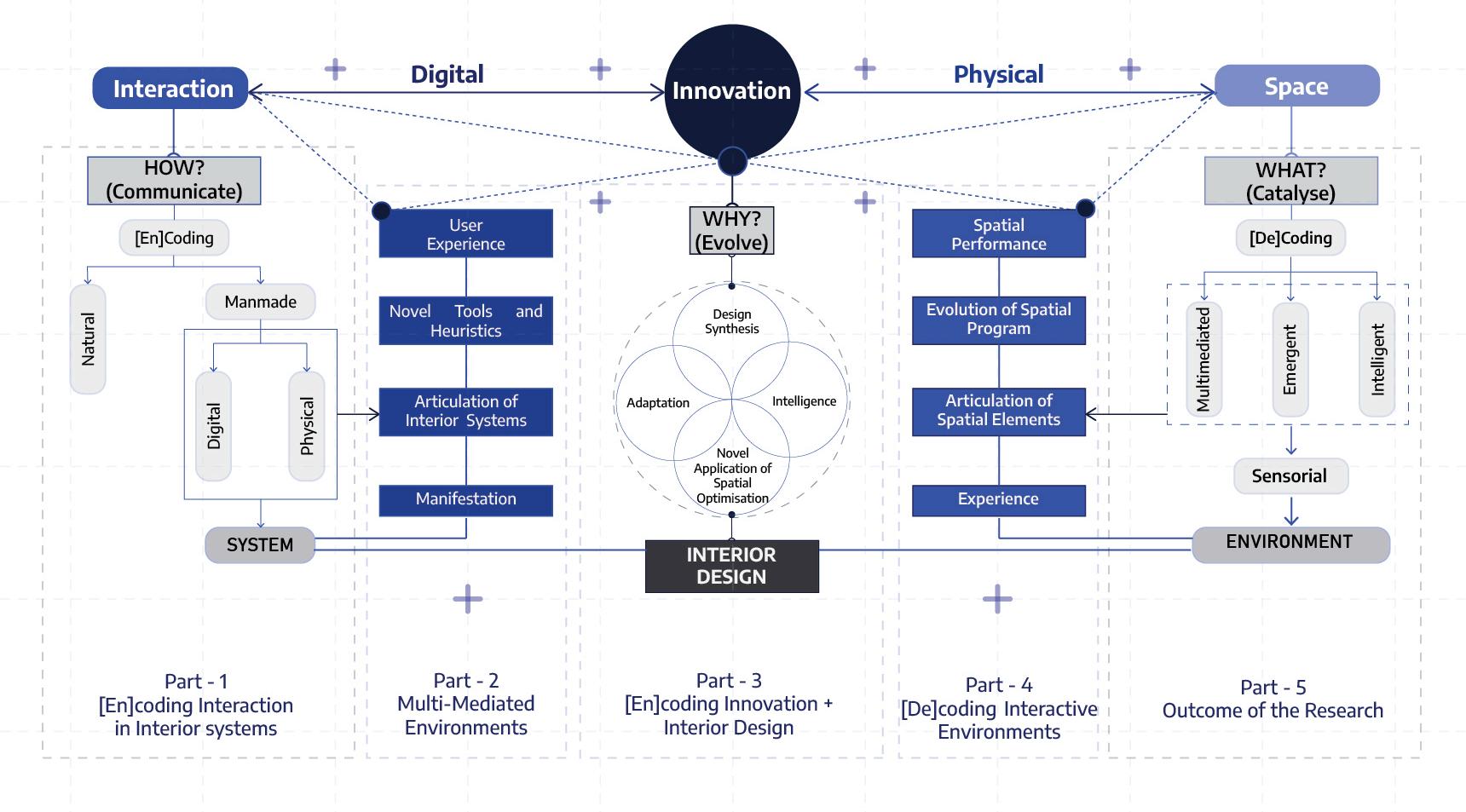
19 18
+ Conceptual Framework
Methodology
+ Research Methodology
Qualitative research initially develops an understanding of interaction as a phenomenon in various physical and digital means through encoding and decoding. Various literature reviews allow the research to further develop a critical viewpoint on the perception of space and user for systems that enable adaptation and intelligence in the spatial environment. With the help of a conceptual framework developed, the research is divided into five parts evaluating the relationships between intertwined realities of digital and physical and innovation with spatial design in focus. These factors are further analyzed and understood to gain perspective on the systemic manifestation of interaction in digital and physical environments. Through the literature reviewed, multiple theories such as Gordon Pask’s Conversation and Cybernetic theory and ANT theory are analyzed to derive a framework to understand the interactive systems manifested in spatial environments.
This research framework is then evaluated from the perspective of behavioural and environmental perspective of space and user to understand the novel application of spatial optimization in a case study based research.

Through the developed research framework and theories of interactive systems, three models of interactive environments are deduced to understand the significance and impact of each of them. The three case studies are chosen based on the three models they represent through spatial character and interactive environment. The chosen case studies are analyzed using photographs, sketches, drawings, illustrations, mind maps and text explanations. The behavioural and environmental factors are evaluated to further do a comparative evaluation of novel factors of spatial optimization for each of the chosen studies. Based on the readings from the comparative matrix and the behavioural and environmental factors analyzed, inferences are drawn to understand interactivity from a spatial perspective.
These inferences lead to the conclusion of the research on the innovation of interior systems through encoding interaction.
20 21
Research
+ Significance of Study
Technology can be specified as any tool which helps a designer. However, it is essential to understand how technology helps an Interior designer create smart solutions that successfully integrate design components, ease operation, enhance performance and minimize utility costs over the design’s life cycle. The research will aid the designers in understanding the critical aspects of designing cross disciplinary projects with programs which focus on exchange of information and invoking sensorial aspects of space.
Interactive spatial design has a unique opportunity to positively influence and reposition the role of interior designers. The role of the designer should focus more on the catalyzing on how the design should evolve. Designing an interactive spatial environment should be like an emergent endeavor which fosters a futuristic platform for design solutions.
+ Implications of Research in the Field
The interior designers are well suited and equipped to design and conceptualize interactive systems in interior spaces, because of their professional experience and background in understanding the environmental and user demands and visualizing space. For designers to take an active role in development of interactive environments, it is necessary to have a contextual understanding of the history of interactive environments and understand the driving forces which mostly reside outside the field of interior architecture. Hence this research will aid contribute to the development of interactive systems in Interior Design field.
Scope of the Research +
• The study evaluates and identifies the experiential and interactive systems and components of space from an interior perspective.
• The research identifies the relationship between interior and interaction design disciplines and their role in space making and optimization.
• The research develops a critical viewpoint on the role of technology as a sixth sense and its impact on interior design.
• The case studies are identified based on different modes of interactive systems and further evaluated based on novel approaches of spatial adaptation and optimization.
• The thesis looks at the importance and factors of innovation in interior design and provides a basis for new perspectives in future research.
Limitations of the Research +
• To ensure better understanding and safety amidst the outbreak of COVID - 19 pandemic, case studies were chosen from limited well-documented examples of international projects
• The study considers behavioral and environmental factors evolved from literature to understand the impact of interactive systems on users and spaces and does not look at the spatial factors such as design details, space planning, etc.
• The study only focuses on understanding the interactive systems and factors about their evolution and evaluation.
• The study does not critically focus on or evaluate the typology, location or function of interior environments as primary factors.
23 22
25
[En]coding Interaction in Interior systems [En]Coding + Phenomenon of Interaction Phenomenon in Nature Phenomenon in Systems
Anatomy of Interactive systems Interaction + Digital Space Interaction + Physical Space 01 01
1.0 + [En]coding Interaction in Interior systems
In the digital age, our focus has shifted to a new vision for perceiving matter and the perspective of interacting with the world around us. The phenomenon of programming will not be contained to just computers in the near future. The chapter embraces the notion of communication we perceive with the world and how it transforms towards interaction due to a materialistic revolution. The technology today allows us to compute, actuate and sense with materials and spatial technologies. It is becoming increasingly evident that encoding materials and systems are a platform for transforming digital information into physical functionality and performance. In the past, we only could program computers, but today we can program the spaces themselves.
Borrowed from Donna Haraway’s “A Cyborg Manifesto “works, the diagram shows a new subjectivity to the human-machine relation. It highlights the hybrid interconnections between humans and machines that map our physical, social and human reality.
Figure 1.1Illustration from Donna Haraway’s works “A Cyborg Manfesto”. The fictional evolution of new relations between the human and machines to develop new perspectives towards performance design.
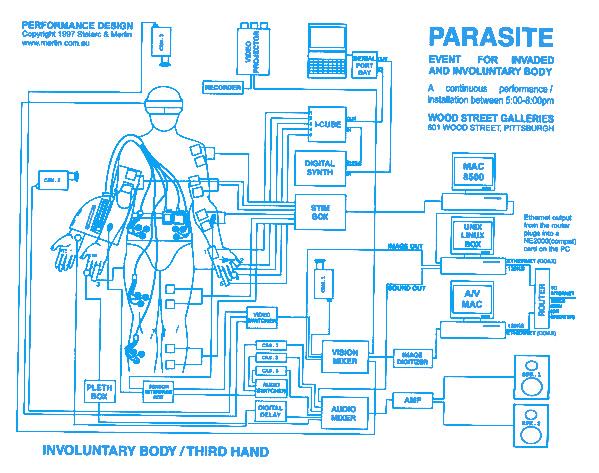
Figure 1.2Mode of communication. Human engage in exchange of information through encoding and decoding conversations.
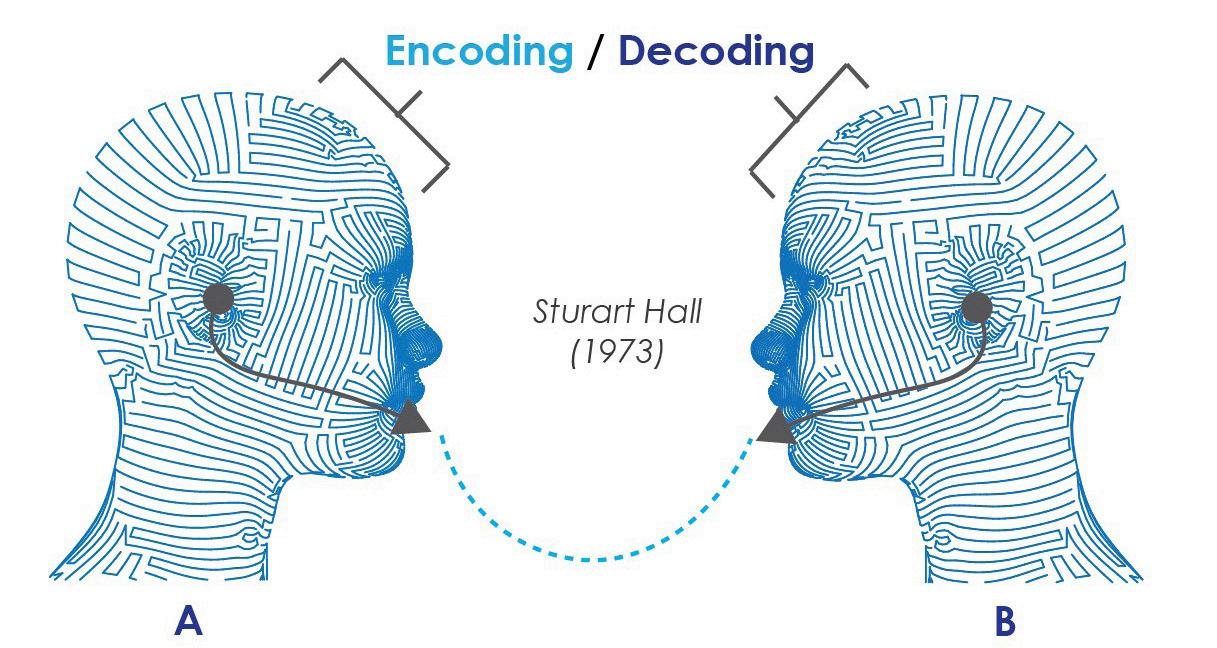
1.1 [En]Coding
In simplest terms, humans communicate with each other through a phenomenon of encoding and decoding. As specified in Merriam Webster, the definition of encoding is to convert (information) from one method or system of communication into another, which is, convert (message) into a code.
The phenomenon of encoding can be further understood by looking at the interaction model of communication. It represents communication as a process involving multiple participants alternating their positions as the sender or the receiver and deciphering or generating meaning by sending information and receiving feedback in the psychological and physical contexts (Schramm, 1997). Hence, the phenomenon of encoding programs the communication process to be a two- way interactive approach rather than one way, linear process.
The interaction model also accompanies the inclusion of a feedback loop, resulting in a more complex understanding of the role of participation in encoded communication. Each participant simultaneously switches between the roles of receiver and sender to allow the communication to go on. This undergone process is usually without any conscious thought. Through the phenomenon of encoding, Interactivity can be understood as a process consisting of many interrelated actions in a chain between two or more interacting objects. Hence encoding is a bi-directional conduit. Encoding as a phenomenon can help develop a relationship between interacting subjects in which the response is inherently reciprocal. During the interaction, the subjects can be encoded to transform or otherwise change as per applicable requirements.
27 26
From this perspective, the phenomenon of interaction can be judged based on a variable degree. They can be differentiated in terms of the relativity of interaction from more minor to more. This degree of interaction is proportional to the encoded exchange of information and the amount of reaction or change this exchange invokes onto the interacting subjects.
Sheizaf Rafaeli defines interactivity in terms of communication as the extent to which any series of communication exchanges would relate to the previous exchanges. Hence encoded interactions can be distinguished based on the two-way and reactive variants. The classification of the phenomenon of encoding can be done as follows.
• If the interaction is encoded and exchanged in two ways but does not relate to one another, two-way communication occurs.
• If information is sent in a process and related to a previous interactive exchange, reactive communication occurs.
• If information relation during the exchange is related to various interactive exchanges, interactive communication occurs.
Figure 1.3Interactive mode of communication.
Several factors imbued in the process of exchanging information which results in interactiveness
To use the term interactivity scientifically as a variable, we need to understand interaction in spatial systems more precisely.
Figure 1.4DUNE is an landscape of light which is designed to interact with behavior of participants around it. The systems is composed of multiple fiber which react on the motion or sound of passing visitors.
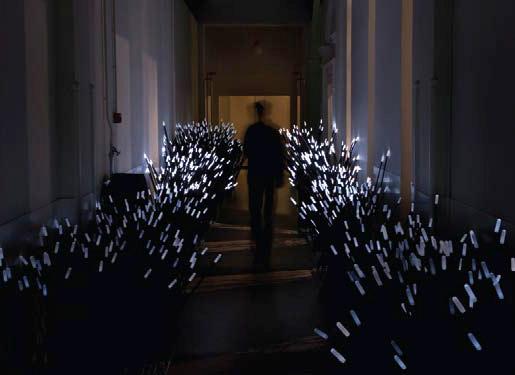
1.1.1 Phenomenon of Interaction
In simple terms, Interaction is a continuous transfer or exchange of information in both directions or between two entities (Glynn, 2016).

This exchange could be between digital or physical. Since only physical and tangible interactions are possible in the spatial realm, all digital media projects, though interactive, cannot be considered a part of Interactive systems. According to the definition, Interaction is a two-way street.
As the world transitions into the new age where the lines between the physical and digital become indistinctive, interior design re-shapes as an active participant in people’s lives. With the addition of technology as a tool of innovation in the internal architectural realm, the focus on aesthetic concerns regarding space and form extends to the new concerns regarding aesthetics of behavior, impacting space evolution. Factors such as responsiveness and activeness are encoded into built environments’ material to reciprocate nature’s enthusiastic response. The architecture field with new approaches challenges the designers to perceive the technology’s emotional, perceptual, and social effect on user experience. This also becomes an opportunity to explore new paradigms of spatial design.
Digital media projects allow users to react to the installation but not interact. Hence the genuinely interactive systems should not utilize the application of Interaction as circular. A well-developed Interactive system is multi-loop in nature so that the user engages in a conversation with the system for encouraging and continual exchange of information (Haque, 2006).

29 28
During the 1960s, Gordon Pask, a renowned cybernetician, contributed to Cedric Price’s work called “Fun Palace.” The work he did introduce the first underlying goals for the architectural systems. Pask’s work was inclined to believe that the participant should have a productive role in a designed system.


The interpreted role of interactive systems in Pask’s vision does not ensure a technological result as a solution. The conversation or cybernetics theory by Pask and many others do not contribute to designing aesthetic representations of interior spaces or improving the spatial elements’ efficiency. Neither is it about designing responsive systems stimulated by people’s movement through space, which is a representative way of entertainment.
The theories are about designing tools that help the participants construct their environments with their sense of agency. It is about evolving methods of developing systems. The participants or people can become more immersed and engaged in the spaces they inhabit and ultimately become responsible for them (Haque 2006).
In a truly interactive environment, the people who interact with the system or architecture should be referred to as “participants’’ instead of “users”. Such intelligent interactions can be explained using the term “ transactive intelligence ,” which is defined as architectural intelligence that transforms and transacts both itself and the user in addition to interacting with them. (Novak. 2001).
Figure 1.5A Plan of City as a Fun Palace by Cedric Price
Figure 1.6In the Fun Palace, cybernetics would regulate the short - term behaviour of day-to-day activities while game theory provided a means of establishing long-term performative strategies.
The term “Interactive system” signifies an evolved entity capable of constant adaptation to the ever-changing environment in which it operates.

In other words, Interactive environments can be defined as “environments which demonstrate autonomous behavior, in which the evolution of behavior is stimulated from the Interaction with its environment and the users. (Jaśkiewicz, 2013).
The phenomenon of Interaction can be further simplified by understanding the evolution of adaptive behavior systems inspired by nature’s genetic language.
31 30
1.1.2 Phenomenon in Nature

The experiential design has constantly evolved from the responsive concepts developed from the genetic language of nature, which yields as an appropriate metaphor.
The famous theoretician and architect John Frazer identified the architect’s blueprint as a specific set of plans. In contrast, nature’s blueprint becomes the set of instructions conditional on the environmental context for their interpretation. In the past, the concepts that evolved from nature were used in many environments, but designers did not utilise these concepts in the environment itself.
The derivation of the natural systems in environmental spaces remains in its infancy due to the lack of inclusion as an evolving system. The evolutionary processes depend on understanding how to integrate living and evolving environments, which relies heavily on the technological and biological analogies and chaos, complexity, and cybernetics theory.
Frazer traces eight essential aspects of evolution: thermodynamics, symmetry breaking, the prevalence of instability, development through natural selection, metabolism, morphology, selforganization, and morphogenetics. All of these factors of evolving produce drastic changes as phenomenal scales and the basis of such conditions in information systems.
Figure 1.7 Mashrabiya Units

Figure 1.9Natural phenomenon used as an analogy to design interactive facade with responce to surrounding environment
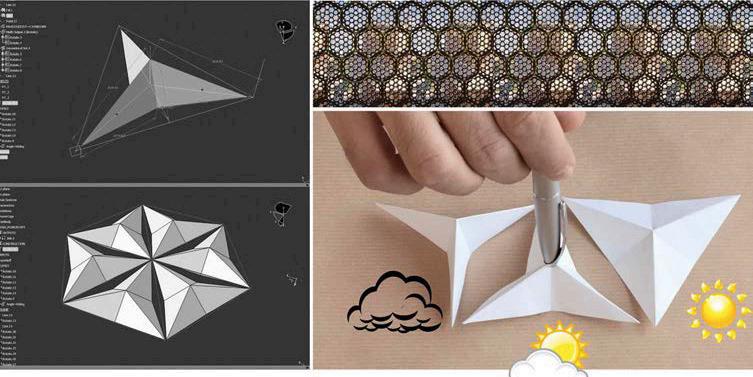
Biology offers the most unparalleled systems of responsiveness and adaptability to draw inspiration. To understand the evolution of one such system, let us look at an example from interactive systems designed from botany inspiration. Botany is found to be a fascinating field for investigating adaptive movements made without muscular support. The responsive motion found in plants is specified into two major categories.
Actuated systems: Systems that have activated pressure cells in the designs.
Passive systems: Systems that are independent of the plant’s trigger mechanism, which is metabolically induced.
Let us look at conifer cones or be more specific at their cone scales, which provides a great example of a passive system. In dry environments, its materiality allows the cone to adjust its moisture content regarding its surroundings.

Figure 1.10Impact on form of conifer cone with respect to surrounding The hygroscopic material system is based on the biological example of the conifer cone
The transition of information in nature also follows a similar theory as an interactive mode of communication. Communication in nature occurs when a signal is encoded and sent by one individual, which affects the behavioural outcome of one or more individuals. These forms of communication happen via different senses, which are touch, gesture, smell, movement, vibration, facial expression, sound, colouration and electrical signals.
Figure 1.8The mashrabiya units are designed to respond to weather changes in the manner of a planet reacting to the environment
This dimensional change in the material activates a transformation in shape in cone scales. This material responsiveness in the conifer cone is reversible. This represents hygroscopic behaviour - change in form and behaviour to attain constant equilibrium between the surrounding environment and its moisture content. During such a process, physical changes occur.
33 32
Conifer cones are regarded as passive, autonomous responsive systems since the actuation energy is derived from the surrounding environment. Based on this biological example of encoded communication or interaction, Steffen Reichert, Oliver David Krieg and Achim Menges developed a hygroscopic material system. The responsive materiality was achieved using a natural material - wood. It was synthesized as a simple, quarter cut fabric and combined with a synthetic fibre-reinforced polymer.
The Hygroscope project represents a new perspective, instrumentalizing the dimensional change of wood to trigger adaptive shape change. The movement of the form is controlled by changing the material-specific parameters such as (1) LengthWidth-Thickness ratio (2) Element geometry (3) Layout of natural and synthetic materials (4) Directionality of Fiber (5) Humidity control during the production process.


Figure 1.11Transformation of membrane from exposure to temperature
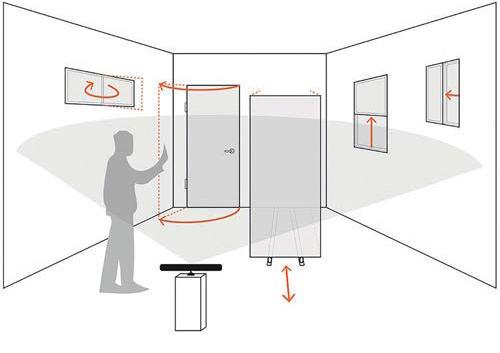
Figure 1.12HygroScope Meteorosensitive Morphology’,Centre Pompidou, Paris, by Achim Menges in collaboration with Steffen Reichert –Materials that respond to changes in humidity without a separate sensing and processing system
Simply put, nature provides us with numerous examples of interactive and adaptive phenomena. Slowly, such interaction phenomena are developed into spatial systems and interactive material environments due to the technological advancements in fabrication and manufacturing.
Technology allows us to expand our parameters in areas of natural adaptation in interactive material systems. In the next part, we will look into the phenomenon of systems to understand how interactions can be encoded into spatial systems.
1.1.3 Phenomenon in Systems
“ System in which the user’s input is processed in real-time. That is, it is compatible with the user’s interactions without experiencing a feeling of “delay”. These systems can be divided into two categories: at the interface and behind the scenes” (Mark 1999).
We usually tend to think about environments as a singular entity. But in a lesser simplification of reality, any built environment is a system of interconnected, physical components that form spatial relationships and structure. A system can also be considered as many interrelated material elements constituting the whole form we perceive. In a communication system, people who perform the interaction and the factors that encode the information include the part of the system. Similarly, in any interactive system, its participants or inhabitants, who perform the activities within the environment, are inherent to its system as much as the elements of the built environment.
A system, in simple words, is an articulated set of elements bound by its designer and inhabitant in structural and functional relationships, which exhibits the system’s spatial behavior.

Another interpretation of the concept of systems and the domain of “system thinking” can be developed from the “General Systems Theory” by Ludwig von Bertallanfy. Systems can be classified into closed and open, depending upon whether the exchange of information and matter can occur or the elements can be added, removed or adapted.
Figure 1.13Evolution of environmental system which is developed from encoding elements with information using gestural control
35 34
The foundation of this contemporary understanding of performance has been led by the domain of cybernetics which would be discussed in the 2nd chapter of the thesis. It defines the system as a continuous action and response cycle of interaction. Since the development of such understanding, systems science has been used to understand phenomena that have high complexity, implying a system comprising a large number of interrelated parts.
Figure 1.16Interrelation between the different factors which lead to development and need of interactive environments

The need for such systems has evolved from the evolved desires of people who communicate which technological systems throughout their day.
In the 21st Century, many transformations through technological changes have taken place, which caused changes in many trades and industries. With such technical systems, the designers have acquired the ability to create interactive spaces that can initiate interaction and movement within a space. Hence, integrating technology and digital media in experience design helps exchange communication and cohesion and allows support interaction. In the next section, we will look at the anatomy of such systems. (Z.E.Sayad, 2017)
With the development of systems based on previous understanding, interactive projects and works by Cedric Price, Nicholas Negroponte, Yona Friedman, Gordon Pask, and Archigram have been treating spatial environments as systems of elements which leads to the evolution of various new possibilities in enhancing the ability of architecture to adapt and interact. The systematic notion of the built form allows encoding the phenomenon of transformation through external action.
With new demands for integrated spatial information based environments, we draw parallels between the natural systems and the build environments to develop a new complex system of interactive environments.


Figure 1.14In Alloplastic Architecture, a performance artist dances with the structure, which reacts to her presence without any actual physical contact
The project demonstrates an open system which comprises of the mechanical system.
Figure 1.15 -
Aegis Hypo-surface (Goulthorpe 2001). The project demonstrates an open system which comprises of the
37 36
1.2 Anatomy of Interactive systems
The anatomy of interactive systems always comprises of three main components:

(1) Input (2) Processing (3) Output
Borrowing from the previous definition of the phenomenon of encoded systems, we understand, “Interaction is a sequential process of thinking, speaking and listening between two or more actors. The following understanding can also be implemented to interactive systems, and they can be broken down into identical stages:
(1) Input - Listening (2) Processing - Thinking (3) OutputSpeaking
Identically, another nomenclature is also used to describe or identify input as sensors and output as actuators in interactive systems. In any interaction cycle, sensors operate or communicate with actuators that activate a vast range of actions - services that alter environments, materials that change their state, or interactive systems that physically alter space.
In design, space is considered a boundless three-dimensional expanse in all objects and inhabitants occupy as relative direction and position (Encyclopedia Britannica, 1998). Every dimensional spectrum is regarded as a space in the perception of an actor, who experiences it within its physical constraints such as time, dimension and gravity.
Figure 1.17Installation - Dynamic Terrain Singular system which respond to input by the user and processes the encoded information to adapt to the user as an output
Figure 1.18Interactive Installation by Studio INI, Urban Imprint. Physical Interactive systems in which transformation of spatial characteristics engage the visitor

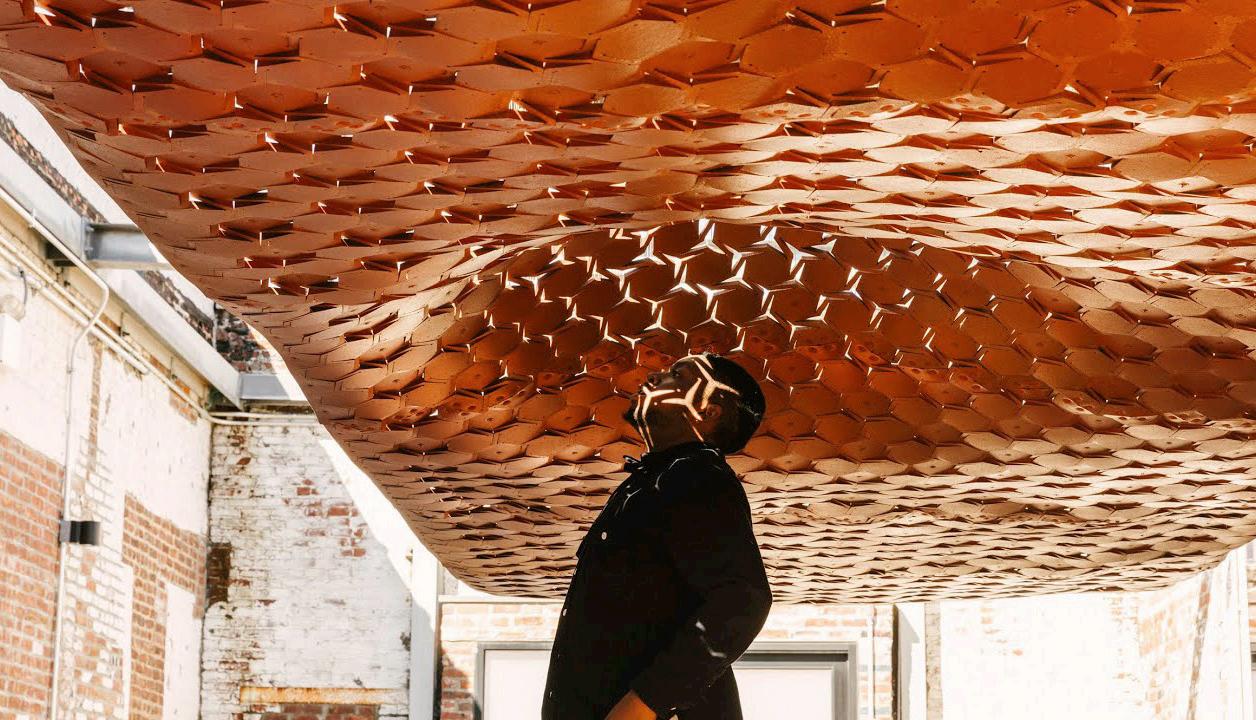
In a physical interactive space, the actor experiences the space directly. The physical factors like speed, location, gravity are constrained within a time-line for the user in the spatial context. When users - indirectly or directly transform the spatial characteristics through interaction, they evaluate and experience the changes or outcome within the relativity of the user’s body to physical parts.

Figure 1.19AR Interaction at Apple Visitor Center The Virtual Reality Installation allows visitor to explore the real scale of Apple’s new office
In virtual interactive space , the physical factors such as gravity, time, speed don’t have any constraints and can adapt into any form and dimension since they are encoded information. In such spaces, users experience and interact with space indirectly to represent him/her whom they can relate to in the context. These representatives have been termed as “Avatars”. These avatars help us engage with the physical constraints of the virtual world. This allows us to experience the interaction, and we relate ourselves to the conditional environment.
The interactive environment always requires an actor either virtually or physically to exchange information or alter the environment.
39 38
1.2.1 Interaction + Digital Space
In virtual interactive spaces, interaction with the environment is experienced by the user’s avatar, a virtual identity.
The primary loop comprises three main constituents for any virtual interactive environment: Input, Processing and Output in the system. (Gu and Wang, 2012). Input in a virtual method is the encoded information it receives as a variable from the user’s action. The Input action could be anything from touching the screen to pressing a button or performing an effort to interact with surroundings as an avatar.
Figure 1.20Interaction with exhibits in a museum experience due to virtual augmented communication.
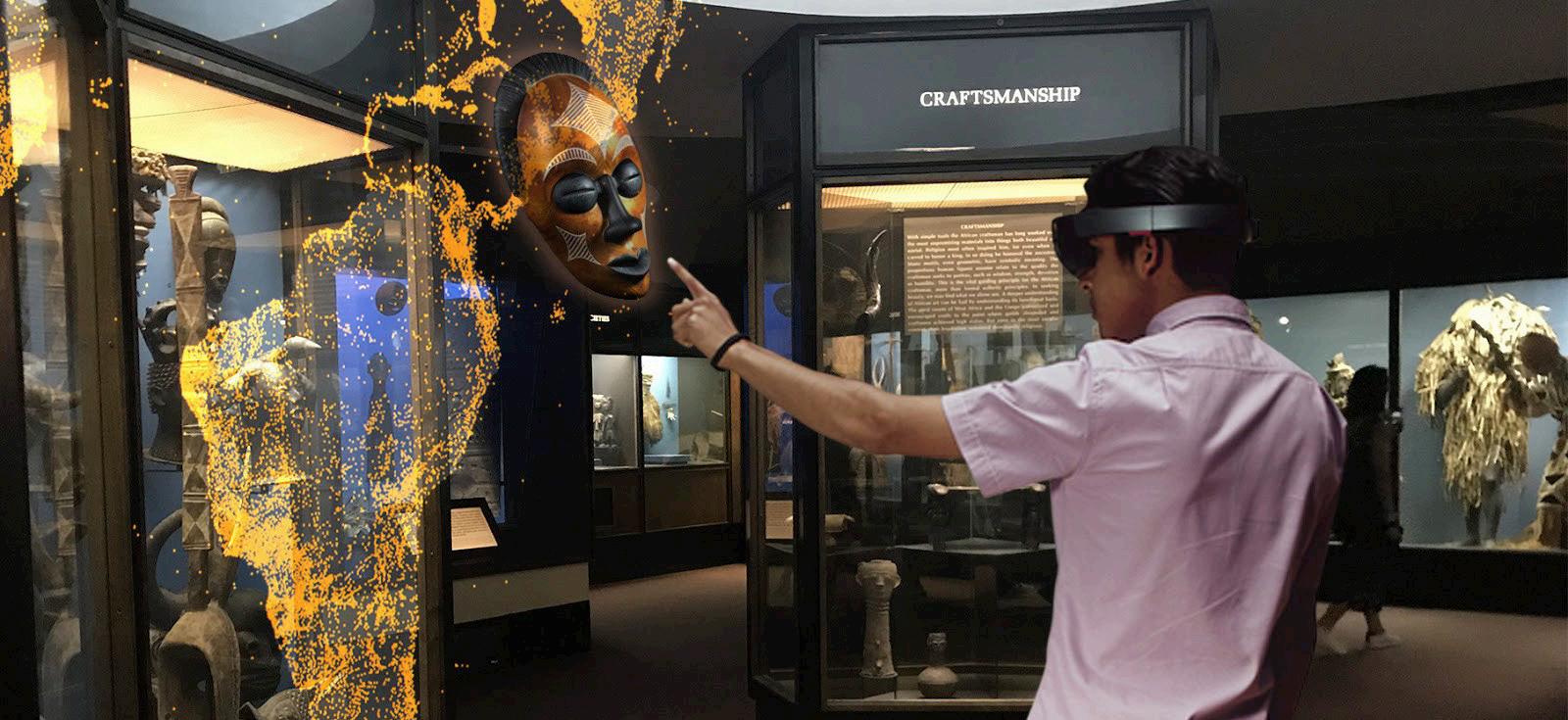
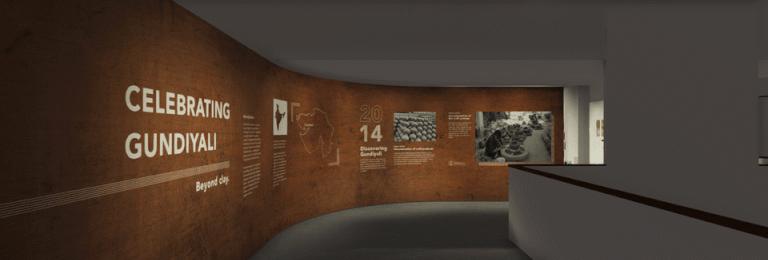
But a virtual environment can only be considered interactive if they respond to the user’s input. This means the ability to navigate through a virtual environment does not ensure its interactive nature. Suppose space imparts a reaction to the movement or user, or it identifies the user’s position in the virtual environment. In that case, space can be specified as an interactive virtual space. Today, one of the most interesting virtual interactive spaces is VR technologies which offer an engaging environment for user interaction.
Figure 1.21Celebrating Gundayali, an interactive virtual exhibition by DICRC, CEPT University Augmented spatial exhibitions designed virtually during COVID for exhibiting research conducted by the group
Virtual simulated environments are utilised in many different ways for educational spaces, interaction-based artistic installations, restaurants or museum interactive exhibits.
The most immersive tools to experience virtual environments are the VR Headsets, which allow users to share a 360-degree view and the ability to move and interact with spaces via controllers. With the emerging technologies, the capability to design neuroscientific technologies such as nanobots soon will be developed by many researchers. These technologies would enable the users to experience and interact with the environment without using any controlling systems or devices but only once brain.

With such significant transitions, the realities or virtual and physical environments are indistinguishable. Such transformation has helped develop merged realities, which have hybrid spatial systems for performance and interaction.

Figure 1.22Immersive spatial experience: Intertwined spatial systems with virtual elements installated as walls in
1.2.2 Interaction + Physical Space
In interactive physical environments, the user’s physical self can interact between themselves and spatial entities.
In interactive physical environments, the user’s physical self can interact between themselves and spatial entities. As discussed in section 1.1.1, one of the first interpretations of designing interactive systems was Cedric Price. His project, The Fun Palace, evolved from the concept of cyberspace and interactive environments. The architect intended to develop a leisure space for the public. In 1963, the cybernetician Gordon Pask was involved in the project. After that, the theory of cybernetics was introduced to architect Cedric Price.
The theory introduces a system in which the user or the participant has a productive and creative role and can manipulate the modules of structural and spatial elements by the use of cranes to develop new combinations of structural systems such
41 40
It was the first time using signals, or human-computer interaction, as a space-making tool.
The theory of cybernetics was a particular promise for the design and architectural field, which led to the development of interactive (or conversational) systems for human interaction (Pask, 1961). The argument by Pask stated that architecture is as meaningful as the natural environment. The architectural design interacts with its inhabitants perpetually, with on-hand it serves the user’s need and, on the other, allows them to control its behaviour (Mathews, 2005). From the 60s until today, the evolution of technology, specifically robotics and computing, the architect and designer have started thinking about spatial performance independently from the structural system. In the development of an interactive physical environment, the design utilises structural elements and visual projections, spatial displays, lighting, and sound to achieve adaptive and responsive capabilities in space.
Designers can further understand this development from an example. The Lobby of Puerta America Hotel, designed by Jean Nouvel, Memory Wall 10, comprises a system of 100’s of LED’s on a spatial wall. The LED’s are encoded to detect the position of guests and the colour of their clothes and recreate the virtual shape of their body (Calderon, 2009).
There are many similar examples of such systems. But all the models have an interactive element overlaid on the spatial component or architectural design, which brings around a query whether the overlay of encoded interaction on spatial aspect suffices the potential of interactive environments.

Figure 1.23Memory Wall 10 by Jean Nouvel
LED system installed as a layer for interactive communication in the spatial wall system
Figure 1.24The Stratus Project Manifestation of the kinetic system as a living envelope to mediate conversation between the atmosphere and the breather
Most of the examples of interactive systems comprise the additional layer of interactive technology over spatial systems. But slowly, with development in kinetic systems, the spatial elements and the structural design also become a part of the interaction.
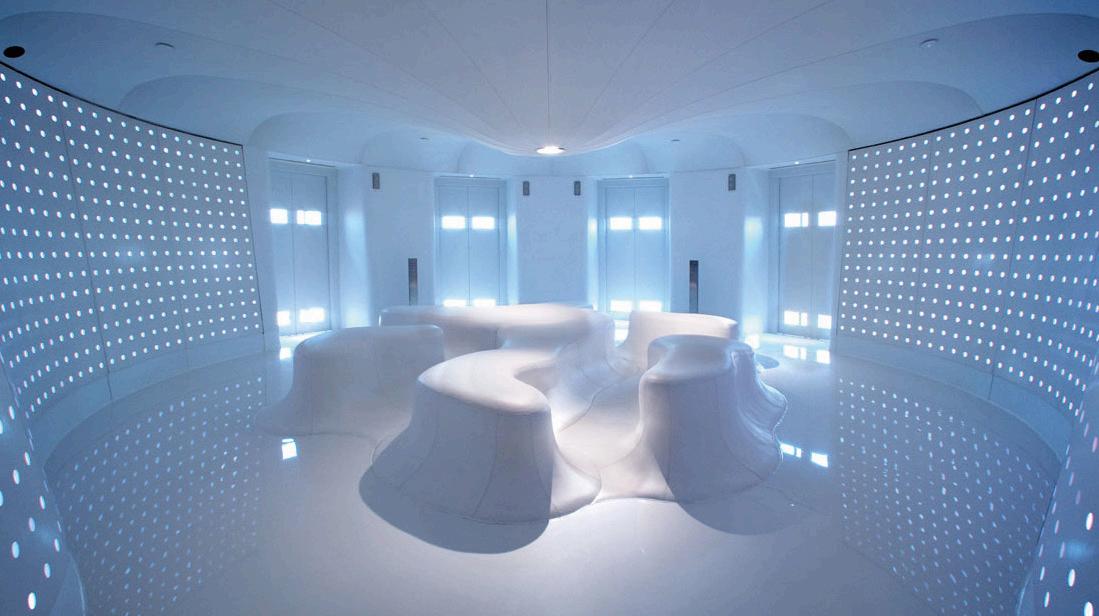
One of the important examples of such systems is the Stratus Project. It is an ongoing design research project investigating the current potential of sensing, kinetic and environmental responsive interior systems. A diverse matrix of sensors, actuators and assemblies are deployed to manifest light and air-based internal design responsive to atmospheric conditions—action or dialogue between the two through the technologically mediated system. The system is embodied from consideration of the envelope, the atmosphere and the breather as three elements of a singular approach.
The evolving technologies have changed the way designers develop interactive systems. In the next chapter, the new mediated environments are further investigated to understand their relationship with technology and impact on user experience.
43 42
45 Multi-Mediated Environments Interaction + Interior Environments Interactive Environment through Actor-Network Theory Interactive Environment from a Cybernetic Perspective [En]Coding through Technology Technology as Tool of Adaptation Technology as Tool for Innovation Application and Operation of Novel Tools and Heuristics [En]Coded Systems + User Experience 02 02
2.0 + Multi-Mediated Environments
The transformation of spatial relationships with users has led to the development of new environments which are various media-induced. Mediated environments are defined as spatial systems induced as a result of media, user experience spatial information in a simulated environment like natural environments. This definition can be further simplified as environments that mediate users’ capabilities with their architectural requirements and needs. This reference is quite different in comparison to the vernacular interior environments that are majorly being designed nowadays.
Such mediated environments reconcile, arbitrate and reconcile insufficiencies in the existing vernacular interior environments and extend its capabilities. These kinds of spatial systems or environments result from the application of technological advancements and evolving needs of the users. The most innovative designs arise from unique narratives and situations emerging in digital age environments. It also offers a substantial economic advantage in applications related to physically disabled and older people and in conditions of adaptive usage and sustainability.
With technological tools becoming cheaper and designers being well informed about such systems, commercial and public spaces also utilise such techniques to improve lifestyle and productivity.
Figure 2.1Different realities which impact the interactive environments Intertwined realities impact the spatial perception of user.

Figure 2.2The Virtuality Continuum

The transformation of realities induce another dimensions or perception in the space for the user.
2.1 Interaction + Interior Environments
With the tremendously fast development of interactive architecture due to technological advancements, the interior environments transformed their approach and design. This transition of technologically built environments enabled the silent activities performed by the users in space to become the priority and program of spatial systems, and users transitioned to being the participants of space.
The new approach, called the embedded computation , has allowed architecture to become increasingly adaptive and intelligent. As it gets more and more innovative daily due to technological advancements, it becomes interactive, and it gains agency. The interior environments currently are not capable of adapting to the transforming conditions. Still, they can process information from encoded spatial systems, stimulate a reaction, observe the participants’ movement, and learn. The spaces can also communicate with participants and other spatial systems and make spontaneous decisions.
Agency can be defined as the capability or capacity of an actor to perform or act on the world. It is necessary to define and clarify the distinction between the two major contributors of interactive architecture (Maia, 2016).
Architectural Agency: In an architectural agency, the architectural system should have its own internal goals and objectives. It should have the capability to pursue these goals, and designers may not necessarily align these goals with the interests and goals of the inhabitants.
47 46
Inhabitant Agency: In inhabitant agency, the focus remains on how the environment enables people to accomplish their interests and goals.
In the interactive interior systems, the focus on an agency is based on interpretation of encoded input information, such as the user’s actions, reaction to spatial system or agency, information from the other actors and environment, and adapting its performance the input information.
Due to this, Interactive interior environments become active in participation in social relationships. It communicates with the users and learns, implies different interaction methods, and makes informed decisions, adapting to the mediators in the environment. The interactivity of a system means that both the people and the buildings have an agency, which enables a conversation between the two entities. The significant difference between responsive systems and interactive systems is the importance of agency.
Figure 2.3Interconnection between the Agents and Interactive environment
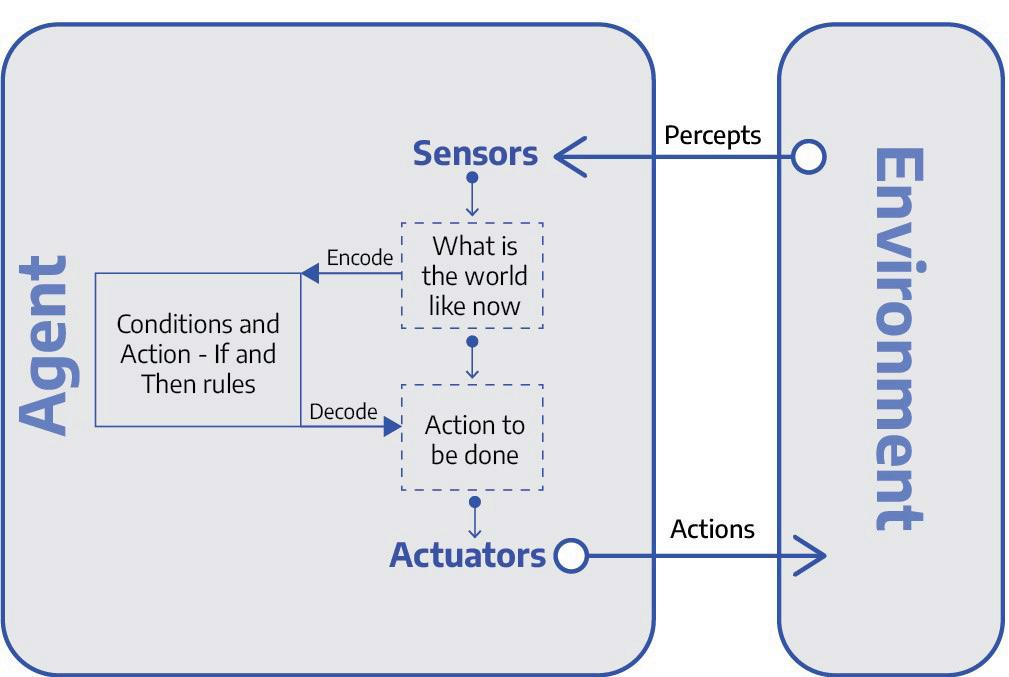
As specified in the first chapter, Interactivity essentially means that a dialogue occurs between space and forces/ user/ environment where both entities have an agency that enables a multi-loop real-time conversation.
In a responsive environment, the spatial system gathers encoded information and responds but does not have an agency. We look at the interactive nature of spatial environments through two significant theories to understand their different perspectives.
2.1.1 Interactive environment through Actor-Network
Theory
Analysing interactive architecture through the social lens helps define its interaction with users and calls attention to the qualities which enable the interactive behaviour. By looking at interactive environments through actor-network theory, one can decipher how interaction articulates bi-directional communication between the intelligent spaces and society, which influences a change in perception of space for users.
A static interior environment performs a single pre-defined function. In contrast, interactive space accommodates different behaviours, which improves its social and functional performance, allowing other groups to interact with it in different ways or modes of communication. Instead of simply facilitating a function for the user occurring inside, the spatial environment becomes the participant in the event happening. With this understanding developed from part one of this thesis, the agency of interactivity can be referred to as the mind or the soul of experiential space. (Wiener, 1948).

Figure 2.4The flow of communication between interactive systems and the technologies.
It becomes frozen or dormant without the capability of communication or adaptation through digital and kinetic transformation. With the help of an agency, the interactive environment obtains the ability to perform and becomes active and lively.
The interactive spatial environments provide space for performative activities and lifestyle; it becomes an active influencer to change communication medium. Metaphorically, it acts as a mirror that reflects the behaviour of its participants, society and environmental factors. It also becomes a window to a new experience, highlighting how space performs and acts on one’s encoded modes. Or it also can be seen as a double-sided mirror that allows an interactive environment to perceive the behaviour and action of users and adapt to following them.
49 48
This interactive environment role in a social relationship is addressed through the Actor-Network Theory (ANT). ANT identifies the relationship between interactive spaces and people as a system that accommodates human and nonhuman origins, in which all the elements are society shaping and socially developed. All factors that comprise the system interact with one another and subsequently contribute to a common goal of the system.
Figure 2.5 -
The articulated and interrelated network between the human and non - human actors in interactive environments.


In the context of interactive environments, the non-human components are represented by the adaptive spatial backgrounds, elements that have an agency, experiences that form a network, or a system that facilitates social communication. Thomas P. Hughes explains that the non - human components are usually directed towards the problem-solving functions. In contrast, the role of human elements remains as contributors of feedback to authenticate a connection between the performances and the system’s goals, which subsequently sets its agency and shapes its behaviour.
Figure 2.6 -
The Conventions on Control interactive installation by Ally Polancic and Michael Fox which highlight the significance of human actors as contributors to the feedback loop.
Figure 2.7A cybernetic loop
The degree of actors autonomy in the system relies on the complexity of the interactive element and the final goal, which differ from one case to another.
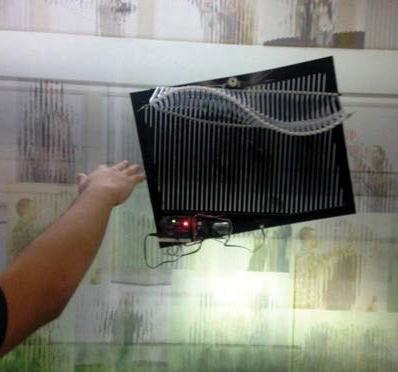

In interactive spaces, the agency in social relationships can be defined with ANT theory since it introduces an amalgamation of human and non-human members in a relationship. Therefore all the actors influence one another. The interactive space and the users constitute one complete social network in which they are invariably aware of each other, establishing a constant bidirectional communication.
2.1.2 Interactive environment from a cybernetic perspective
Since the initial development of interactive environments as a field, the representation of a new world in which the built environment has evolved alongside the futuristic society to adapt to new social and functional roles has influenced the imagination of designers. Two reasons explain this expectation or vision. It has been noticed that technology carries the potential to mobilise massive cultural transformation. An interactive environment can impact the built environment capabilities, which otherwise developed at a conservative pace.
From the cybernetic perspective, designers can acknowledge the thought of interactive agency even more thoroughly. Presuming that every interactive spatial system is expected to have an internal goal, without which encoded feedback conversations are not plausible, every single interactive spatial system henceforth also displays some level of intrinsic agency, without considering whether it involves complete intelligence or autonomy in the system. Thus, if every spatial element can exhibit outside agency, every interactive environment system can also develop the capability to display intrinsic agency.
51 50
The interactive environment’s initial connection to the issue of inhabitant agency is clarified by its establishment in the theory of cybernetics. Gordon Pask established the importance of underspecification, system design and feedback in interactive cybernetic systems. With the help of systems thinking, the interactive design allows the spatial elements to become components that empower the environment by integrating the participant or user as a part of a larger control loop.
Pask asserts that in designing an interactive environment, the designer does not hold the authority or control over the outcome of the final product.
Figure 2.8A simple goal focused and directed system by Gordon Pask
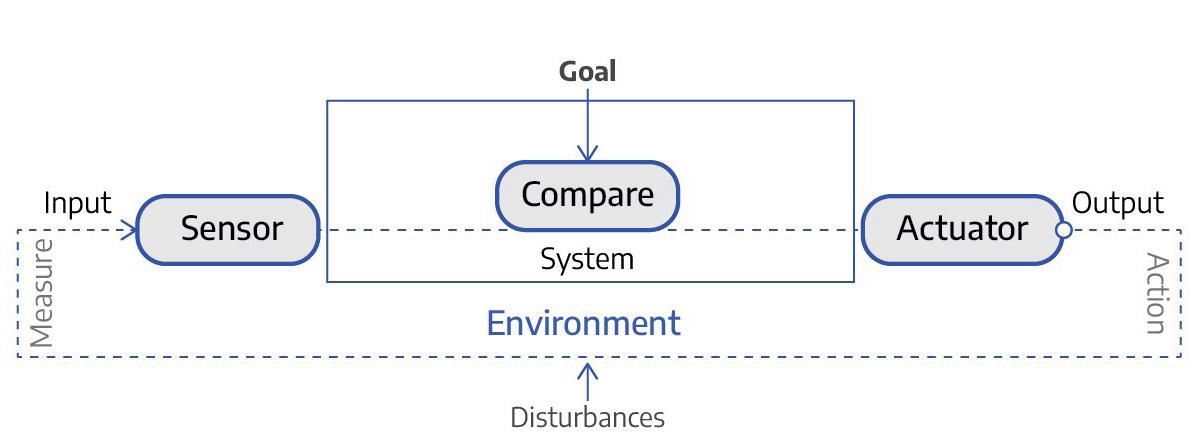

He explains that in a truly interactive environment, the users should be allowed to take a bottom-up role to configure their surroundings in an adaptable way. Many authors such as Usman Haque (2007) and Nicholas Negroponte (1975) have identified interactive systems or encoded spatial environments as a medium of freeing the users from the rigid language of the designer and instead of providing the users with an agency and responsiveness.
Immense discussion around the relationship between participatory design and spatial environment since the 1960s provides evidence that who should control the development of performative spaces in a built environment has been an essential concern. Shifting focus from understanding the anticipatory demands towards exploring the inhabitant's agency and empowerment has become an answer to the immediate challenges faced by the designers, which has helped the development of the field of interactive environmental design.
First Order Cybernetics
“ [A] building cannot be viewed simply in isolation. It is only meaningful as a human environment. It perpetually interacts with its inhabitants, on the one hand serving them and on the other hand controlling their behavior. In other words structures make sense as parts of larger systems that include human components and the architect is primarily concerned with these larger systems; they (not just the bricks and mortar part) are what the architect designs.”
– Gordon Pask
Decades before Gordon Pask and Cedric Price, the term “Cybernetics” was explained by Norbert Wiener in the early 1940s as the science of control and communication in the machine and the animal, mechanisms and organisms. Cybernetics as a field eventually started to evolve, into as it is now known, 20 years after it embraced the idea of artificial intelligence and cognitive science with relation to communication networks and information of the post-industrial world.
Figure 2.9The cybernetic loop of First Order
During the early 1940s, Wiener also suggested that the difference between machine and living organisms should be neglected, which arises from the fact that both entities should be identified as automated machines, which means controlling entropy through feedback. In simple words, it means that both the entities learn from their experiences and correct their future behaviour from learnings of previous operations.
53 52
Second-order Cybernetics
In the second order, the systematic order is not maintained in the way that it was in the first order, which is by interacting with the environment, but by keeping the system in a closed-loop and autonomous. This order helped gain an insight into emergence, self-organisation, conversational interaction and learning into the technical methods, which are either social, artificial or biological.
Third-order Cybernetics
Application of the second-order cybernetics to explain the operation of social systems had become a common approach. The social system was displayed by the concept of autopsies, which Maturana and Varela pitched. It states that generally, applying the biological principles on the various social structures does not allow the designer to address the individual elements as the system components directly. As a result of this point of view, many theories started to emerge that could not explain how individual designers reproduce social structures and reproduce the notion of social reality.
The subject of cognition became the bridge that united the social system and automated systems because the former is the product of socialisation. The latter is the capability of the system, which is the outcome of cognition. Maturana (2012) identified cognitive systems as the element whose arrangement defined the field of user interactions. It can act and adapt with self-awareness and maintenance.
Figure 2.10A cybernetic loop of Second Order.
The living systems can be identified as cognitive systems, and the process of living can be deduced as cognition. This fact is actual and legitimate for all organisms, irrespective of the presence of the nervous system.
In consideration of the facts above, cognition can be defined as encoding and decoding information produced by an autopoietic system during its interaction with its surroundings to adapt and sustain itself. This is identified as lower cognition. The designer can distinguish the interaction that a system can have into three significant sets of degrees, in which each one is contained in the one preceding it.

Cognitive domain: it includes all the interaction that a living organism has and can be intensified with the addition of new models of interaction.
Domain of interaction: an assemblage of interactions in which a user can participate in a system.
Domain of relations: an assemblage of interactions from the viewer’s point of vision in which interaction or a system can be observed.
A viewer or an observer can be defined as a being representing their domain of interactions and can choose to remain as a spectator if they treat all their interactions as individual and independent entities. The transition between the lower cognition (by understanding second-order cybernetics) and the cognitive process of human beings (object of study leading to the fourthorder of cybernetics) will be identified as higher cognition is self-consciousness. Hence, if a system becomes wholly selfconscious and develops the capability to observe itself, it becomes independent to establish its goal, modulated from the interaction with the surrounding atmosphere. Any adaptive system, unlike many cognitive systems, is teleological.
The phenomena of self-consciousness are concordant, triggered by the autonomous domain of communication and interactions from a self-orienting behaviour. This phenomenon lies in the semantic environment and requires two entities that interact with indistinguishable interactions.
55 54
2.1 [En]Coding through Technology
As previously discussed in the first part of the thesis, technology has been one of the major drivers to influence the development of interactive spaces as a new paradigm shift in interior design and architecture, and the evolution of technology and the pace it will be determinants to the future progress of the field of interactive design in spaces.

Technology as a tool aids in addressing issues or fulfilling requirements in spatial environments which otherwise are not achievable through space elements and designers effort. An interactive system in space comprises many such embedded technological elements that may be visible or concealed in the spatial aspects of the environment. It is necessary to understand the role and importance of each of these elements since they play a significant role in encoding and decoding conversations for an interactive system.
Input technology
In the physical computing world, we are introduced to input technology as a medium to communicate with the desktop or computer to input a command. These technologies are usually constrained to the mouse and keyboard.
But when the concepts of computing or encoding move beyond the physical computer, the type of input technologies become more sophisticated and varied. However, each of them still shares one crucial purpose: enabling or creating a medium of communication between the interactive computing system and the surrounding environment.


Figure 2.11Lightswarm from Future Cities Lab - Installation placed in the public Lobby of YBCA allows visitors to participate in an interaction with the interior of the space. The Installation responds to the sounds around and intimidates people to visit the center.
Figure 2.12Adaptive Pavilion in Interactive Design Studio by Micheal Fox.
Input technologies enable the system to create a perception of the environment. Input technologies can be grouped into four major categories: sensors, actuators, tangible computing, cameras. In interactive design, the usage of these terms is often done interchangeably or loosely. Thus it is essential to define specific terms for reference in further chapters carefully.
• Sensors -

The term sensor is derived from the english word sense, which means to perceive the presence or assess the properties of entities. A sensor can be defined as a device that detects or reacts to a chemical or physical stimuli. Sensors have the capability to directly interact with fields of stimulus. Sensors are the technological components for the quantitative and qualitative measurement of specific properties or values such as light, sound, humidity, movement, pressure, force, etc.
Departments such as mechanical and electrical engineering develop sensors using the MEMS technology which can perform functions at micro or macro scale. There are various types of sensors which are utilised in interactive environments. They can be understood and segregated by identifying the different types of energy which they utilise perform their functions - thermal, magnetic, electrical, radiant, chemical or mechanical.
Some of the macro scale sensors are microphones, RFID, infrared sensor, touch or weight sensor. An example of a micro sensor, the Smartdust. Sensors can also be segregated on basis of their expected usage, eg. sound sensors or proximity sensors.
57 56
•
Actuator -
In actuators, an action is produced from one type to another due to an external stimulus in an input signal. In sensors, the external stimulation induces an output signal, usually in the form of a high voltage. The signal is utilised to control other systematic elements or system’s behaviour. In many interactive systems, the same devices can be used in the role of a sensor and adapted, pertaining to the need, to serve as an actuator.
• Tangible computing -
The tangible user interfaces utilise surfaces, spaces and physical objects as a tangible embodiment for digital information. This kind of format includes the interaction of augmented spatial characters and graspable objects, which explores and exploits the concept of human senses of kinaesthesia and touch. There is also abundant exploration to utilise unique systems as information displays that use ambient media – airflow, sound, water movement and ambient light. The designer intends to seek communication with the digitallymediated senses of presence and activity at the peripheral end of human awareness. (Ulmer and Ishii, 1997)
Figure 2.13Light Touch Pavilion by Ruari Glynn which highlights the transparency and volume in the space using interactive lights.
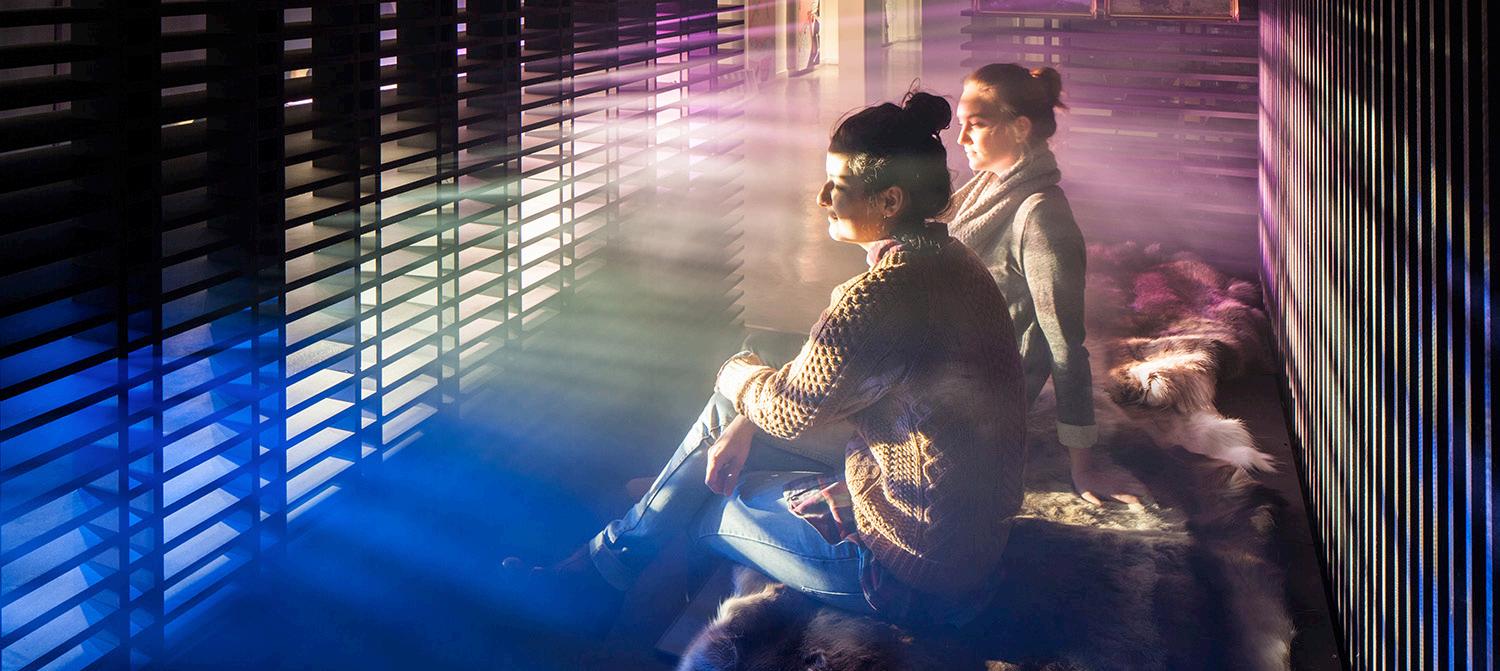

Figure 2.14The Camera sensors visually analyses patterns, movement and surrounding.
• Camera -
The innovative camera-based system is designed in computer science engineering for the concept of computer vision. The idea of computer vision can be explained as the analysis of various images from all around the world to extract information about a particular topic. The concept of computer vision enables the interactive technological system to visually understand and respond to the surrounding environment similarly to humans.
Output technology

Output technologies can be classified into two major categories – virtual or display based and kinetic or moving-based systems. Major interventions that are interactive usually rely on virtual systems such as displayed for their primary form of communication as output.
To select an appropriate technology for display, many different aspects are considered: durability, lighting condition, and the relationship between the graphics resolution and the scale of the interactive system. Physical adaptation of the interactive system allows it to necessitate kinetic movements for various applications at various scales. Kinetics can be defined as transformable objects which can dynamically occupy a physical space or multiple configurations.
Kinetics provide interactive systems with the ability to not only monitoring but also being able to physically control the environment, which has critical applications and implications to developing the innovative design. This provides interactive systems with excellent potential for dynamic spatial structure, which arises from an in-depth understanding of what an object or space is currently doing and how it can transform to accommodate or promote specific tasks for users.
59 58
Processing -

Output and input are the physical parts of an interactive system; Processing is the main phenomena where all the thinking and understanding happens. Processing requires a system of itself to read the input, interpret the readings, decide, and initiate communication or activates and output. Processing is the phenomenon that helps determine whether the dynamic system is categorised as (1) linear (2) self-regulating (3) learning system (Dubberly, Pangaro et al., 2009).
The automated and the learning systems respectively follow the first order and second-order cybernetic system. This understanding implies that any interactive system devised either as a learning system or an automated one gains the ability to transform its goals in response to external actions. A human being can be seen as an example of a learning system, and his/ her behaviour is an ideal inspiration for interactive systems.
In interaction design, a linear system can be defined as a cybernetic system of zero-order that upholds the feedback loop’s archetypical arrangement. However, when such a system is coupled with a human, the results can be observed as a first-order cybernetic system since the human, the learning system itself modifies their goals from the information given by the linear system.
In simple words, It can be said that the information flows from the system, via the person and then back through the initial system again. The human being has a goal, for which he or she acts (input to the system) to achieve the goal in the experiential environment. They understand the impact or the effect of their action on the experiential environment (interprets the output yielded from the system’s feedback) and finally compares the result with their personal goals.
This comparison (yielding congruence or difference) becomes the directive for the human’s following action, which begins another cycle (Dubberly, Pangaro et al., 2009). However, in the actual practice, few interventions resemble the zero-order system where the person and the design are employed in a reactive loop. Both are regarded as linear systems.

2.2.1 Technology as Tool of Adaptation
New needs have arisen today, requiring traditional kinetic aesthetics of the spatial environment to be reevaluated using the latest technological innovations. The old conventional issues concerning the order, motion and stasis henceforth can be redefined, transformed and challenged by the recent innovations as new technologies open up various new opportunities to develop strategies, particularly the new approaches and technologies related to the mobility of the nomadic culture.
The driving force of this change is in the technology, which influences the changing pattern of human communication or interaction with the spatial built environment. The new mobile technologies have enabled an increase in self- sufficiencies, which has led to the rise of nomadic behaviour and tendencies. The built environment has lost its specificity as established by the specific spatial description of programmatic requirements. The traditional building systems are now shifting and adapting to respond to the technologically mediated social needs. With response and adaptation to social mobility, the different typologies have started to blend and can be interchanged.
61 60
Figure 2.15Campus of Justice, Appeal Courts by Hoberman Associates and Foster + Partners with interactive roof which adapts to the environmental setting to provide comfort.
The focus has shifted towards developing a universal type of space, one with a very mobile technological relationship that can bring about many distant typologies of administration, education, servicing and a few aspects of communication, entertainment and production. In simple words, adaptability can be defined as the ability of the space to be flexible enough so that it can accommodate the changing demands of the spatial system concerning its users. In most of the projects that have been developed until now, adaptability is utilised as an ability of the system structurally to transform its geometry to accommodate different types of activities in the same space.
Adaptability, in such built projects, is either embedded into the logic of creating the spatial systems or embedded into the sense of kinematics. As previously discussed, kinetics refers to the physical ability to provide the intrinsic potential for the spatial element transformation, but it does not necessarily imply any means of user interaction.
It is necessary to have a simultaneous encoded conversation in a truly adaptive and interactive system through embedded computation with the physical change. Only then interactive adaptability is possible.
The difference between the adaptable spaces analysed in this thesis and the older models of flexible spaces is the difference of some level of interaction. The previously developed projects have relied on the user’s effort to manipulate the geometry of elements of space by physically changing the colour, size, location or shape of the component which makes the space.

Figure 2.16Scents of space, an olfactory experience which gives life like qualities to the space designed by Usman Haque
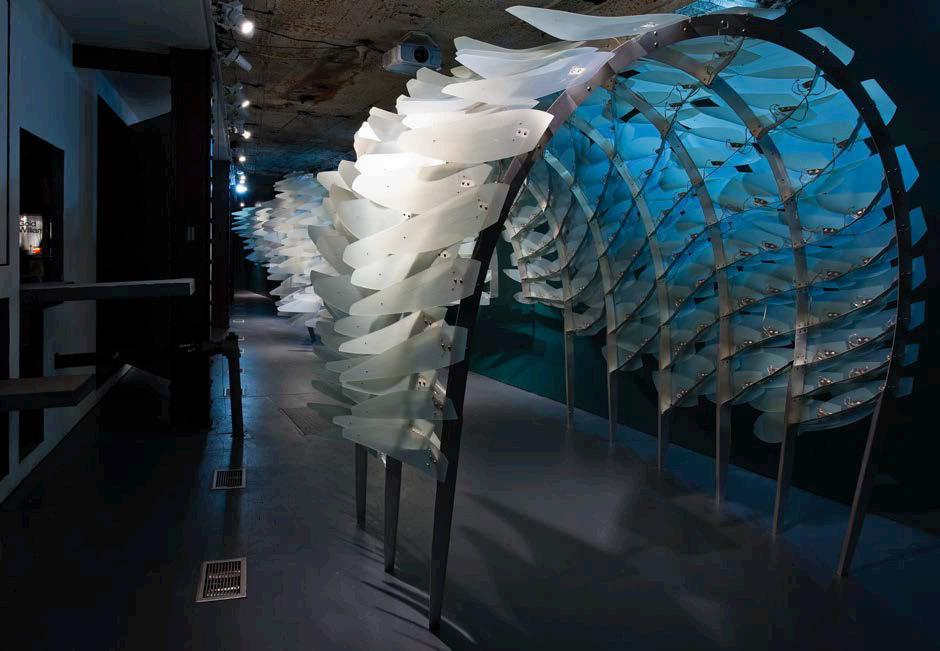
Figure 2.17The Reef by Rob Ley Studio comprises of many responsive surfacial elements made of nitinol which is a shape memory alloy

Such projects were adaptable since they could transform concerning the new requirements or demands of the system, but not very interactive how the sense of the objects can sense the user’s information or the environments information to which it further adapts itself.
Figure 2.18The Reef re-defines the role of an envelope designed for the spaces by imbuing space with behavioral qualities using material technology.
The new embedded computational methods and technological advancement have transformed how interactivity is encoded into spatial environments. Only with the help of technology can designers explore the scope of innovation in interactive interior systems.
63 62
2.2.2 Technology as Tool of Innovation
The general definition for the term innovation is that it introduces new changes to the product, methods or services in which the differences are helpful, meaningful, and adds new values to the Initially established norms and contribute to people’s knowledge. Technological changes and innovation have remained complementary because innovation critically relies on new scientific and technological developments.
The usage of the term innovation from the 1700s till today makes it evident that it has coincided with the significant eras of technological developments, such as the information revolution or the industrial revolution. The previous few decades have experienced unprecedented technological, economic, and social changes. Innovation has become essential and critical to various fields among information technology, transport, medicine, design, and engineering.
Since the past few years, the developments in the field of interactive spatial design have been progressing at a very rapid pace, and the best way to understand the innovative factor and predict the future influences is to understand what is being unfolded around us today. Many areas significantly influence the field. These fields include material, biomimetics, technology transfer in interface design, evolutionary systems and autonomous robots.
The technological transfer from developments in the other field will impact the interactive built environment and help it evolve.
Figure 2.19The Living Breathing Wall is a very successful example of how empowered sense of embodiment is experienced by user with help of encoded remote sensing device.


Figure 2.20The interactive systems of Living Breathing wall compromises of three layers which have an amalgamation of embedded sensors and Fabric on wooden box. These together facilitate kinetic interactive movements.

Designing interactive systems is not inventing but appreciating the usage of technology and the opportunity it provides and extrapolating it to adapt to futuristic systematic interior vision is innovative.
Figure 2.21Epiphyte Chamber is an interactive installation which create a series of interconnected and intimate spaces and visitors experience a sense of breathing in space
The recent developments in the field of interface design, in due course, will aid in designing interactive environments. The area of interface design is tied to the manufacturing and sensor innovation, which provides the future vision of availability of unimaginable means of gathering information and data which were previously unavailable, which can aid in developing intangible forms of spatial interaction such as brainwave or gesture recognition.
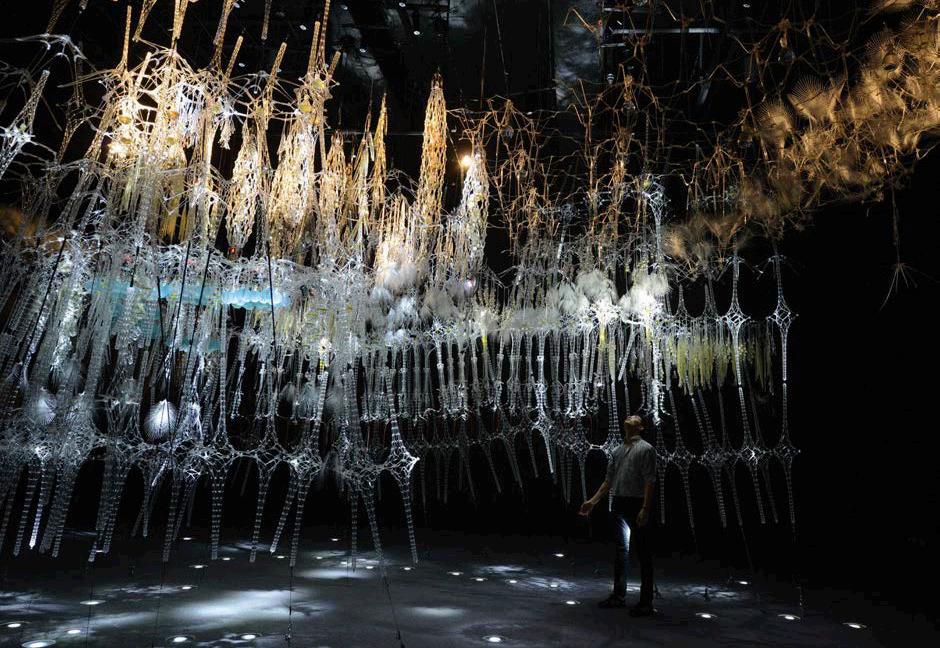
65 64
The field of kinetics, in interactive design, is currently undergoing a process of redefining through innovation in robotics. The current ongoing trends in designing autonomous robotic systems are setting new criteria for the capability of intelligent objects to function together to accomplish adapting and changing goals. In terms of design, Though the ongoing advancements in robotics, the scale of interactive systems will be heavily influenced by the innovation in biomimetics and material science. The future of interactive systems in the built environment will essentially involve adjusting and re-examining the scale of materials utilised before.
With innovation, the physical robotic elements are scaling down, due to which it is becoming necessary to integrate intelligence of the system objects into the form of the system itself. In the future, interior designers will require two concurrently develop the connection, movement, embedded intelligence and geometry of such intelligent objects. Technology has transformed into a tool of innovation. We see as the beginning of the end of mechanics has become a new foresight into the intelligence of interactive systems. With the help of evolving technologies, the scale will play a critical role in innovating spatially interactive environments.
Figure 2.22This design emerged from a series called Hylozoic series by Philip Beesley which combine responsive mechanisms and light-weight structures.

Figure 2.23The Research group. Machine Agency design their own maker’s tools to reflect upon the individual’s agency in design.
2.3 Application and Operation of Novel Tools and Heuristics



An increase in the number of new types of methods and tools for exploration and experimentation has impacted the way designers build and develop interactive environments and test prototypes in the field. Many manufacturing tools such as laser cutting, computer numerical control (CNC), three-dimensional printing, and vacuum forming have also made it possible to design and fabricate parts for experimentation more quickly, cheaply, and precisely. In recent times, these tools have become very rapidly more sophisticated and increasingly common to utilise.
These technologies or tools have a decisive advantage over the manually used manufacturing technologies since they allow designers to build actual size three-dimensional models in computer software and then fabricate the elements of parts directly from these computer models. This kind of methodology is blurring the line between creating fundamental types of objects from the simulation data and developing digital simulator experiments. New testing methods enable the designers to provide a real-time response or feedback during the prototyping or performing experiments.
The usage of these tools with real-time feedback for the optimum utilisation of prototyping behaviour greatly benefits design. It has an efficient and productive effect on the outcome. The new computational tools hugely impact the new design process in terms of both generative design and simulation. All of these methodologies and technologies affect the way that we test, learn and construct.
67 66
In the last 15 years, the increase in the number of digital and physical manufacturing tools used in the automotive, mechanical, jewellery, airline, and various industries has been implemented by the designers to efficiently prototype elements and parts and production systems.
Various design schools are adopting these newly transformative tools of design fabrication and developing subjects around them to discover their potential in the field of design. Computer numerical controlled machines, for example, have entirely changed the manufacturing industry in the past years. CNC is a reference to the computer control, which is the driver of the machine tool. The importance of all these technologically advanced tools for the field of the interactive built environment lies in the development and progress of the design process instead of the fabrication process of the system.
The capability to rapidly prototype and recreate parts of a system with accurate and extreme precision enables CNC manufacturing to significantly influence designing three-dimensional complex parts whether there are embedded intelligent features or physically moving kinetic parts.
The process of rapid prototyping also shows a great success in different typology of automatic fabrication which works on the principle of material addition rather than subtraction.


All these different types of manufacturing tools and processes have offered profound benefits to create inexpensive prototypes at a fast pace, but in the field of interactive design, it is very necessary to determine the goal of the test before implying a specific technology to develop the system’s parts.
Figure 2.24The interactive visual partition is design in the Microsoft Gallery to entice visitors to interact with the surroundings.
Figure 2.25The mechanical components of the interactive wall.
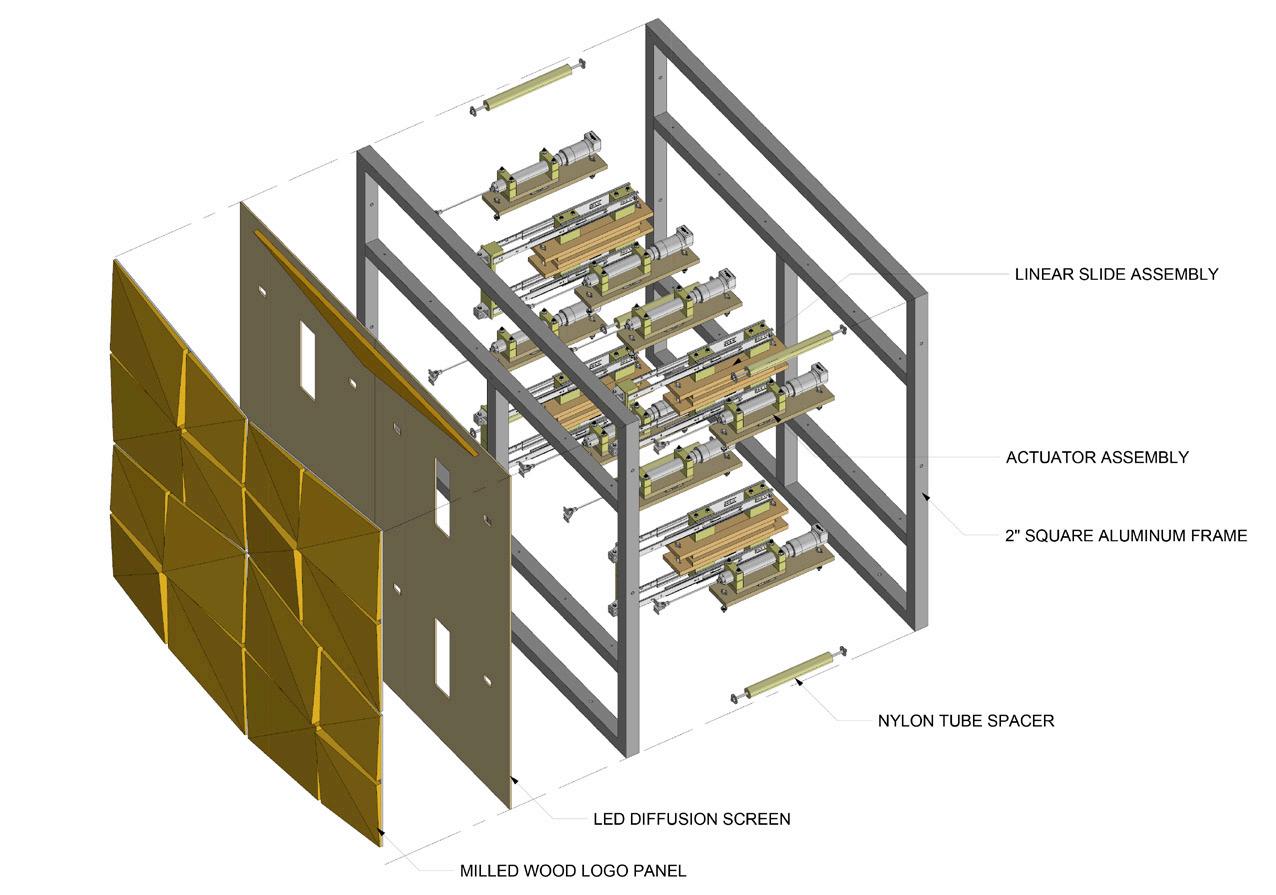
For example, to develop an interactive system in which identified human gestures and their potential could be intertwined to create adaptive furniture in a spatial environment, it is necessary to consider the broad range of testing rather than one specific test. In testing the prototype that is relative to dynamic environments, It is crucial to perform multiple examinations that look towards the area of activities or different input sets rather than just the tests or specific moments.
In such cases, results of a specific topic can disrupt the findings and mislead due to the absence of the context of other tests that support and validate the results in a complete and collective whole. It is necessary to understand that such tools require specialised and well-trained personnel to operate them in case of such situations.It is already visible that fascination has developed into the architectural profession for the CNC machinery in the professional and academic world by the major manufacturers. Designers have developed relationships with engineers to create particular designs (Lawson, 2005).
Figure 2.26The system created as an insertion in the space but the visitors perceive it as a living element of space making the environment lively and interactive.
69 68
The integration of such computational tools, such as real-time simulations created by 3-D modelling software and physical testing of the different parts and elements during designing, allows the designer to anticipate and confront issues that could occur during the completion of the built environment.

Knowledge through the real-time test gives designers valuable insight into how they can allow real-world factors to apply to the previously developed ideas as computer-generated models.
The generative design process looks at how designers can utilise computation tools to generate innovative solutions. The genetic algorithms are frequently used in the spatial design: the shape grammars Or a particular class of computational systems that create a range of geometric shapes.
This methodology is fascinating since it allows the designers to see the visual computation of design through shapes. This ideology brings a critical point, with the application of such tools in the professional world of design, the designer’s role is being repositioned. Pask argues that the role of an architect or a designer is not so much to design a specific built environment or system but to catalyse them, perform actions as they evolve (Pask, 1995).
In simpler words, degenerative simulations replace simple design decisions since the designers utilise the software‘s to experiment with new forms rather than specifically designing them. Due to the evolution of design methods, the designer now must play the role of decision making at a certain point.
Claude Lévi-Strauss explains that designers work inventively with the information already available in their minds to solve the problems. It implies that the designers develop concepts and make fair comparisons to satisfy their cognitive constraints. LéviStrauss also claims that human beings cannot create something unique; it is at best the capability of humans to create specific combinations from the dearth of ideas that they can reconstitute (Strauss, 1966).
People with creative thoughts defend such statements. There might be a restricted number of cognitive symbols, but the amount of creation and invention generated from it is practically unlimited. Furthermore, a structure is not fundamentally static by definition.
The significant application of understanding such structures provides the designers with the capability to find solutions to challenging issues in the design process, most notably in how they decide right from wrong. In such scenarios, the symbolic process allows the designers to make critical decisions in exploring the evolutionary designs. Suppose the designers play an essential role in directing the evolution of technology that affects interactive design. In that case, it is necessary that they question the importance of innovation through the lens of computation and not the inverse.
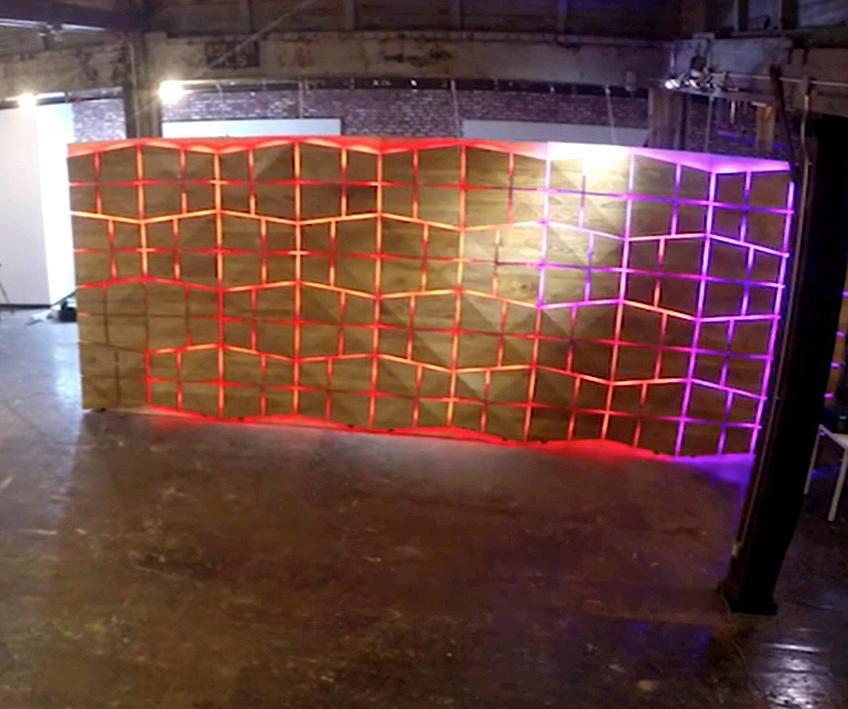
Figure 2.27Designers working on the materiality, mechanisms encoded interactions in collaboration to design the wall.
It is essential here that the designers understand the rules of personal tool making and decision making with the development process of tools developing with design. When designing with such devices, the heuristics and the designing process are mediated through the limitations and affordances of the tools. But when these tools evolve with designing, heuristics are facilitated by these tools and not compulsorily limited by their parameters.
The design processes associated with the interactive system design are continuously transforming and are promoted by the resultant development and evolution of new tools and techniques.
When the design tools are acknowledged and understandably utilised as flexible entities (in case any issue arises or a mental limitation occurs, a new and improved tool is created to transcend the constraints or solve the problem), the application in constructions of these new tools then become undeniable and substantial heuristics.
71 70
2.4 [En]Coded Systems + User Experience
With encoded systems, the possibility of remote communication with the built form has an intriguing effect on social interactions.
Communication is considered a collaborative active behaviour between many participants, whereas coexistence phenomena are more subconscious, subtle and passive.
In simple terms, the state in which more than two people live together and solve their issues non-violently is politically called coexistence. There is a requirement of more than one person in a digital or physical space and the capability of recognising the other person but does not require the two people to interact and react in a conventional sense for the experience of coexistence to be endured.
In a spatial, physical environment, It is only required for the person to exist with the others to accomplish the sense of coexisting (Santo, Lam, 2004).
According to the designer, Yasu Santo, There are multiple different ways in which humans can be physically present in their everyday context, and they can experience mood off the previously considered virtual reality as the new down to earth everyday reality.
This kind of approach radically reframes the ideology in which any building is viewed and how physical environments play a role in shaping the user’s experience.
The need for interactive spatial environments originated from the new requirements of the 21st century. With the need to understand digital and physical information with a more sensory environment, the users of the interior spaces require more expressive settings that can satisfy their evolved means. The users communicate their requirements by making changes to space and space react by granting some exceptional performance or reaction. In an interactive spatial design, the idea of user experience is utilised to understand and imply more user grounded orientations of how the people and systems can relate to each other.
Figure 2.28The Six dimensions of experience in Interactive environments
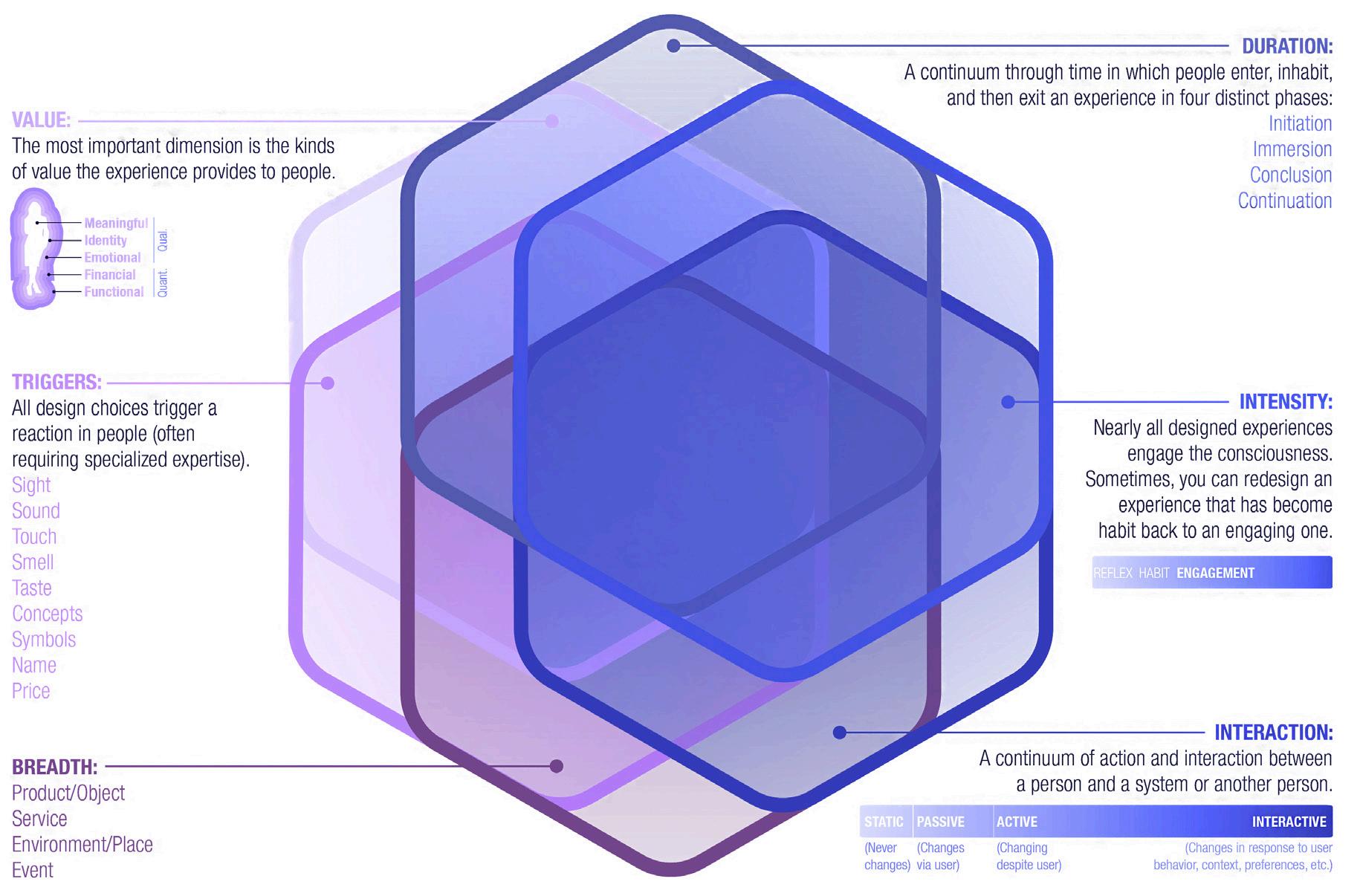
The most acknowledged classification of the different personal needs of humans has been formulated by the researcher Abraham Maslow. According to him, Human necessities can be organised hierarchy-wise into five categories: physiological, love, safety and belonging, self-esteem, and self-actualisation. The growing satisfaction of the lower requirements triggers the emerging need for the higher ones.
But on the opposite of Maslow’s theory, human needs also show a level of fulfilment and achievement rather than just binary fulfilment condition.
Hence, Kendrick Proposed the idea of a hierarchy of consequent as an alternative established upon the order of the growth of needs in human beings, which rejects the need for self-actualisation completely. Another model proposed by Alderfer proposes different categories of requirements: sustainment of one’s permanence, relatedness to others, and satisfaction of personal growth.
There is no hierarchal difference in this Model, and the necessities from these different categories may coincide. The fulfilment of inadequacies from one particular type increases the requirements in the other one.
73 72
Alderfer’s Model provides an immeasurable understanding of the individual’s positioning needs in the context of spatial adaptation. The challenge for the interactive built environment is to recognise a significant level of transformation, which is comparable to the adaptation which occurs in automated systems.
But in a similar time, It should also allow the world environment to adapt to unforeseen circumstances, for reference in the case of spatial reconfiguration. Suppose reconfiguration is understood in the field of an interactive system. In that case, we can say that reconfiguration is the phenomena of exchanging information between the users seen as a group and the built space.
Although the idea of user experience is majorly utilised in the field of human-computer interaction, there is no one specific definition of user experience.

The concept of a sense of locus of control- the degree or level to which a person can reflect their capabilities to exert a sense of control over the environment, seems to play a significant role in the success of interactive systems.
Figure 2.29The Amalgamation of different fields to develop more human centric and user experience type solutions and systems
Figure 2.30Interactive environments characterized in terms of their functional descriptions, the ways that adaptive behaviors are encoded in the environment or the ways they are utilized, and the cognition level which is associated with the varying behaviors
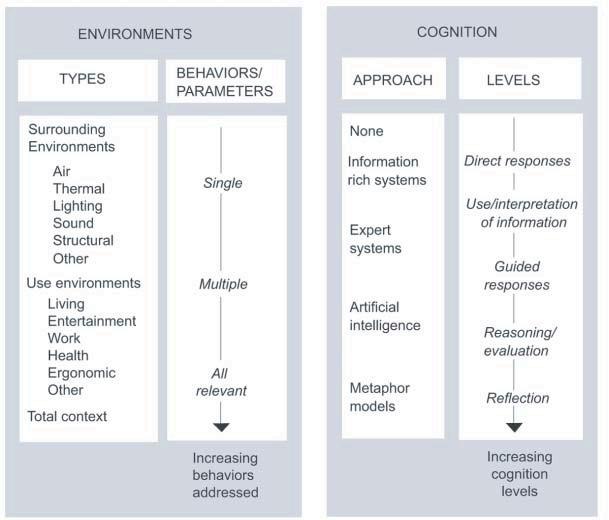
75 74
77 03 03 [En]coding Innovation in Interior Design [En]Coded systems + Design Process Novel Application of Spatial Optimization [En]Coded Interior System as an Approach
3.0 + [En]coding Innovation + Interior Design
As the built environment has started to perform and adapt to user’s requirement, enabling it to become genuinely interactive concerning users in facilitating conversations, interior design enters into unknown territory concerning user’s spatial design and user’s behavioural awareness.
The built environment around us is henceforth not restricted to one-on-one interactions in which they can participate in. The spaces can interact with user groups, adapt themselves and understand and share information about users’ performance in the area.
These kinds of applications share a different level of interaction between individuals or groups. When an interior built environment gains truly communicative capability, its senatorial characteristics enable users to develop a heightened sense of belonging and attachment.
It is necessary to understand that the users or people require spaces, not style, to recognise and understand the role of interactive spatial systems in enabling heightened experiences and facilitating desires. The users do not inhabit a space for shelter; they do so for the heightened experience of living in this space, impacted by many different factors such as materiality, acoustics, other inhabitants of the space and lighting.
The interactive spatial experiences can exploit the audience globally, regionally and locally by reimagining and envisioning the role of the physical environment in shaping the participant or viewer’s experience.
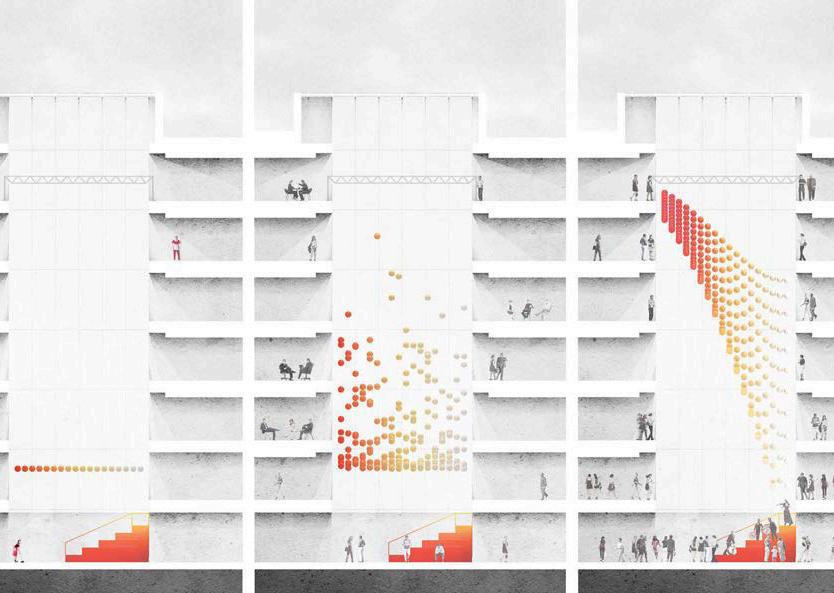
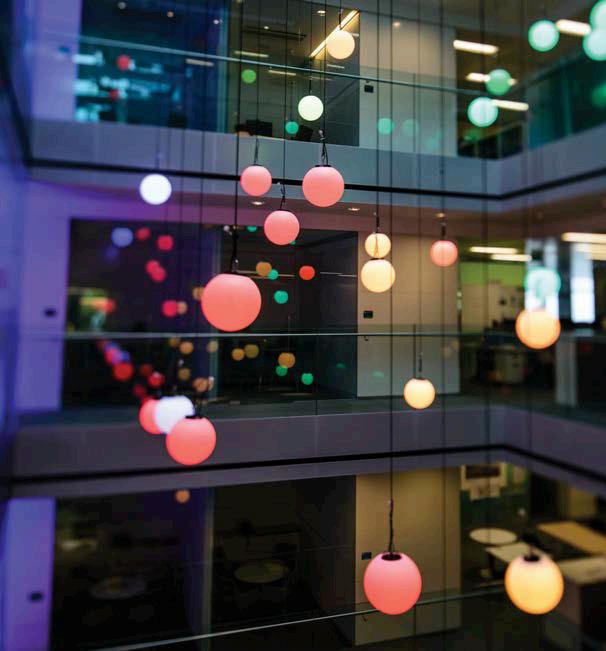

Figure 3.1Balls! by Ruairi Glynn and Alma-nac. The project allows the inhabitants of the work setting to take more control of the behavior of building and stimulate unexpected Interactions and creative outcomes.
Figure 3.2Concept diagram for the interactive installation Balls!
These approaches indicate that users can view physical spatial environments interactively beyond their walls and within the confines of space. It is essential to understand that users’ sociological and psychological understanding of spatial environments is influenced by many factors beyond the spatial confines of the interpreted knowledge of space in terms of smell, acoustics, and lighting.
Many applications, including interactive environments, do not limit themselves to mechanical movements or sensing the user. They embrace the new technological and tectonic innovations that enable interactions through innovative fabrics, holographic projectors, thin air projection technologies and foldable, flexible LCD screens.
Such innovations will remain significant to the programming of interactive spaces in the future and will require designers to think in new ways to design the experience of space. Most of these innovations are technological but not physical. Yet, they have an essential function and role in impacting the space’s use or definition and experience. Interactive environments dynamically adapt and respond to users needs and desires; interactive environments can create an enhanced spatial experience. As the built environment responds and adapts to the user’s action, they are approached with a new level of choices and awareness in spaces.
The interactive environments can facilitate a dialogue with its inhabitants based on the need to satisfy the interpreted goals or create a new emergent state to meet the vague assumption of desires. The end goal of such interactive systems is to engage in the space in which the user is either enticed, manipulated, coerced, directed or asked. This requires interactive spatial environments to operate on an intuitive level of communication.
79 78
3.1 [En]Coded systems + Design Heuristic
Interactive spatial design is about developing new interactive and communicative relationships between the built environment and the people. Interactive environments transcend users’ expectations from various types of interactive decision fields such as digital media, sculpture and art because it empathizes with interactivity in spaces and participants.
With the evolution of fabrication technologies and computational techniques, it has become undeniable that interactive interior design benefits significantly from other disciplines outside the field of architecture. At this point, designers must evaluate the current landscape of design processes to evolve spatial environments and future foresight. The new emerging landscape of interactive environments is being designed for users’ unique needs. The designers must understand the new associative design heuristics and new design tools necessary to create such environments.
Figure 3.3The transformation of interior spatial experience due to the characterstics which are encoded to create interactive systems.

It is also paramount to understand the issues of sustainability and the issues related to human behaviours that profoundly affect the field of the interactive build environment and have been barely explored and resolved. In an overview, to design the interactive built environment, the interior designers need to start rethinking the approach of creating spatial elements that include interaction capabilities.
With the emerging needs of users, it is essential to have well-trained designers to understand the human issues and have the capability to drive the creation of spaces.
It is not necessary for interior designers to thoroughly understand the working of such systems. Still, they should realise the significance of capabilities interactive systems provide to space and the comfort it offers to the user. It is essential to evaluate and understand the ability of such systems in their usage in interior programmatic environments.
The actual operation and construction of such systems will allow the designers to understand and develop a realistic understanding of environmental and human conditions and understand the cost of operations and manufacturing and how it should be planned out in an interactive spatial project.
Figure 3.4Ada: Intelligence space has allowed the designers to investigate the applied and fundamental questions which include sensory integration on large scale and communication and interaction between artifacts and humans


Hence the new ideas and concepts must be experimented with and tested at an accurate human scale or in a physical, tangible form to give the designers an insight into the deficiency and capability of the system. Significant projects that seem to have gained the most success have experimented with developing and fabrication of tangible objects and spatial environments at full scale.
It is also necessary that the designers and interior architects, during designing and understanding the new interactive system, continue to evolve their learning of the latest fabrication methods, tools, peripheral technologies, and materials leading the innovation in conjunction with design.
81 80
3.2 Novel Application of Spatial Optimization
The interactive systems create the possibility for designers to optimize the space for the users heightened sense of experience and goal achieving benefit. This happens through many different ways in which such interactive environments allow the users two communicate with space and transform their way of performing activities and specific actions.
The unprecedented capabilities of interactive environments to provide their users with information about their specific actions and goals impact their behavior in space.
Programmatic spatial environments that can adapt and adjust themselves to the user’s needs and requirements are also capable of teaching their users to transform their working and living habits. For example, sustainable living is a term that is defined for users behaviors that have a lifestyle-related to the systematic and structured building operation. Many more examples of such behaviors deal with structured and systematic spatial built procedures but are not innate to their nature.
Receiving correct feedback from an interactive system is very important to measure the effectiveness of the system. It is also essential for teaching the users to respond to it successfully.
To understand the new user's needs, a specific understanding of the new characteristic of spaces is required by the designers to evaluate the impact of adaptation and intelligence on users in such an interactive environment.
Figure 3.5ECO-29, designed by FoxLin and Brahma Architects is capable of adapting and transforming experiential environment as envelope scale
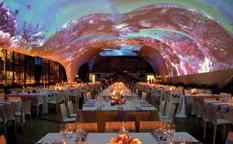
These factors, when understood in depth, are utilized to create systems which provide satisfaction to the user of the space to a greater extent than vernacular interior environments. If we look at the characterization of an interactive space, three major factors can be identified and differentiated.
• Environment characteristics: One important aspect lies around the utilization of spatial environments and humans occupying it, which includes the optimization and improvement of processes which support and respond to human lifestyle, working and living conditions. Another important factor is centered around the characteristics of physical spatial environments which improve and support the spatial optimization in one way or another with the use of interactive technologies.
• Cognition characteristics: This factor includes the ability to which the cognition-based processes are imbued in the space or encoded in the elements of the environment. Capabilities such as engaging with human thoughts, cognition and emotions occurring in the background are included in this characteristic.
• Implementation characteristics: It includes an understanding of how interactive enhancements can be operated, controlled and invoked.

These factors play an essential role in the space optimization of interactive systems. They lead to an enormous increase in flexibility of space in both working and living environments.
The constant back-and-forth relationship of such interactions will eventually lead to an evolved experience because the environments and their users participate in a continuously evolving dialogue between the quality of the performance of these activities and the experience of such activities.
83 82
3.3 [En]Coded Interior Systems as an Approach
The field of interactive systems as an approach is constantly evolving with research from different biology, psychology, biomedical engineering, biomimetics, robotics, artificial intelligence and design.
By understanding the phenomenon of interaction and development of interactive environments, one can understand the different models of interactions constituted from de-coding the characteristics of interactive systems in the last topic. There are various methods of invoking the operation of action with the aid of a wide range of sensors and supporting technologies.
Figure 3.7Manifestation of behavioural and environmental characterstics for transformation of systems, space and components in interiors.
These technologies may range from simple to complex with various forms of tracking, which is human tracking, facial recognition or gesture control systems. These systems are usually embedded in the spatial elements that are not visible to the users or participants of space. Following are the models that enable interactive spaces’ characteristics and invoke, operate, and control the complex system in three significant ways.
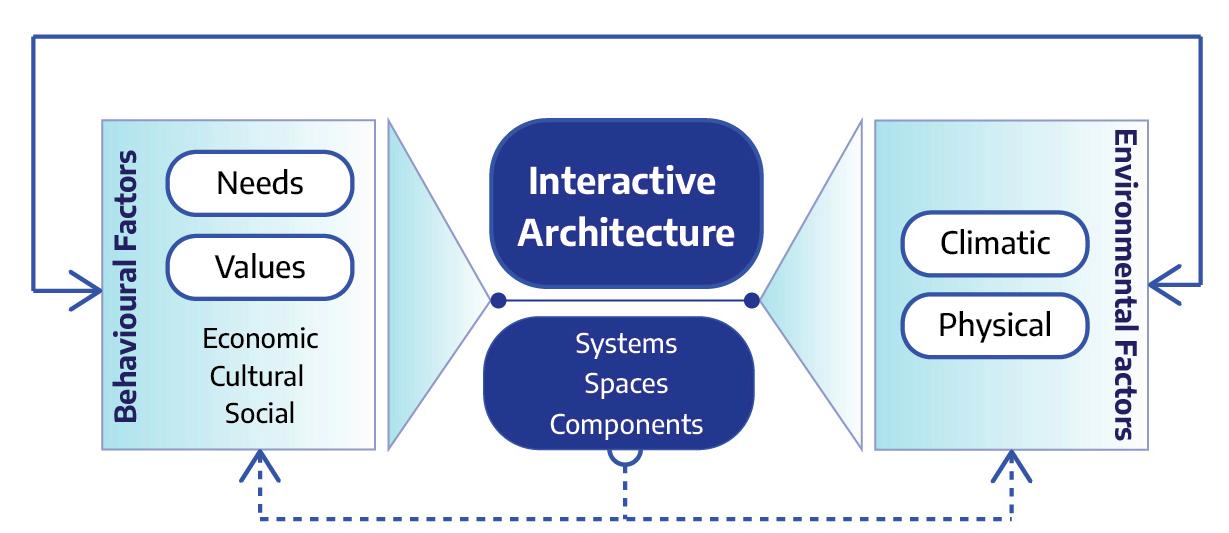

Multi-Mediated Interaction Model -
This is the most basic approach where the sensors pick a change or action in the stimulus field, the signal is transduced, and the last signal controls the response. This type of systems allows the model to incorporate many different types of computational settings, which would enable different types of logic and operation to be incorporated into the system. These types of interactive systems can be complex or straightforward. As per the encoded sequence of functions and logics, their responses can be collective or individual, depending on the computational model. In such models, interactive systems remain as an outer performative manifestation of the spatial plan.
Emergent Interaction Model -
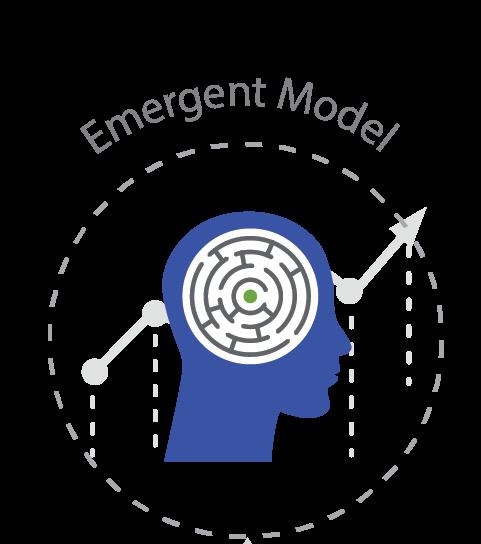
These models are utilized in connection with intelligent materials or systems that can change properties. An external stimulus causes a transformation in the properties or behavior of a material or technique, which impacts the user’s response. The digital or physical interface of such systems becomes more embedded and transparent for users. These forms of interaction models are extensions of previous models but exhibit more intelligent and adaptive behavior. In such a model, the interactive system become elemental characteristics of the space and perform a spatial function with an interactive or communicative approach.

Intelligent Interaction Model -
These interactive systems are based on a metaphor of living organism functions or exhibit intelligent behavior by the highest stimulus-response or human-like interaction and adaptation level. In such scenarios, the response, intelligence, sensory and stimuli based functions are embedded and interlinked to exhibit unique qualities and positive behavior. The spatial interaction provides more thoughtful and automatic responses to engage the audience. In such a model, the interactive systems become the primary programmatic focus of the spaces, and each individual has a unique and exclusive interaction experience.
In the current interactive design practice, the significance of the characteristics specified above are applied to single or multiple space behaviours and are utilised concerning components and elements that constitute the more extensive spatial system or program.
Interactive design is reinventing and revolutionizing the concepts of living, working and leisure as a spatial medium. Slowly as an approach, interactive spatial environments become an essential concept of successful futuristic interior projects that employ intelligence, adaptability, and reactivity to their program and interior elements.
85 84
87 04 04 [De]coding Interactive Environments Theoretical Framework Criteria and Evaluation for New Approaches Selection of Case Studies Case Studies Starbucks Milano Roastery Lindt Home of Chocolate Plinthos pavilion
4.0 + De-Coding Interactive Systems
The study investigates the interactive systems or environments in interior spaces through the lenses of multiple theories that elaborate on spatial methods’ behavioral and environmental factors, leading to the manifestation of multi-mediated settings. Designers can use the characteristics and parameters governing the interactive spatial systems to decode such environments to understand the spatial and interactive narrative of spaces and understand the impact of such spaces on the user.
4.1 Introduction to the
Theory
The framework is constructed from understanding various factors which influence the user’s experience and spatial program of interactive space.
These factors include behavioral and environmental understanding from the theory constructed in the previous chapters. The characteristics allow a deep analysis of the multidimensional and multi-mediated programmatic spaces, making the space adaptive and innovative.
De-coding the Spatial Narrative (Understanding spatial elements as tools)
Analyzing the behavioral factors which impact the spatial performance of an interactive environment.
De-coding Interactive Model (Understanding technology as a tool)

Analyzing the environmental factors which impact the spatial performance and utilize interactive interventions as elements.
De-coding Interactive Systems
Understanding aspects of adaptation and innovation to synthesis and understand the design implications on users.
Understanding the Novel Application of Spatial Optimization
Understanding the factors which influence the users perception of space and comparing them to understand the impact of different interactive models.
89 88
4.1.1 Factors and Parameters governing interactive spatial environments
These are the fundamental factors derived from the literature, which impact the spatial experience of any interactive interior environment. These factors are segregated into three major categories.
Behavioral Factors
These are factors which impact the users spatial experience. Understanding these factors for interactive systems can provide a critical insight into how spatial elements interact with users and foster informative and emotional relationships with them.
User ExperienceSense of Place - Capability of space to adapt to users physical, personal and psychological needs, which imparts a sense of accomplishment the users actions in space.
Behaviour Awareness - Capability of a spatial environment to inform the users how the actions they perform can have beneficial effects of the environment’s behavior and user experience.
Spatial Awareness - Capability of interactive surface or a space to become a translator of information related to spatial transformation.
Control of Space - The ability of the user to transform and manipulate the spatial environment, which provides them the ability to create new connections which fosters emotional attachment.
Mode of Engagement
Physical - The interactive systems perform physical actions to interact with the user. These physical actions can be mechanical or kinetic.
Virtual - The interactive system creates virtual performances and interactions. These can be with the help of the latest VR and AR technologies. Such environments are technologically mediated so that the person can experience the transformations or actions they perform in space.
Acoustic - There is an association between the users auditory experience and spatial acoustic response. The space utilizes sound as a tool to respond to users action and exchange information.
Visual - The systems perform visual and graphical interactions with the users and usually interact through the user’s haptic input. Such interactive systems are designed with display units or projected displays which allow exchange of information in form of visuals.
Type of Engagement
Personal - The user experiences a personal interaction with the interactive space or object and can create individual specifications for spatial performance.
Collective - All the users experience the space in a similar or collective manner. Each user receives a common response instead of an individual.
91 90
Environmental Factors
These are factors which impact the design decisions of the space and how technology is utilised to create interaction in space.
These factors play an important role in technical factors of the spatial environment which concern the scales, dimensions, ergonomics and arrangement of spatial elements with respect to the technological interventions. Interactive systems are usually added to a spatial system as an intervention, but with more understanding of environmental parameters, the interactive systems can be designed in a functional and performative manner so that they become a spatial element.
Novel Tools and Heuristics
Respond - Capability of the systems to respond and adapt to the users demands, changes, environmental factors and events with help of sensors which are embedded in the interaction system.
Materialize - Manifestation of physical components which enable the encoding of information to interact with the users.
Actuate - The capability of the systems to realize or actuate movements, temperature, rotation, transparency, scale and many more.
Support - Understanding the support systems which help realize the systems with capabilities of interactivity. What are the exact conditions which make the interaction between users and spaces possible are explored to understand the manifestations of such systems.
Control - Understanding the control of dynamic aspects or behavior of the interactive system.
Articulation of Interior Systems
Mechanical - The interaction system comprises mechanical components which create kinetic or physical movement in the space and impact the perception of the user.
Cybernetic - The system comprises interactive systems which have no movement in the system to respond interactively to the user in virtual or digital manner.
Hybridized - The interactive systems which are an amalgamation of digital and physical systems to create interactivity in a spatial environment.
Audience Interaction
Performative - The system’s response doesn’t require the user’s personal input, the reactions are encoded and remain similar to all forms of interaction. The user has the least amount of input in terms of physical or digital participation.
Collaborative - The interactive system requires interaction with the user and requires the user to perform certain actions for communication. Such systems require the user to participate in the interaction by using their senses partially
Immersive - The interactive system requires constant interaction or communication with the user in physical and digital manner. Such systems completely immerse the user in the interaction and requires them to use all their senses altogether.
93 92
Novel Factors of Spatial Optimization
These factors assist in understanding the programmatic spatial environments which have the capability to adapt and adjust themselves to the needs and requirements of the user, and are also capable of teaching its users to transform their working and living habits.
The capability to spatially optimize the program is further analyzed to understand the importance of the role of interior designer to create human centric experiences which follow design constraints of interior and architectural design.
These factors are employed to conduct a comparative study between the different interactive environments to understand the impact of different interactive models on the users.
Initiative of Interaction
The characteristic refers to the requirement of interaction to be initiated. It is important to analyse whether the action needs to be performed by the user of the system automatically performs the required actions and henceforth initiate the interaction with the user.
Ease of Communication
The characteristic refers to the simplicity or the complexity faced by the user of the interactive system to retrieve from or input information into the system for communication.
Levels of Integration
The characteristic refers to the extent to which the user of the space can perceive and visualize the interaction intervention as a fundamental and integral part or element of the spatial environment instead of being an additional insertion.
Scales of Interaction
The characteristic refers to the scale or the proportion of the inhabitant or user’s own scale with respect to the scale of their input, and the proportion or scale of the outcome of the spatial
Locus of Control
The characteristic refers to the psychological effect of the interactive spatial environment on the user. It refers to the user’s tendency to understand and comprehend that they are able to control the system or the factors which are affecting them. Users with strong internal locus of control feel responsible for the results of interactive systems whereas users with strong external locus of control shift responsibility on the interactive system. Locus of control has the impact on the user’s perception of control and agency in an interactive environment.
Modalities of Interaction
The characteristic refers to the utilization of different modalities or senses which are employed to facilitate the communication between the users and interactive system. These are employed to increase or improve the sufficiency of physical response which enable an intimate connection with the user.
95 94
4.2 Case Study Methodology
The framework is constructed from understanding various factors which influence the user’s experience and spatial program of interactive space.
These factors include behavioral and environmental understanding from the theory constructed in the previous chapters.
Through the developed research framework and theories of interactive systems, three models of interactive environments are deduced to understand the significance and impact of each of them.

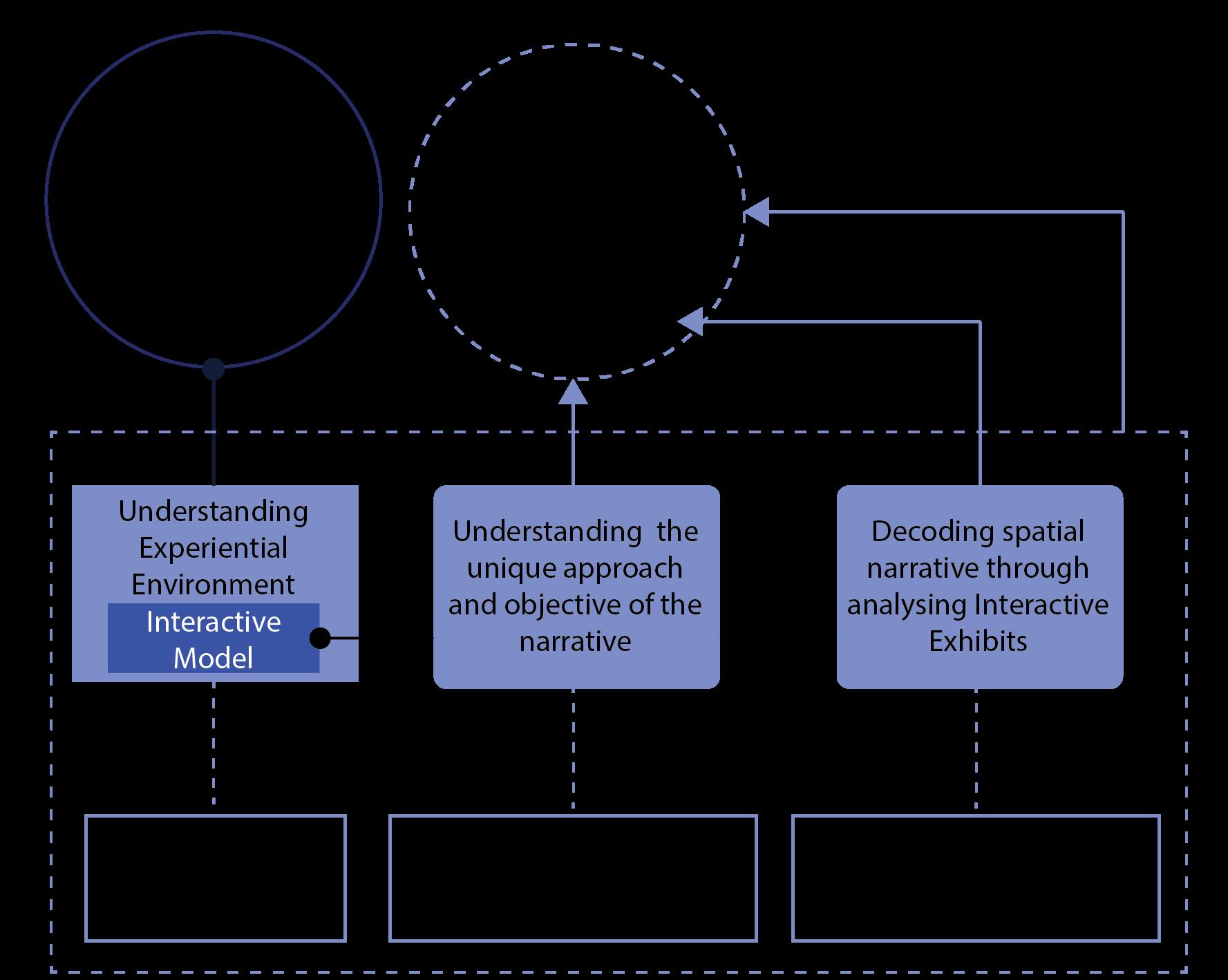
The chosen case studies are analyzed using photographs, sketches, drawings, illustrations, mind maps and text explanations. The behavioral and environmental factors are evaluated to further evaluate novel aspects of spatial optimization for each of the chosen studies. Based on the readings from the comparative matrix and the behavioral and environmental factors analyzed, inferences are drawn to understand interactivity from a spatial perspective.
These inferences lead to the conclusion of the research on the innovation of interior systems through encoding interaction.
Figure 4.2.1
Figure 4.3.1
4.3 Selection of Case Study
The case studies are chosen on the basis of experiential interior environments which have interactive or intelligent systems as elements of space or architectural design and services. The focus remains on the sensorial quality they want to achieve through interactive systems

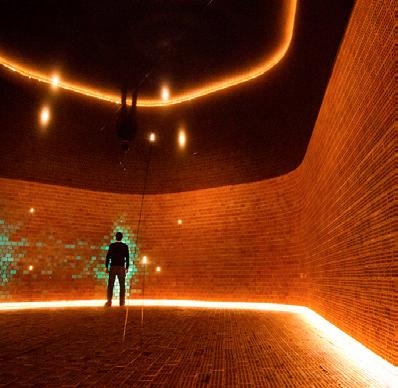
Starbucks Roastery - In the Roastery, the interactive virtual argumentative reality compliments the physical retail environment, which engages the customer to use their smart phones and interact with the space.
Lindt Home of Chocolate - The museum designers aimed to create an interactive chocolate experience for the visitors, young or old, and celebrate the firm’s successful and long history of producing epitome quality chocolates.

Plinthos Pavilion - The spatial interactive system is designed by the Greek architects, MAB Architecture for an Interior Design Show to explore if it is possible to add transparent or translucent quality through technology to an opaque object.
Starbucks Roastery, Milano
ExperienceFreedom
Lindt Home of Chocolate, Switzerland ExperienceHappiness
Plinthos Pavilion, Greece ExperienceTransparency
97 96
4.4.1
Case Study I Starbucks Roastery, Italy
About:
At the Starbucks Roastery in Milano, innovation and heritage take primal point against the backdrop of immersive discovery and stunning design. The retail environment invites the customers to an exclusive experience of Starbucks with such jaw dropping views that bridges across all the jaw dropping views of all aspects of roastery experience.
The vibrant color palette reflects the Italian design community and fashion, and the space transforms through the filtered light from glass ceilings. In the Roastery, the interactive virtual argumentative reality compliments the physical retail environment.
LocationMilan, Italy Interactive Model - Multi-Mediated TypologyRestaurant DesignersLiz Muller Year2018
Figure 4.4.1.2The Cask, placed centrally in the environment transforms the visitors experience by engaging them to see the raw processes of coffee making interactively.
The Roastery and Cafe are designed inspired by the luxury Willy Wonka chocolate factory into an interactive coffee experience. The spaces are articulated encompassing the copper clad roasting cask.

All the material and high quality finishes are an integral part of Italian craftsmanship and design culture.

Figure 4.4.1.1The Famous historical building, Piazza Cordusio houses the innovative and interactive experience of Starbucks roastery.
The Roastery is located in Piazza Cordusio, which is in the heart of Milan. The Starbucks new and innovative spatial environment is an upscale ‘theatre of coffee’, which presents an offer to the customers to participate in an immersive experience which takes them through the journey of the bean roasting process, which includes the brewing and grinding methods.
Figure 4.4.1.3All the elements such as the bar, the flooring and the ceiling are designed with Italian innovation and craftsmanship and create a sensorial feeling of nostalgia
The brick and marble spatial elements, the blossoming roasting cask and twisting copper pipes, the vibrant colors and cascade of sounds and changing lights create the intricate masterpiece of coffee innovation and Italian craftsmanship.

99 98
Spatial Narrative Program
The design of the spatial environment, which indulges the experience of coffee making in restaurant and museum environment, respects the building’s original character. Three floors and a mezzanine level are renovated and opened to the public for a getaway from home and work. The project is completed in a total of 2,500 m2 area.
The Timeline
Entry
The Cafe Entrance
Spatial Organization
The Cask
Figure 4.4.1.4 -
The programmatic elements of space which induce a sense of freedom and nostalgia in visitors due to interactive interventions.
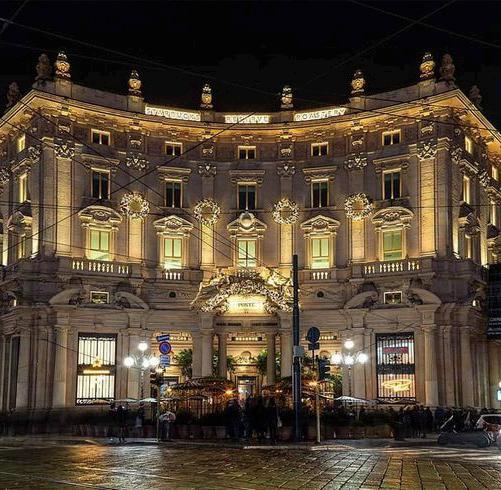
At the Centre of the spatial environment, there is a fully functioning Scolari Coffee Roaster. To its right there is a main bar designed in the palette of wood, glass and marble where the cutting edge coffee beverages are made with innovative machines.
The physical environment has an additional intervention of AR experience which allows the visitors to explore the innovative history of Starbucks. The beautiful retail environment engages all the senses of the visiting customers - smell, sight, touch, sound and most importantly taste.


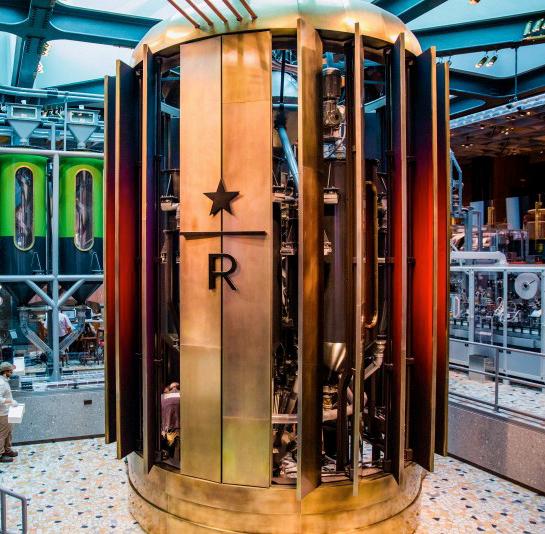
Experience



Main Bar



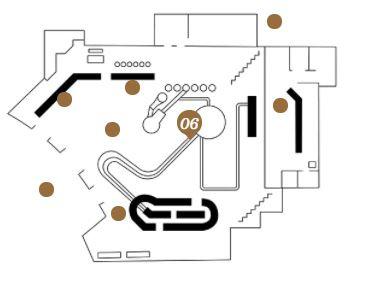
The technique melding craft with science and intricately carved teak wood and marble together create a multi-sensorial experience which indulges the user to explore the coffee making process.
Figure 4.4.1.5 Bar Figure 4.4.1.6 Paladiana Floor Figure 4.4.1.7 Glass Lights Scolari
Board and The Time-line
The iconic informational solari board, inspired from the airports and railway stations worldwide in 1956, is introduced near the ordering station to create the experience of a transitional stop.
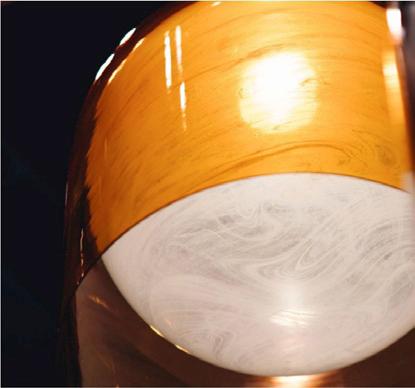
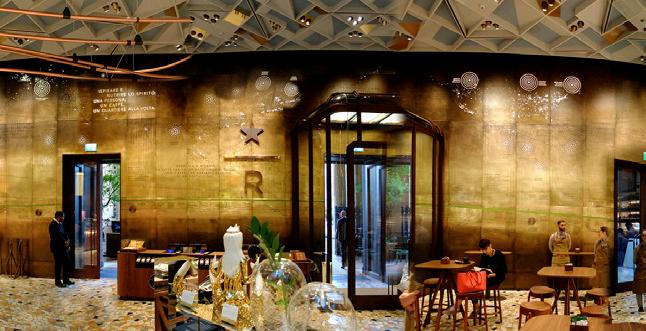
Figure 4.4.1.8 Scolari Board
The innovative history of Starbucks is presented on a copper engraved interactive wall which allows users to interact with it using augmented reality.

Figure 4.4.1.9 Timeline
The Cask
The Cask allows users to indulge in a performative experience of coffee beans roasting with mechanical interventions of rotating and flap opening.
Figure 4.4.1.10 Cask
Narrative of Space
The interactive elements in the space try to indulge the users in a collaborative experience which allows them to utilize all their senses. The visual interactive element such as Cask and interactive argumentative elements such as Time-line allow users to participate in the program of the space, and personalize the experience of each user.
101 100
The Cask
Interactive Narrative
The interactive elements in the space play a primary role in the program of the restaurant. Their positioning in the space impacts the user experience by creating a diversion for them while they wait for their ordered products.
Interaction + Physical
A well engineered bronze cask plays the pivotal role in the arrangement of tube system which transfers the coffee beans from the cask to different part of the cafe.
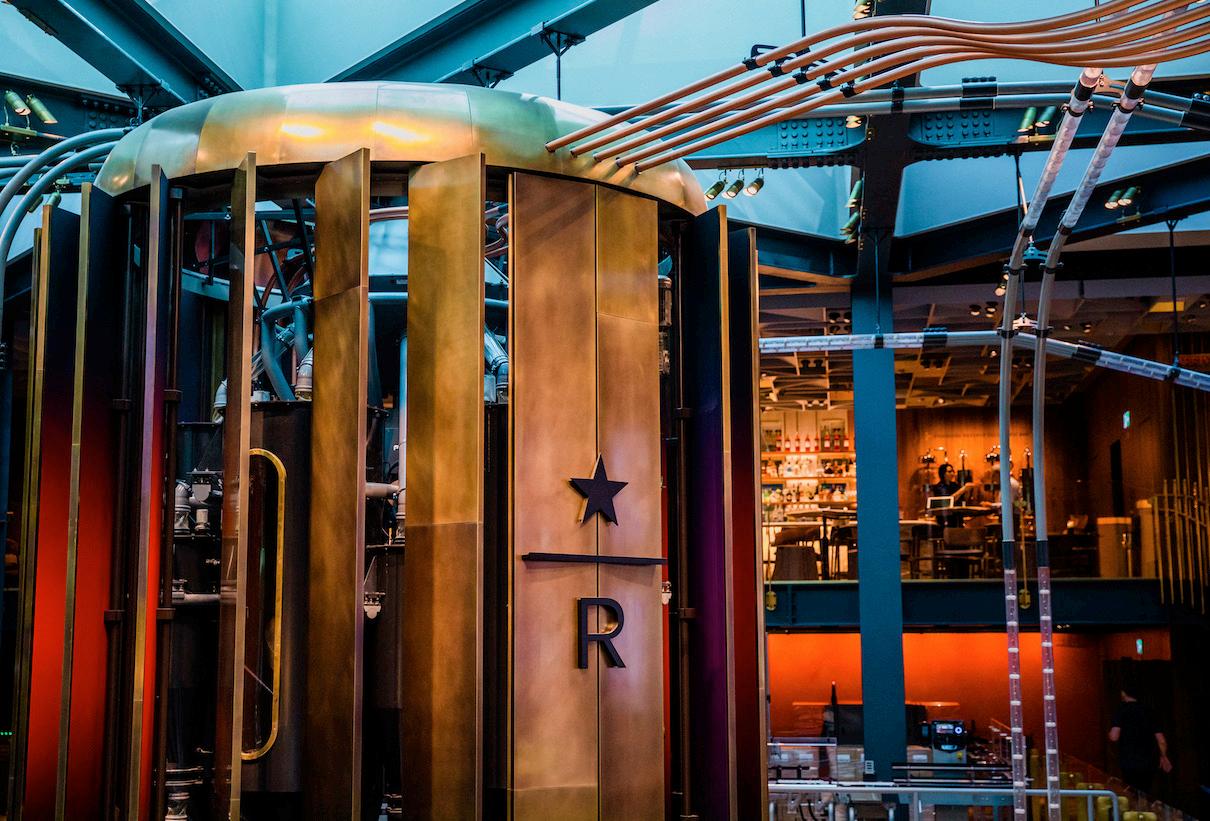
Figure 4.4.1.11The Cask, interactively rotates, opens its door and closes to provide the visitors a glimpse of coffee beans roasting

The placement of the cask in the central position creates a circulation around it for viewers to view the cask and also creates an interconnected network of coffee bean roasting mechanisms.
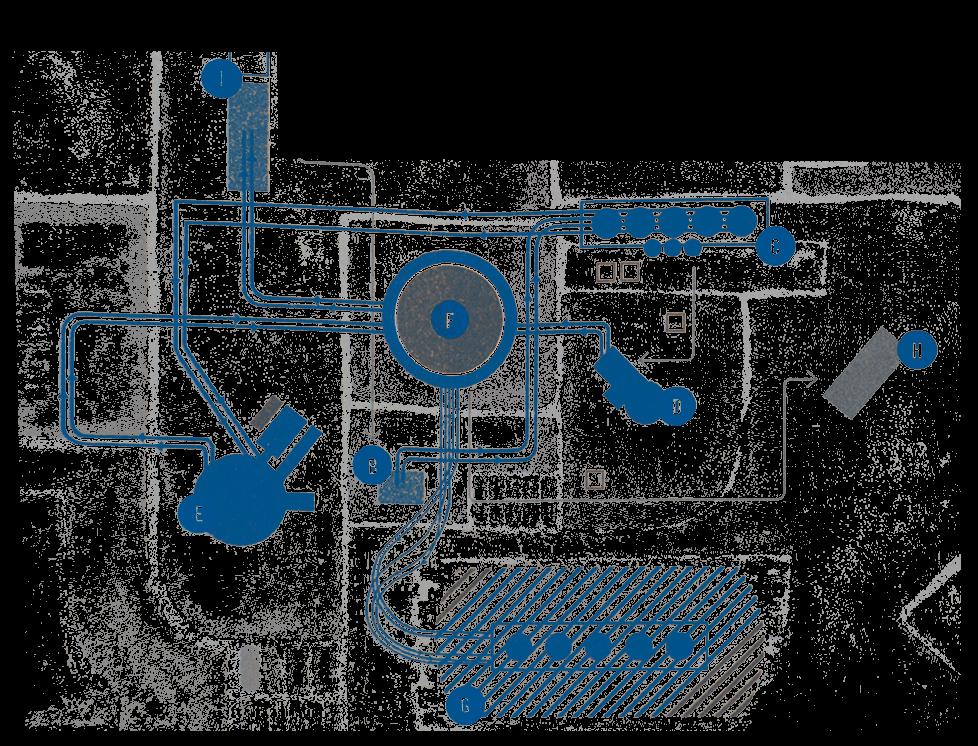
The engineered systems bring liveliness to the cafe environment and authenticity to the brand’s quality and allow users to experience the process firsthand.
Figure 4.4.1.12The systems creates an interconnection with other elements such as walls and ceiling to transport roasted beans.
103 102
Figure 4.4.1.13
The Cask
The Cask
Figure 4.4.1.14
Figure 4.4.1.15


105 104
Interaction + Digital
The time line is a physical interactive installation with an additional augmented reality experience for the visitors to indulge in the history of Starbucks and allow them to.


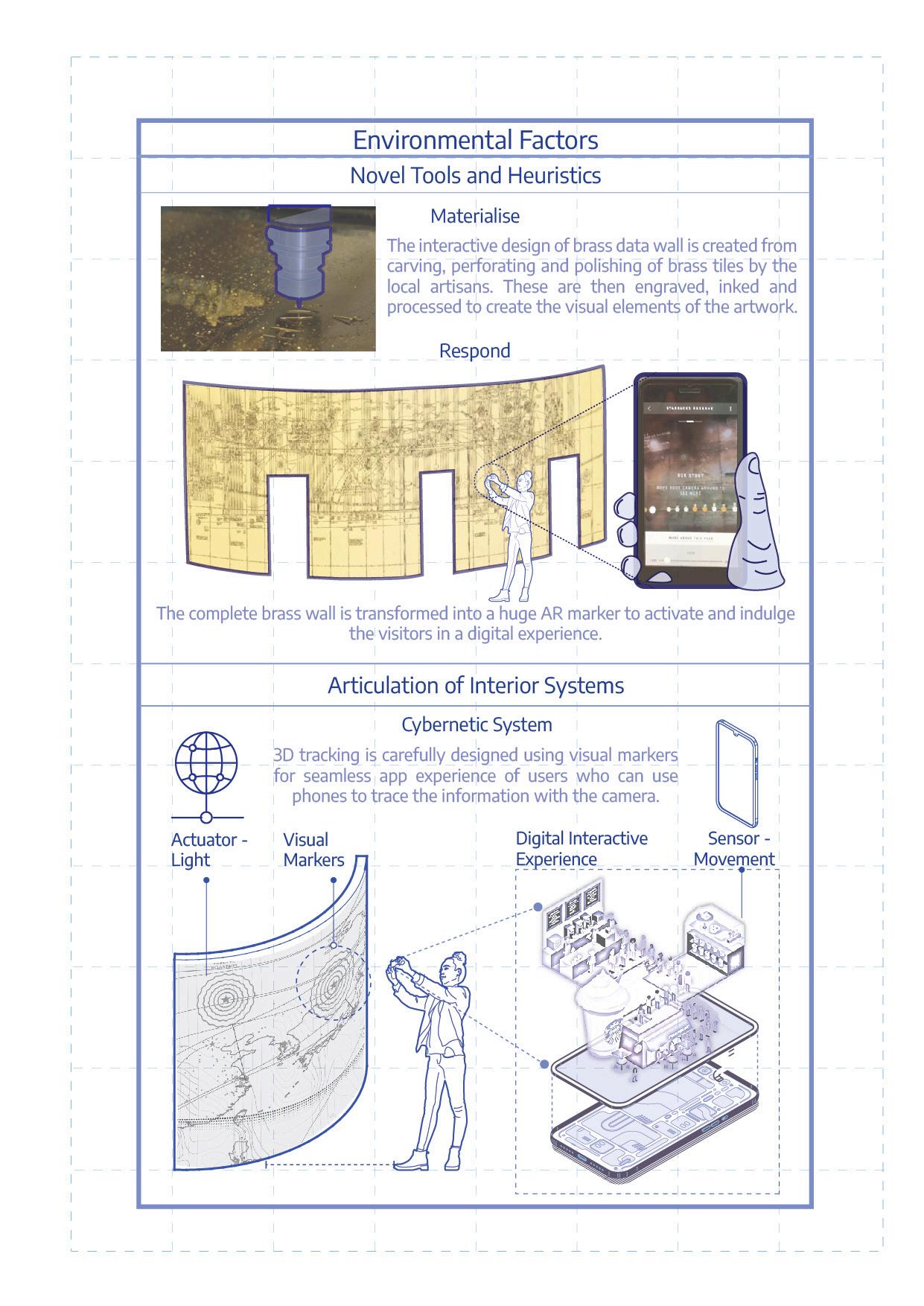

Figure 4.4.1.16The interactive time line is placed near the transt point of entry and exit to welcome the visitors
Figure 4.4.1.17The interactive App. and its different responses from wall while tracing.
The interactive experience is installed to pay homage to the Italian espresso culture and trace the innovative journey of Starbucks. The wall can be interpreted and interacted with by the visitor’s smart phone which allows them to explore the three interplaying and overlapping layers.
Figure 4.4.1.18The visitors can interact with their wall using their smart devices and utilize their time by moving about different regions of the wall to explore new knowledge.
The layers comprise the narrative of the journey of Starbucks, the different types of coffee blends, and the important milestones and places in the historical success journey of the company.
The Timeline
Figure 4.4.1.19
107 106
The Timeline
The Timeline
Figure 4.4.1.20

Figure 4.4.1.21

109 108
Key Finding -
Adaptation
The spatial experience and program is transformed from a cafe to a roastery to initiate more interaction with visitors.
The interactive elements of the spatial environment allow users to empathize with the brand’s motto and identity encouraging them to build trust and loyalty for the brand. The concept of the interactive systems allow users to explore experiences and information beyond the spatial dimension of the cafe and have a unique experience in their journey of ordering the food and consuming the final product. The adaptation of space and program creates a better experience for visitors who want to experience the authentic Italian culture and Starbucks coffee.
Figure 4.4.1.22The positioning of the innovative brand which impacts the experiential design of the Roastery

Design Synthesis
The Interactive systems are inclusive and necessary in the spatial functioning of the roastery. Each element has been designed using Italian finishes and materials. Many different vendors participated in an interdisciplinary program with the interior designer to create the interactive experiences.
Innovation
The program introduces the users to the raw products and the process of coffee making instead of the final product and cafe service.
Hence it is important to create interactive systems to design an experience where visitors can navigate through the journey and easily understand all the aspects throughout.
This page is intentionally left blank
111 110
Case Study II
Lindt Home of Chocolate
About:
Designed by Atelier Bruckner, the Home of Chocolate draws inspiration from the iconic movie “Charlie and the Chocolate Factory” and parallels the Sprungli and Lindt’s factory site’s history, urban structure and logic. It is a classically composed and experiential multifunctional space which intertwines mixed-use programs and user-focused exceptional interactive exhibits. With the aim to elevate the visibility of the world renowned swiss chocolates, the museum is designed to entice the visitors with the journey of chocolate making and its many charms. The museum designers aimed to create an interactive chocolate experience for the visitors, young or old, and celebrate the firm’s successful and long history of producing epitome quality chocolates.
LocationKilchberg, Switzerland Interactive ModelEmergent TypologyMuseum DesignersAtelier Bruckner Year2020
Figure 4.4.2.2The experiencial environments are created to immerse the visitors in various historical facts and processes of making chocolate
The museum utilises technology as a tool to add interactive interventions over the spatial elements. The technologies used are concealed in the design and the visual and auditory experiences engage and inform visitors of the interactivity.
The nine different experiences allow the visitor to interact with the environments spatially by cybernetic and hybridized systems as elements of space. The design of each interactive exhibit aims to sensitise the visitors by engaging all their senses in experiencing different aspects of the journey of chocolate at Lindt.


Figure 4.4.2.1The Interactive Chocolate fountain which entices the visitors to experience the world of chocolate making

Figure 4.4.2.3The atmosphere of the space is to interactively engage visitors to feel happy and empowered and explore as much as possible seeking rewards
The museum’s architecture was designed by Christ & Gantenbein and the interactive interiors was designed by the firm Atelier Bruckner.
The spaces inside provide the visitors a feeling of escape to another world. The placement of the experiences is such that the final product “Lindt Chocolate” is offered to the visitors in the end. The whole journey intimidates their senses with the sound, smell, and vision of chocolate making which allows them to enjoy and value the final product at the end of the journey.
113 112
4.4.2
Spatial Narrative Program
Encapsulated by the building’s beautiful architecture and unique chocolate fountain, the visitors move towards the tour of discovery which is on the first floor. The exhibition is designed in a total of 500 sq mt area on the first floor.
The media stations, visitor participation systems, smells and sounds engage the audience and give them the opportunity to become a participant in the different scenarios.
Spatial Organization
Individually designed experiences, all the exhibits communicate to the user through their senses with rich information to share about the different characteristics of the world of chocolate.
Figure 4.4.2.4The Programmatic Plan of the Interactive Exhibits in Lindt Home of Chocolate.

Figure 4.4.2.6The interior experience of well lit interiors and sensorial impact of white surfacial textures create a heavenly feeling in the visitors
Narrative of Space
The materiality of designed spaces aims to express the nativeness of the swiss pioneers and individual rooms are designed focusing on the thematic narratives of the space.
Figure 4.4.2.5The Timeline of Visualing and Constructing the Building and Experience

Interactive Narrative

Museology’s approach has shifted towards museum thinking, which serves the best to society and the community. In the digital age, the museum’s role has transformed from working for their community to working with them. It means that the technology facilitates instantaneous communication for the digital age’s participatory culture, which inspires new experiential museums. The type of interaction in museums has evolved to user-generated content, personalized experience, crowd-curated exhibitions.
Although the new approach to museology adopts plurality, it also demands active participation from the visitor. Intertwining these two factors brings out the most significant challenges faced by museums in the digital age. Technology acts as a mediator to transform the spatial narrative and justify the amalgamation of both factors in the new approach.
Interaction + Physical + Digital
The Lindt Home of Chocolate provides the larger set of audience with a unique museum which offers in-depth information platforms for all matters which concern the chocolate industry. The museum also finds interactive ways to provide a glimpse into the secrets which the brand has. This helps the audience develop feelings for the brand’s innovative approach and luscious chocolates.
The interactive experience indulges visitors using cybernetic and multi mediated systems which are concealed in the interior spatial elements. The visitor become the participants of the space since they have to perform a certain task to initiate the interaction.
115 114
The experience comprises eight interactive experiences which have completely different environments and narrative for visitors to interact. Each space encapsulates an important fact or knowledge of Lindt’s History and Innovation of Chocolates. The placement of the experiences are such that the previous interaction enables visitors to understand the next experience.
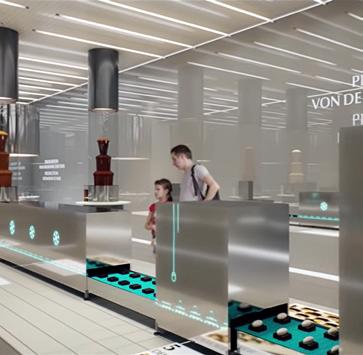
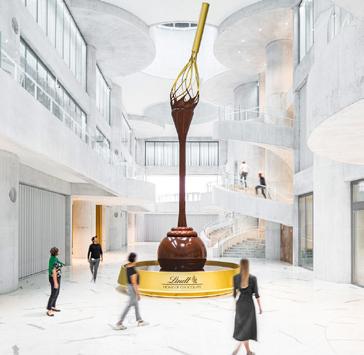
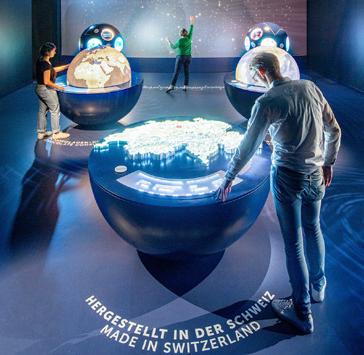
History Room
In an interactive museum environment, when the systems result in clear communication with the visitor and the outcome is visible, the visitor accomplishes a sense of achievement, rewarding to the visitor’s experience and learning. Such a learning environment transcends museums’ traditional role and instigates new conversational methods of operating physical and tangible spaces.
Experience

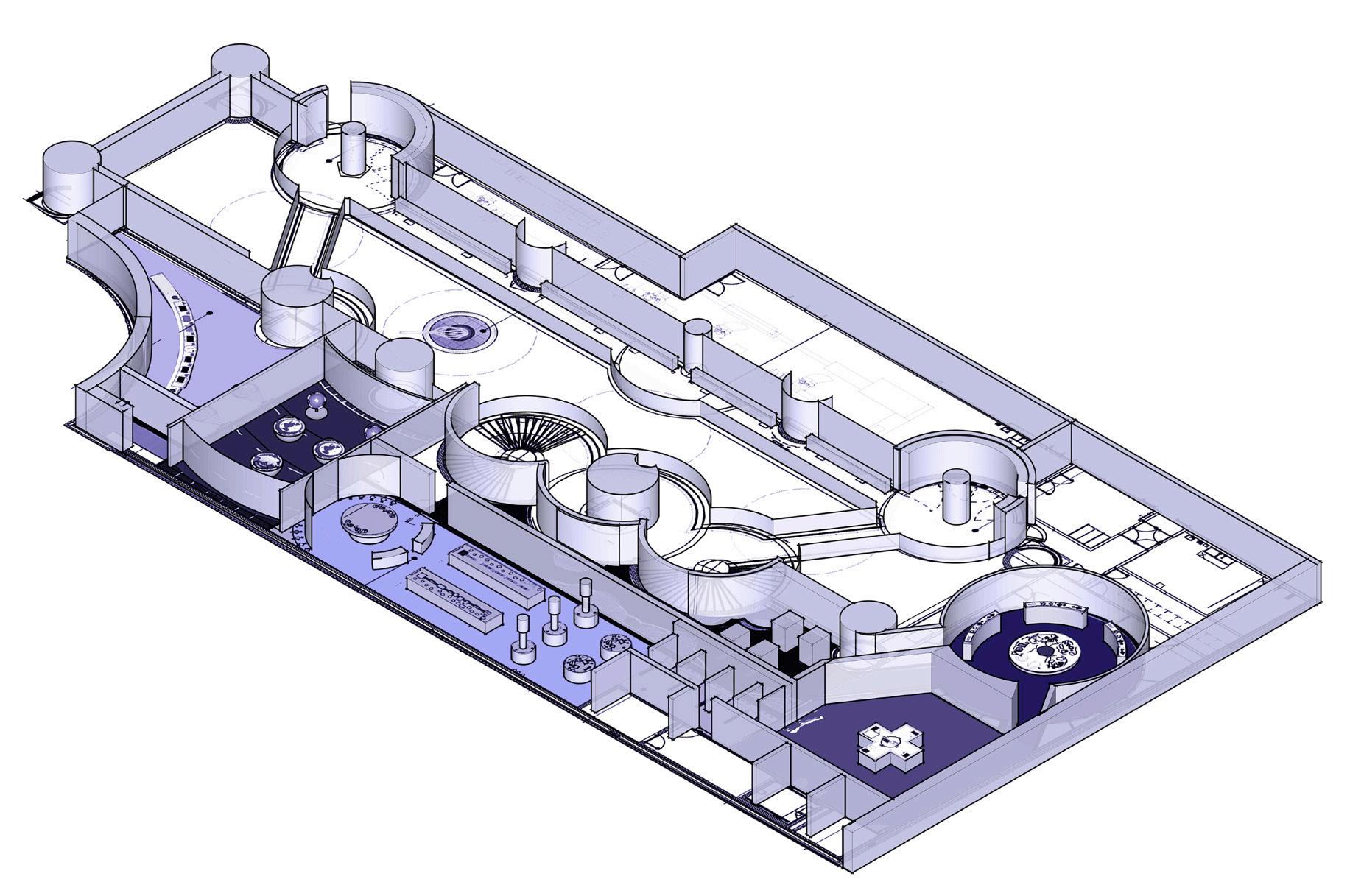
Cocoa Cultivation
The first exhibit is a journey through the cocoa plantations, where the visitors learn about the cultivation of cocoa trees. Multiple films and projections run in the room on visual displays. Walls also are illuminated with interactive displays and exhibit the processes of harvesting, drying, quality control and planting.




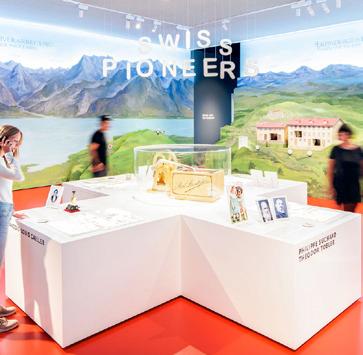
Figure 4.4.2.7 - The movement through the spaces of interactive experience of Cocoa cultivation which visual displays try to recreate the journey of Cocoa Forests.

The interactive displays act as translators of information and also create an engaging immersive environment due to which the visitors feel like they are in the plantations and are an active participant of the process of chocolate making.


Chocolate History Room
The Room is designed for visitors to indulge in the 5000 year history of chocolate. The Visitors immerse themselves in the digitally created narrative of origin of chocolate from a beverage drink made by mayans, and was later brought to the continent of Europe by Spanish in the 16th century.
Figure 4.4.2.8The interactive elements of the space narrative and allow the visitors to participate in the journey of discovery of chocolate and its transformation through centuries.
117 116
Chocolate Cosmos Production Room Cocoa Cultivation Swiss Pioneers
Pilot Plant Chocolate Fountain Innovation Lab
Figure 4.4.2.9
Figure 4.4.2.10


119 118
Experience Production Room
To make visitors experience the process of chocolate production in today’s digital world, Production Room is inspired from original factory like experience. WIth the help of models and info-graphical visuals the process of transformation of cocoa to cocoa paste is shown to the visitor.

Figure 4.4.2.12The Interactive elements invite the visitors to experiment and indulge with them and be rewarded with Lindt’s Tasty Products.
The visual incorporated films and gaming-like interactive stations allow visitors to participate in the process. Cylindrical smelling stations are also present to create an aroma experience engaging all senses of the visitors.
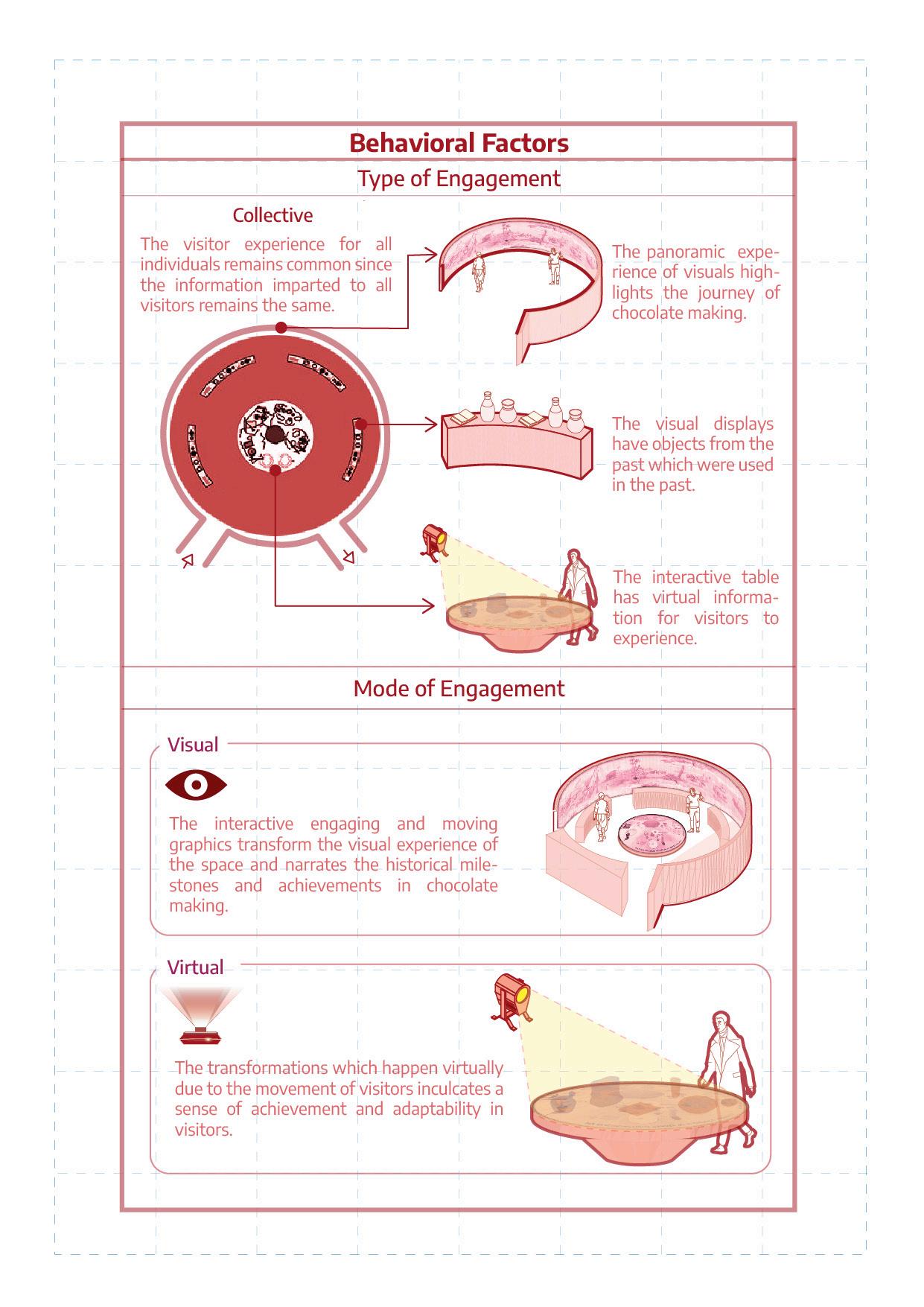


Swiss Pioneers

The Interactive room narrates the legacy of Switzerland becoming the home of chocolate. The space is designed with a cubic white symbolic cross table in the centre of the room with a red floor, which endows a special character to the narrative of the space.
Figure 4.4.2.13Manifestation of the mechanical moving systems help the visitors to engage more with the experience of swiss pioneers.
Figure 4.4.2.11
121 120
Figure 4.4.2.14
Figure 4.4.2.15

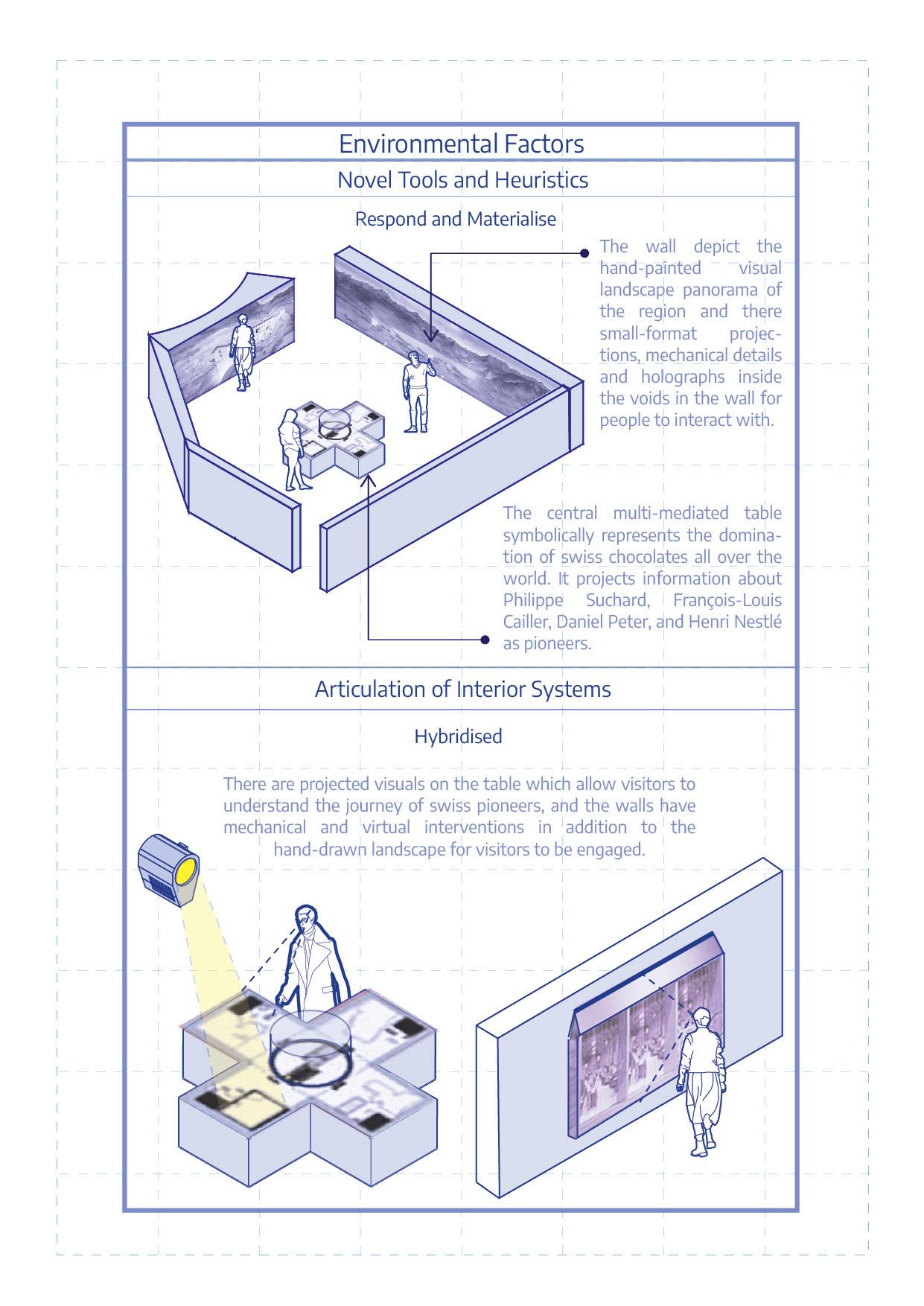
123 122
Experience Innovation Lab
On the opposite side of the bridge, The innovation lab is setup in the light filled interiors. When the visitors approach the Lab, the glass partition which was initially opaque, becomes transparent and shows explanatory films and selective exhibits, which includes replicated cell culture and robot arm.
Figure 4.4.2.17Manifestation of the kinetic system as a living envelope to mediate conversation between the atmosphere and the breather
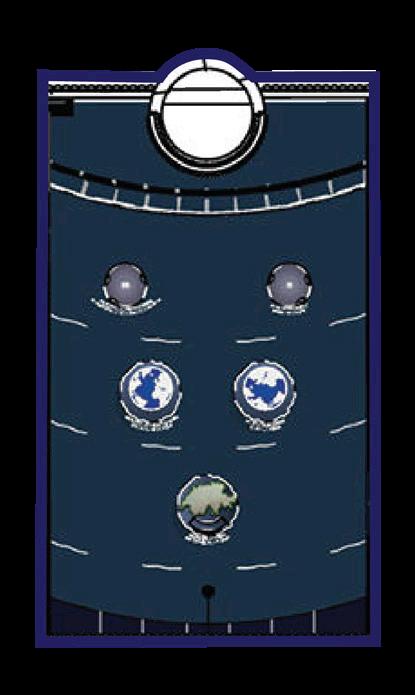

At the heart of experimentation done in innovation labs, all the real testing is visible to the visitors using media and digital installations. Augmented reality animated systems allow the visitors to see X-ray vision of the machines in the lab. All the different steps of chocolate making such as pouring, shaking to final cooling and packaging is made comprehensible to the visitors using interactive installations.

Chocolate Cosmos
The darkest interactive environment in the whole experience, the chocolate cosmos is created from media screens with atmospheric projections of stars, which tries to place the chocolate products in a global context.


Figure 4.4.2.18The Interactive Intervention of spatial systems and the lighting create an immersive out of the world experience in the museum.
Figure 4.4.2.16
125 124
Figure 4.4.2.19
Figure 4.4.2.20


127 126
Figure 4.4.2.22The levels of interactivity for each exhibit where the lowest is light blue and highest is dark blue

Key FindingAdaptation
The interactive installation allows the visitor to have control of space and embodied learning. The installations tend to focus more on collective interaction rather than personal. The audience engagement tends to focus on the performative and reactive interactions with the spaces and uses physical, virtual, and acoustic models as approaches to interacting with the visitors.
The Lindt Home of Chocolate provides the larger set of audience with a unique museum which offers in-depth information platforms for all matters which concern the chocolate industry. The museum also finds interactive ways to provide a glimpse into the secrets which the brand has. This helps the audience develop feelings for the brand’s innovative approach and luscious chocolates.

Design Synthesis
To understand the transformation of museology in the digital age, understanding the use of technology is not sufficient to understand the impact on experience.
Rather, it is important to understand the impact and transformation of practice as well as the multi mediated approach to understand the new shift.
Figure 4.4.2.21
129 128
Innovation
The experience aims to recreate the journey of chocolate making and the innovative approach of the designers to employ augmented reality and multimedia installation to increase the ability of visitors to engage with the informed journey and understand the significance of chocolates.
The spatial narrative of museums in the digital age is defined by the distinctive ways the spaces are transformed and explored by visitors. With a drastic shift in society’s culture, the museum slowly adapts to the new narratives.
The modern museums are transforming from an early placesbased cultural institution towards a more dispersed modern space approach.
Today’s Museum environments are designed to support technologyenhanced learning. Integrating technology in the learning environments can help visitors engage more with the museum’s spatial narrative and experience. Museums wish to create immersive spaces and exhibits to make intimate connections between the viewers and the portrayed subject.
Figure 4.4.2.23The Target Audience for the interactive experience of Lindt Home of Chocolate Museum.
This page is intentionally left blank

131 130
4.4.3
Case Study III
Plinthos Pavilion, Greece
About:
The spatial interactive system is designed by the Greek architects, MAB Architecture for an Interior Design Show to explore if it is possible to add transparent or translucent quality through technology to an opaque object.
Clay bricks, which are one of the most utilized materials since ancient times, has been utilised in creating the pavilion. The material, Clay Brick, remains an important symbol of reliability and solidity for human scale and has also been appreciated for its aesthetic sensual qualities. But, in the pavilion, the designers have tried to explore the similar characteristics and create an additional quality of the material through design which is transparency, which is not usually associated with the clay brick.
The Pavilion is designed using 21816 clay bricks in its continuous wall and floors. The perforated side of bricks are placed in exposure to create a porous surface for flow of sound, light and air. The pavilion creates an experience which the visitors feel like the room is breathing. The visual transparency which is due to horizontal placement of brick in the wall, becomes a channel for interaction between the structure of the pavilion and the visitors.

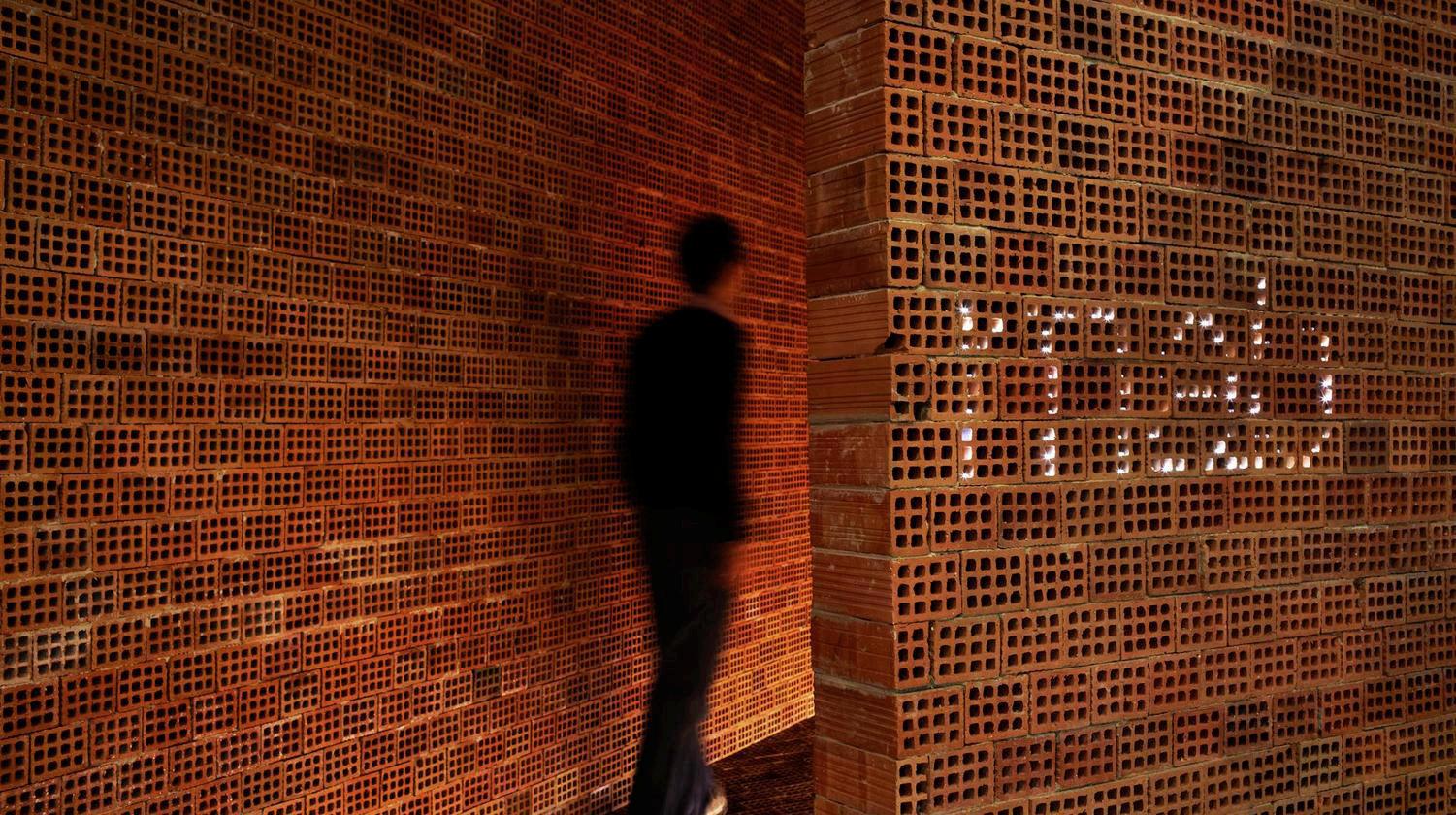
Figure 4.4.3.1The Pavilion’s Entry point where the visitors are curious to see whats inside but the shell is designed in such a way that one cannot see until they move in
Figure 4.4.3.2The completely immersive environment of the pavilion provides the visitor a break out space to experience the transformations.
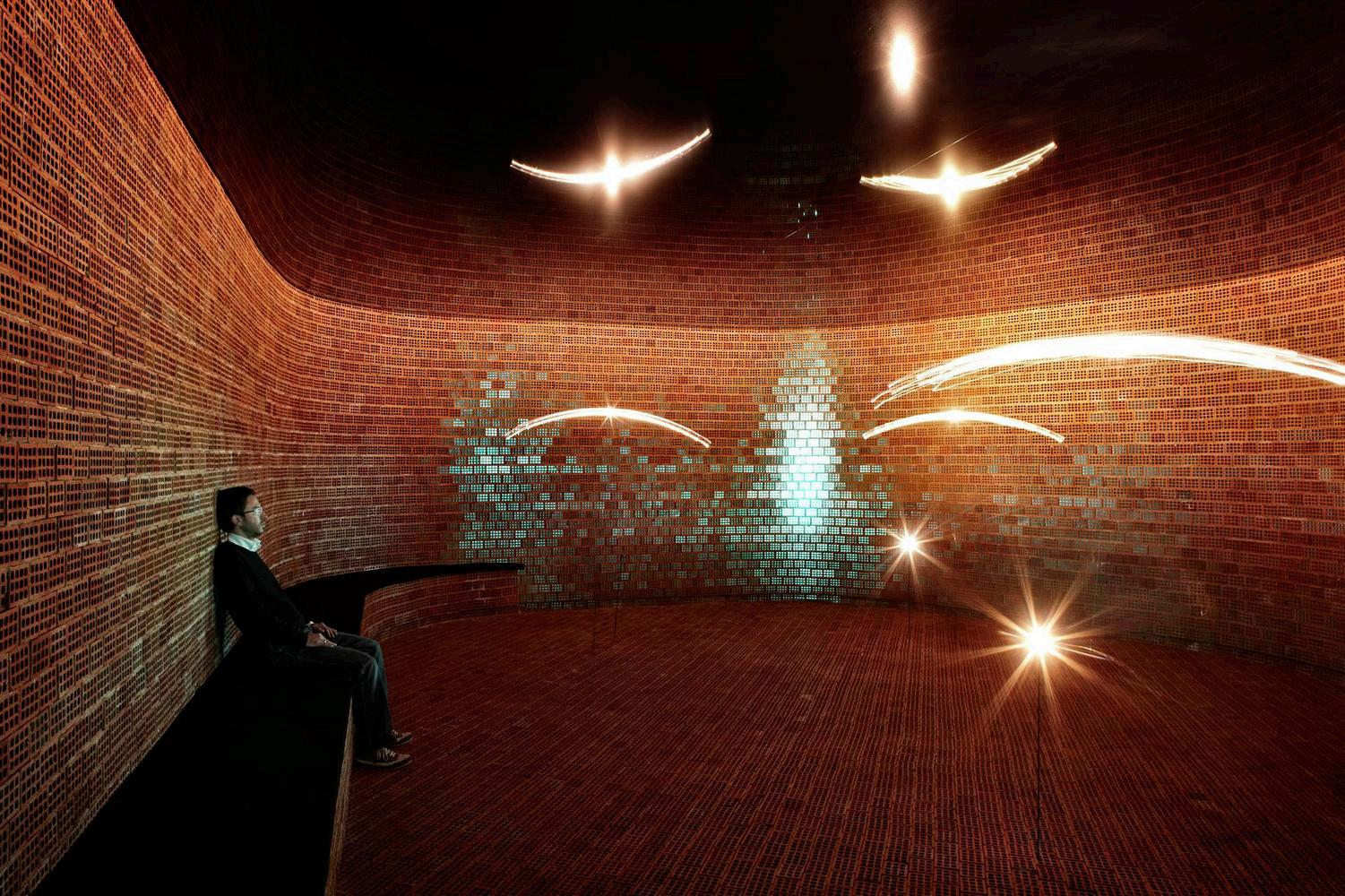

The expanding RGB light and the constant background soundscape constantly communicate through the wall, which completely transforms the pavilion into a living organism in which visitors get completely immersed. The experience of the pavilion is multisensory and immersive
Figure 4.4.3.3The interactive elements such as the lights and brick’s porous surface creates an effect of transparency in space
It completely binds the memory of ancient construction and tactile emotion of the rough surface of brick to the new stimulating sense of the time passing by with the help of new advanced technologies. The design relates the past with the future. The pavilion consists of a spatial skin with an additional embedded sensorial skin, which enables the transformation of the space to an experience of subliminal exploration and inner discovery of oneself.
133 132
LocationAthens, Greece Interactive ModelIntelligent TypologyPavilion Exhibit DesignersMab Architects Year2011
Spatial Narrative
Programme
The pavilion transforms into a space for contemplation and exploration - it becomes a sanctuary for the senses - which allows the visitors to experience the spaces through the lenses of technology. The fluid spatial design invites its visitors to move about and navigate through perforated spaces and develop intimate relationships with the beautifully articulated poetic expressions.
Figure 4.4.3.4The construction of the pavilion was done inside the exhibition space
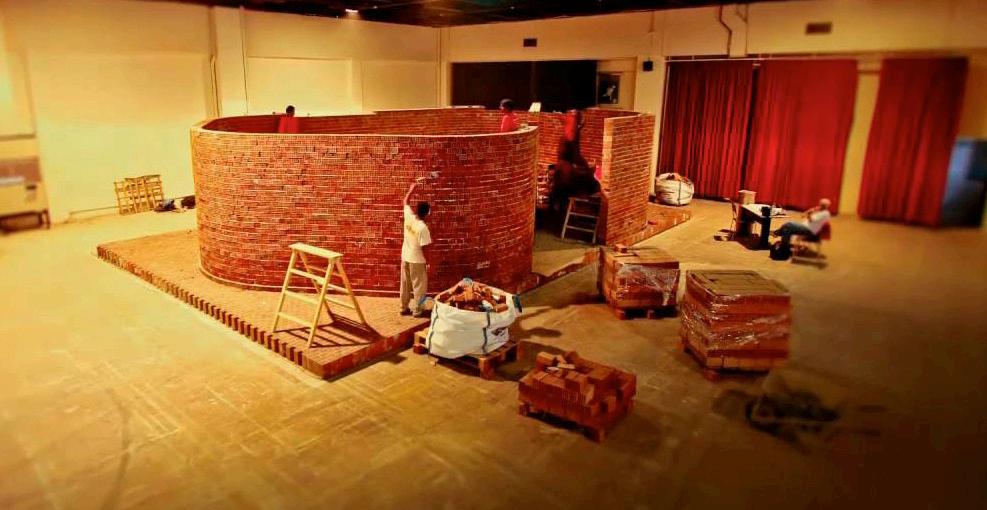
Spatial Organisation

The whole structure is constructed in an exhibition space, inside a black blax with only one entrance to the experience. The spatial void between the inner brick skin and the outer skin of black box acts as a service area to conceal all interactive mechanisms from visitors. The theatrical entrance allows visitors to be curious about the experience as it reveals a very information about the inside. The visitor transitions from a well lit exhibition space to a monochromatic, all-brick and dimmed interior.
Figure 4.4.3.5Transformation of Plan during the development of the pavilion to create maximum curiosity
The interior space breathes from the porous and permeable surface of its wall and floor. A constant adapting RGB lights and background sound scape are communicated through walls, which transforms the space into life-like organisms.

Narrative of Space
Hence, the Plinthos pavilion speculates towards the possibility of a spatial system which consists of multiple layers of sensory perception and provides the visitor with an effective and meditative experience which provokes their senses, desires and feelings.
Figure 4.4.3.6The interactive layers in the development of the pavilion.
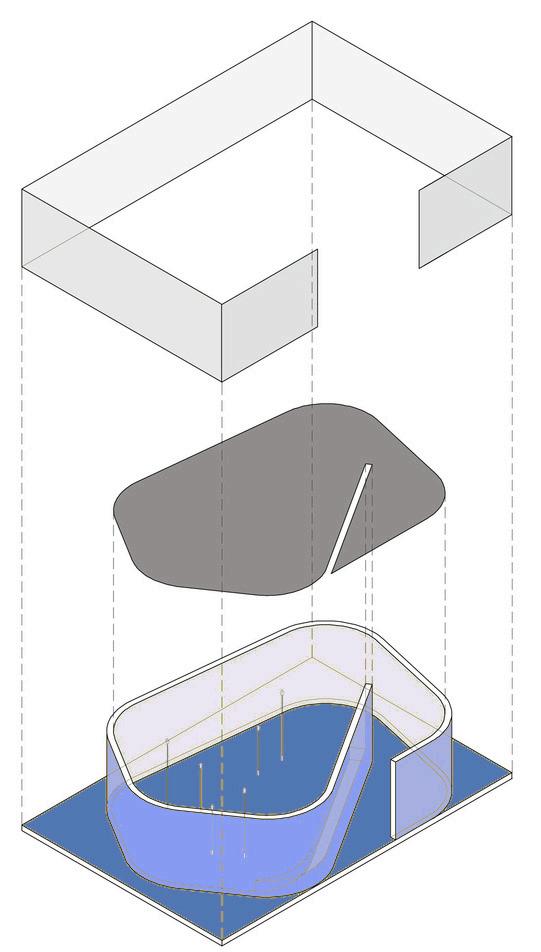

Interactive Narrative
In addition to the hard and porous brick surfaces, there are many ubiquitous layers of mediated systems and technologies in the void so that they can blend harmoniously into the responsive and performative spatial interaction. Every layer had a critical role to produce a specific outcome. However, all the layers of interactive elements channeled communication to display orchestrated intelligence.

Figure 4.4.3.7Visual responce created by the porous walls with respect to the movement of the visitors which entice them to interact more with the space.

Interaction + Physical + Digital
In the void behind the vertically rotated stacks of brick walls, huge rolls of wrapped reflective white paper acts as a protective barrier which fulfills the purpose of reflecting the lights which are emitted by the interconnected series of LED bars which are present at the bottom of the exterior walls.
135 134
The lighting fixtures are moved in the direction of the white paper to ensure the reflection of uniform light coating which can be easily visible from the transparent brick open cells in the interior. The compositions of the light are never in stasis, they keep oscillating throughout the duration with multiple combinations of patterns to adapt to the real time effects of the events taking place inside the structure’s interior.


The algorithm for computer vision analysis is developed to analyze and scan the multiple number of visitors interactions, which are circulation, motion, presence, energy, formation clusters and position.

Figure 4.4.3.8The isolated program in the environment encourage the visitors to spend more time inside the space.
For developing a natural experience, real-time sonic auditory compositions are substituted to the effects of the light to create an enhanced feeling of immersion and extend the levels of perceptual with aid of aural excitation mechanisms.
Different layers of composition are generated from a large number of synthesized and per-recorded sound files which were fed into the main system. The final combination of sounds is henceforth projected from the speaker which encompasses the environment. All the interaction mechanisms are hidden below the hard structure.

Figure 4.4.3.9The placement plan of interactive elements of the space inside the pavilion. The visual elements are placed inside whereas the Interactive elements are concealed within the void between inner and outer shell
Figure 4.4.3.10
137 136
Figure 4.4.3.11 Figure 4.4.3.12

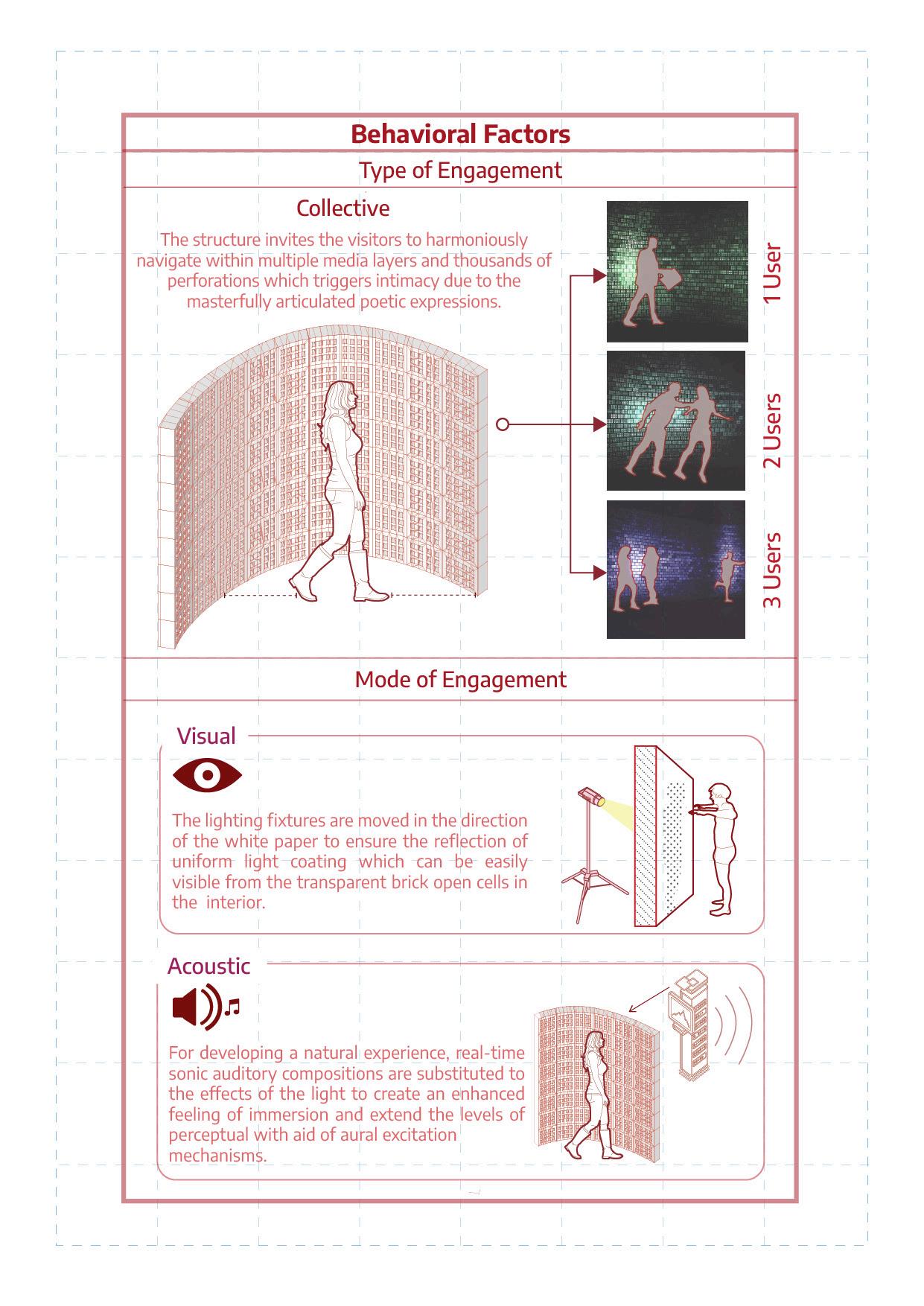
139 138
Key Finding -
Adaptation
The media prosthetics are the most fundamental and essential elements of this hybridized and cyborgain object, giving the authority to the visitor and mediating and adapting the structure’s porous surface into a mystical and ritualistic organism which reacts, communicates and breathes.
Design Synthesis
Looking deeper into the aforementioned technologically embedded systems and the abilities of Plinthos Pavilion, one can understand that this development has been manifested as result of an interdisciplinary collaboration and is synthesized from a high level of sophistication with the aim to create a memorable experience.
The technology and media, being fundamental in the design of such a sensate environment, allows the visitors to interact with the physical structure at numerous levels.
Figure 4.4.3.13The transformational program of the space due to the interactive elements imbued.

Figure 4.4.3.14The perception of light translates into visitors perceiving the quality of space as transparent instead of opaque, a quality which has been associated with Brick.

Innovation
The ultimate goal of the pavilion is to increase the possibilities of the experiential spatial environments to post-digital culture, and also to evaluate and explore the hybridization of interiors with the help of embedded and encoded media systems which create a strong contrast with old hard surface with the responsive and ethereal qualities of the new computational technologies and media.
This page is intentionally left blank
141 140
4.5 Comparative Matrix
Novel Factors of Spatial Adaptation

We can further evaluate the three different interactive spatial environments based on novel approaches for spatial optimization and adaptation. The Interior designer plays a sensitive and essential role in synthesizing such spaces as it is crucial for understanding the user and program-specific needs.
The six factors which influence the psychological and environmental effect on visitors of space are utilized to understand further the significant difference in the experiences of the case studies.
These experiences are quantified to understand the impact of interactive encoding systems in interior environments.
Measuring the impact of such factors allows us to understand how different interactive modes transform the space and how significant interior decisions such as the scale of the element or space, program, time, locus of control, arrangement, synchronization, symmetry and materiality play an essential role in creating intelligent interactive systems.
Factors such as juxtaposition, absence, repetition, superimposition and deformation hold a significant place in techniques utilized by designers to create virtual change and motion in such environments (Terzidis, 2013). The architectural shell might suggest the space to be steady, immobile, stable and sturdy. Still, through interactive intervention in spatial elements, the experience suggests unpredictability and agility, implying liveliness and change in spaces
Initiative of Interaction Ease of Communication
143 142
Starbucks Roastery, Milano
Lindt Home of Chocolate Plinthos Pavilion
Levels of Integration Scale of Interaction
Locus of Control Modalities of Interaction
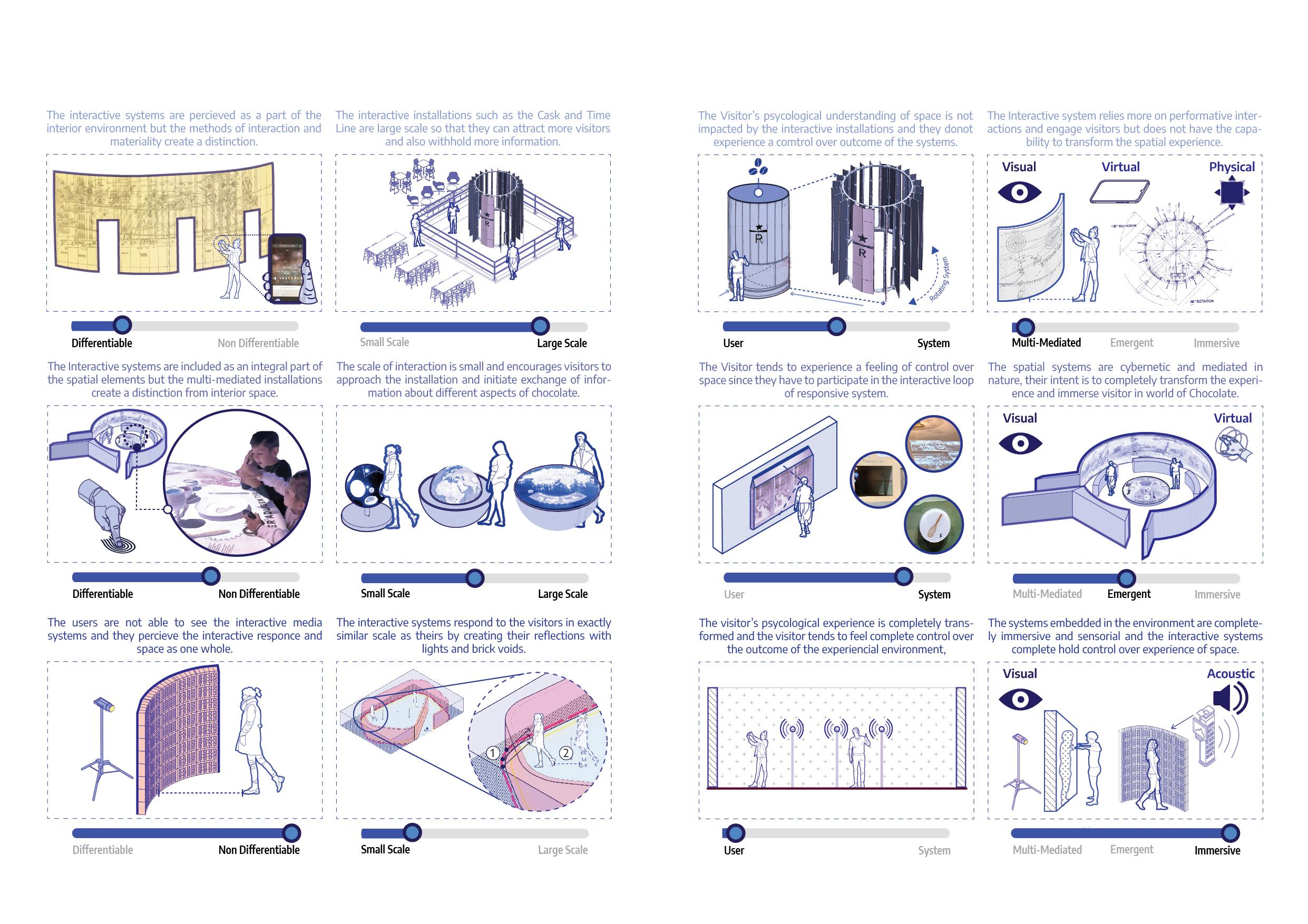
145 144
4.6 Inference
The intervention or development of interactive systems has drastically transformed the experience of interior spatial elements. Through such systems, the spatial environments gain the capability to adapt to our desires and change the ability of the spaces to shape our experiences. The case studies based on three different interactive models highlight the dynamic possibilities of such innovative interior environments.
In all the interactive environments studied, there was an immense presence of built precedence, which is driven towards evocating the visitor’s feelings, which provide them pleasure by enabling social engagement and contributing to the educational benefits.
All the programs lie in the domain of public spaces, and we observed that all spatial and artistic elements such as sculptures, exhibits, facades, fountains and furniture had embraced interactivity as an accessory or a vital component to capture the attention of the audience. Museums have started to embrace the interactive systems concerning the societal demands of viewing and presenting the exhibits and artifacts.
Figure 4.6.1The evolution of parameters for interactive experience design and its impact on the spatial design.


Interactivity in combination with spatially adaptive systems enables designers to create changing displays of temporal nature and entice the visitors to experience something new every time.
Lots of the interactive exhibits in Lindt Home of Chocolate or Starbucks have incorporated kinesthetic learning with the entertainment experience, allowing space to have an additional educational component. All the interactive applications enable the visitors to utilize their mind and bodies in collaborative ways, such as Plinthos Pavilion.
Figure 4.6.2The Novel Factors of Spatial Adaptation are mapped to compare the levels of interactivety in spaces
The Plinthos pavilion manifests the most interactivity in spatial systems followed by Lindt Home of Chocolate and lastly the Starbucks Roastery through factors of adaptation.
All the analyzed projects in the case studies highlight a critical dimension of the transformation brought about by physical and virtual change and the importance of time as a tool to design such spaces.
Marshall McLuhan, a famous philosopher, lists the three main pleasures that are intensified uniquely by using media and technology in space - Immersion, Rapture and Agency.
Immersiveness is the sense of transportation of the visitor into another reality. Rapture is the capability of entranced devotion or attachment to systems and objects in that reality. Agency is the visitor’s perception or delight of having an impact on the interactive environment.
From the lenses of entertainment, an engaging environment is deemed successful upon completion of all these factors. All the different spaces work successfully at various levels to exhilarate emotions and add new capabilities in the space and program.
147 146
Conclusion of the Research
[En]Coding as a phenomenon for interactive systems Enhancing user experience through sixth sense Sensorial Environment as a Need Innovative Interior Practices
Re-Interpreted Role of Interior Designer Future Research
149 05
05
The new approach brings a lot of new learnings and challenges for the designers. Through the research and observations previously conducted, the implementation of these approaches is decoded so that the research can aid the interior designers to articulate their strengths and capabilities.
It can also help position the role of design, technology and user in the current practice of interior design.
• [En]Coding as a phenomenon for interactive systems
A new way of thinking and being has emerged by enabling spatial environments to be interactive, intelligent, adaptive, responsive and sensate.
Information is considered an immaterial and dimensionless entity, which can be constructed onto or embodied within a system.
The newly proposed spatial systems are unique in their behavior and need to be deconstructed to understand their unique interactive and performative capabilities in physical space. Gordon Pask and Cedric Price’s Fun Palace was one of the first intentional physical manifestations of information and communication in space which sets the initial example of the physical environment that can be perceived through human-computer interaction.
With hybridised interactive spaces, where space is developed by the virtual facilities and the physical realities, space redefines its understanding of dimensions and transcends beyond physical or digital.
Interactive environments become spaces with four dimensions where the perception of the space transforms through different concepts of time, and the programmatic elements of space are evolved as dynamic and active systems. Such spaces allow the user to choose when to see and what to see.
Figure 5.1The intersection and amalgamation of various different disciplines which transform the experiential quality of environments and introduce a fourth dimension
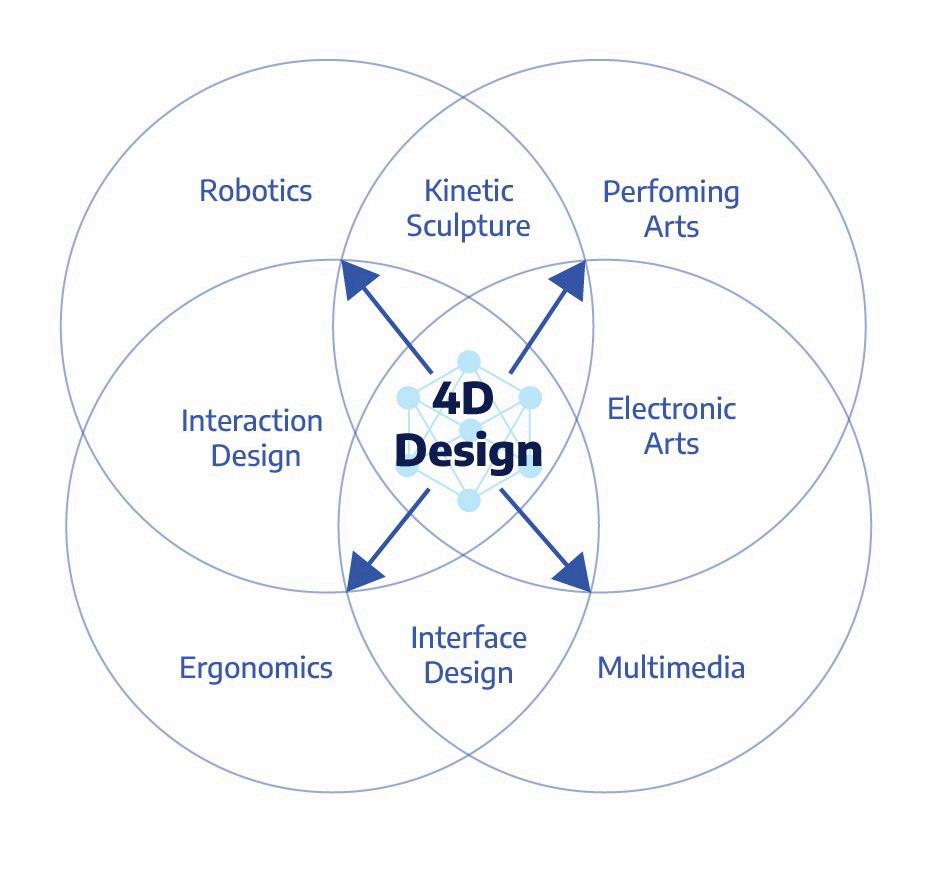
• Enhancing user experience through sixth sense
The human experiences the environment around them with five senses to perceive the information, which helps them make decisions. Nevertheless, the most critical data and knowledge humankind has accumulated is not visible to the five senses of humankind.
However, with the help of new evolved relationships emerging between users and interfaces, there is an increased manifestation of information and user control through intertwined digital and physical spaces.
The tool to develop such an interactive (communicative) system is the technology that acts as a sixth sense to add a layer of visual, auditory and sensory intervention to synthesize information to users. In a communication system, people who perform the interaction and the elements that encode the information constitute the part of the system.
Similarly, in any interactive system, its participants or inhabitants, who perform the activities within the environment, are inherent to its approach as much as the built environment elements. The design of such a system involves the capability of a designer who understands the synthesis of information in digital format and constructs it into a physical narrative.
151 150
5.0 + Conclusion
Figure 5.2The sixth sense technology visualized by Pranav Mistry which is a wearable gestural interface which can be utilize the digital information to augment the physical world around us
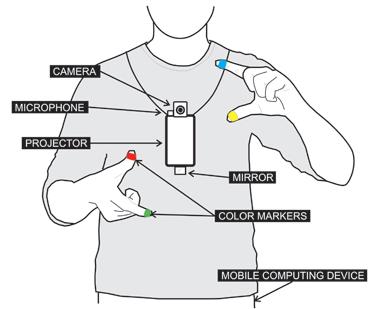
• Sensorial Environment as a need
With the advancement of technologies, human needs and abilities are also transforming. In the age of human-computer interaction, computer-based technologies are transforming and creating new societies.
The new technology transforms the way we see things, but it does not impact the way our communities and culture want to experience a space.
With new demands for integrated spatial information based environments, the vernacular environments develop a new complex system of interactive environments through interior design practices.
The need for such systems has evolved from the evolved desires of people who communicate which technological systems throughout their day. Interaction in spatial environments allows the users to perceive and transform the same physical spaces differently than the other users.

Figure 5.3The interactive interventions created by the Akshardham Mandir to create a sense of divinity and spirituality. Such interventions allow greater group of audience be exposed to the experiential quality of technology.
Figure 5.4The show OK Computer was recently aired on Hotstar. The Narrative of the show highlights the transformation in India due to innovation. The famous museum Dandi Kutir was shown many times in the show as the most technological and innovative building. In reality also, the interactive experience of the museum has transformed the journey of truth and freedom lead by Mahatma Gandhi. The experiences completely immerse the visitors to experience empowerment and empathy.
This capability of personalization of space attracts many different users from many different social backgrounds and encourages different demands and desires from each individual. Such interactive hybrid environments may not necessarily be permanent, but can be more instant and personal. Including interaction can help designers transform mute environments into lively spaces with minimal changes.


Hence, the purpose of the spatial environment has transformed to flexible and responsive from permanent and stationary. These interactive environments with qualities like adaptability and transformation can be the answer to the needs and requirements of the digital society who prefer to stay up to date all the time.
• Innovative Interior Practices
In design, space is considered a boundless three-dimensional expanse in all objects and inhabitants occupy as relative direction and position (Encyclopedia Britannica, 1998).
Every dimensional expanse is considered a space in the perception of an actor, who experiences it within its physical constraints such as time, dimension and gravity.
The re-imagined role of the new age designer is to understand the role of physical actors of space and understand the impact of manipulation of interactivity on spatial performance.
Such an approach requires understanding and synthesizing many design decisions, which is only possible when designers with different specializations and backgrounds collaborate in a transdisciplinary approach.
153 152
Figure 5.5 -
At MIT Media lab, researchers Leonardo Bonanni and CHai-Hsun Lee designed a kitchen with graphical user interface to transform the capabilities of the space and allow the user to experience better performance due to augmented reality

The sensing, processing, and output concepts are now embedded in everyday life objects and space elements instead of electronic computers. Henceforth, the designers of space are confronted with queries regarding how such systems in everyday built environments affect the behavior of users and how they will transform the usage of space in the future.
The capability of confronting interactive scenarios at an interior spatial scale and habitability issues such as convenience, apprehension, ethics, and privacy lies with the expertise of interior designers and their participation in the future of interactive environments will allow a more significant dialogue on how such contemporary technologies will develop.
Figure 5.6The interactive intervention allowed the users to be more spatially aware of activities going on and multi task. The fridge was also transformed such that the users can visually see the contents which opening the door.

• Re-Interpreted Role of Interior Designer
Interactive spatial design has a unique opportunity to influence and reposition the role of interior designers positively. The role of the designer should focus more on catalyzing how the technique should evolve.
Designing an interactive spatial environment should be like an emergent endeavor that fosters a futuristic design solution platform. Developing such a system is a profound and noble position. It implies that the designer should understand the people in-depth to create solutions for them and create design tools and interfaces that allow the participants or the users to become their designers.
For example, the smart phones utilized in today’s world by everyone have become a catalyst for ideas and designs that are never intended. The interior designers are well suited and equipped to design and conceptualize interactive systems in interior spaces because of their professional experience and background in understanding the environmental and user demands and visualizing space. For designers to take an active role in the development of interactive environments, it is necessary to have a contextual understanding of the history of interactive environments and understand the driving forces which primarily reside outside the field of interior architecture.
One of the significant benefits of interior designers becoming interactive designers for spaces is that their indepth knowledge of building materials, interior services, unique elements and structural systems allow them to design more optimum solutions of how interactive system could be applied in the built form, structural system, mechanical system or spatial elements and how will user perceive them in space.
Interior designers are also knowledgeable of the relationship between the built environment and desired user activities and can predict how such relationships are well facilitated.
155 154
5.1 + Future Research
“ Despite the obvious implications for the built environment, architects have been largely absent from this discussion, and technologists have been limited to developing technologies that take existing architectural topographies as a given context to be augmented. The recent fascination with building envelopes consisting of large-scale programmable urban screens or corporate lobbies outfitted with so-called interactive architecture highlights the dilemma.”
(Greenfield and Shepard, 2007).
As specified in the above quote, most of the examples of interactive systems comprise the additional layer of interactive technology over spatial systems. But slowly with development in kinetic systems, the spatial elements and the structural system also become a part of the interaction.

With the new and evolved approach of designing interactive systems with the goal to manifest sensorial environments, interior design practices have evolved to gather many design decisions together. Newly emerging technologies are hence utilized in designing narratives with help graphical, environmental and lighting design solutions.
The interior designers today are now designing spaces for new evolved narratives in society with technology as a tool of empowerment. Interaction becomes a new approach to communicate to the needs of society in the digital age.
Future research and transformation of the field of interactive interior design will evolve from understanding how much role should be provided to the participants or the uses of the space and how much should the user be able to interpret the special environment.
The field of interactive built environment is at the end of the beginning of a new era of spatial environments. The subject of these new interact systems has many unanswered queries such as will it be able to bring transformation into areas of global issues or sustainability, will it be able overcome all kinds of failures, will it become economic.
As much as interactive system are visualised being truly seamless and hidden within the fabric of all integrated built environments, it is also important to recognise and understand the importance of good design solutions and it’s protagonists who will help define relevance of such transformations in the future.
157 156
i i
Glossary of Terms Reviews and Actions
159 158
I.I Glossary of Terms
Actuator: They are the control element maneuvered by a signal that initiates enough power to operate and run a mechanical element. Common actuator types are pneumatic, hydraulic and electromechanical.
Adaptation: Adaptation can be defined as the ability of the space to be flexible enough so that it can accommodate the changing demands of the spatial system concerning its users.
Agency: Agency is the visitor’s perception or delight of having an impact on the interactive environment.
Artificial Intelligence: Artificial Intelligence is the capability of technology to perform activities usually associated with human intelligence, such as stimulus-response and recognition.
Augmented Reality: Augmented reality a virtual or composite view that is created from an actual scene overlaid.
Biomimetic: It is the imitation or the replication of the nature of the study of the function and structure of biological substances.
Encoding: Converting (information) from one method or system of communication into another, converting (message) into a code.
Embodiment: It is the experience in which the human experiences sensory capabilities, and consciousness takes on material and spatial form.
Evolution: The phenomenon of growing any system of design in a natural way which is by transforming the environment which significant transformations in its nature and stimulus-response, capability and quality
Immersive: Immersiveness is the sense of transportation of the visitor into another reality.
Interaction: Interaction is a continuous transfer or exchange of information in both directions or between two entities
Interactive Environment: Environments that demonstrate autonomous behavior, in which the evolution of behavior is stimulated from the Interaction with its environment and the users. An evolved entity capable of constant adaptation to the ever-changing environment in which it operates.
Rapture: Rapture is the capability of entranced devotion or attachment to systems and objects in that reality.
Sensor: A device that can quantify its energy exchange to provide the data to an external device or actuator to initiate interaction
System: articulated set of elements bound by its designer and inhabitant in structural and functional relationships, exhibits the system’s spatial behavior.
Trans-active Intelligence: Architectural intelligence that transforms and transacts both itself and the user in addition to interacting with them.
Ubiquitous Computing: The phenomenon of interactive and computational devices being harmoniously integrated into daily life experiences, products and space.
User Experience Design: The process used by the design teams to create spaces, experience, or human-centric products that can provide the users with relevant and meaningful experiences.
161 160
I.II Reviews and Actions
First Thesis Review Feedback - 19 January 2021
Review Panel - Mr. Anand Belhe, Claire Reuter
Feedback -
• Simplify and narrow down the terms for a better understanding of the topic and thesis.
• Implications of adding technology-based solutions could be added to the research
• Define the criteria for the case study, will it be in the public sector or private sector?
• Understanding the intention of a designer to design that particular technological design solution instead of another can help in understanding immersive experiences. (Reference shared from Amardeep Behal sir’s project)
• Understanding the scope of innovation will help in making a unique point
• Understanding the users need is essential.
• Understanding the initial stages of process development can help in analyzing case studies
• Detail out methods or frameworks on how to analyze case studies
Actions -
• The need to understand the implementation of technology-based solutions was added to research framework
• The case studies were chosen from built projects from the public sector and based on the evaluation framework which focuses on interactive nature of environment spatially.
• Inclusion of parameters into the theoretical framework which look at the intention of designers to create interactive systems.
• A part of the research detailed to understand the innovative approach of design and its impact on users and practice
• The initial approach to designing solution as an interior designer was added to criteria to select and conduct case studies
Second Thesis Review Feedback - 23 February 2021
Review Panel - Mr. Anand Belhe, Claire Reuter
Feedback -
• Simplify methods of explanation and use visual diagrams and images to explain the theories
• Ensure the interior designers remain the target audience.
• Identify methods for conducting case studies.
Actions -
• Multiple info-graphics, visual and diagrams added a part of understanding and explanation in case studies and chapters.
• The focus remains on the program, spatial experience, and interactive intervention or development in spatial systems.
• The framework is constructed from understanding various factors which influence the user’s experience and spatial program of interactive space.
Third Thesis Review Feedback _ 23 March 2021
Review Panel - Claire Reuter
Feedback -
• Devise a conclusion for each case study so that it helps connect this conclusion to the final conclusion.
• Can time, the visitors, and location play an important role in developing or understanding the narrative of interactive space?
• Highlight how the interior designers are integral to the designing process of such spaces. Bring out how they play an important role in envisioning the interactive environments.
• Mention in the conclusion the importance of interior point of view in each interactive environment.
Actions -
• Critical inferences highlighted for each case study and comparative matrix was made to analyses and understand the differenced between interactive modes pertaining to each case study
• The novel factors of spatial optimization focus on the transformation of space and the control of time in developing interactive spaces.
• The role of interior designer is focused upon and highlighted in the case studies and comparative matrix, and based on the inferences, the role is re-positioned in the conclusion.
163 162
Final Thesis Viva Feedback - 19 May 2021
Review PanelExternal- Mr. Jwalant Mahadevwala , Internal- Prof. Kaulav Bhagat Viva Chair - Prof. Amal Shah
Guide - Mr. Parantap Bhatt Co-Guide - Prof. Kireet Patel
Feedback -
• The case studies could have had an insight into how the technology directly creates the spatial experiences and what particular capability they added to the space
• Action - The studies focus on the critical aspects of design thinking and interior program and experience. The intention to study the different interaction models is driven by the need to decode the different approaches of interior design in such systems. The focus remained on how behavioral and environmental factors are added into the space.
• This research could have been done in an essay based format without the case studies.
• The case studies are conducted in the research to establish the roles of different interactive systems in interior environments and their impact on the experience of the visitor/user.
• Are the interactive spatial environments a novelty or a necessity.
• Today, the environments remain as a novelty due to lack of its presence in the spaces around. Slowly with utilization of technology in various different programmatic environments in public and private sectors, we may see a change in society where interactive environments become a necessity. Just like smart-phone, which were once considered a luxury, innovative interior systems could possibly become more essential in future.
• Accessibility is an important requirement which could have been analyzed through the case studies and critiqued.
• Universal design is an important factor which should taken into consideration for future research conducted on this particular topic.
A Note to People who refer to this research -
This research has been conducted in a very critical time period of COVID - 19 pandemic with lot of restrictions. Due to this, to possibility to visit and analyse the case studies to generate research became a challenge. Several critical factors could not be studied and the study relied on the Online verified resources.
Being the last batch of Faculty of Design, CEPT University to complete Thesis program, I would like to request all those who find these topics and research field interesting to find a way to continue research into this field.
This field encompasses numerous opportunities for the future of Interior design and it is essential that we become the protagonists of this innovative process which allows a more intimate connection between the users and the spaces. I hope this research aids the future researchers and readers in creating new outlook towards design and exploring the unimaginable future of spatial experiences.
Anyone who would like to know more about this thesis, or information related to it, can reach me via email or Linkedin.
Ishani
Pandey
( 24-05-2021 )
Ishanipndy.ip@gmail.com https://www.linkedin.com/in/ishanipandey/
165 164
ii ii
Bibliography Image Citations
167 166
Published Books | Research Papers -
A
Amini, M.; Mahdavinejad, M. and Bemanian. M. (2019). Future of Interactive Architecture in Developing Countries: Challenges and Opportunities in Case of Tehran, Journal of Construction in Developing Countries, 24(1), 163–184.
B
Beesley. P. and Khan. O. (2005). Situated Technologies Pamphlets 4: Responsive Architecture/ Performing Instruments. New York: The Architectural League.
Beesley. P., Hiroue, S. and Ruxton, J. (2006). Responsive architecture, subtle technologies. Cambridge: Riverside Architectural Press.
Bouman, O. (2002). Hyper Architecture. Kas Oosterhuis– Programmable Architecture.
Boucher, M., Helmreich, S., Kinney, L. W., Tibbits, S., & Uchill, R. (2019). Being Material (The MIT Press). Massachusetts, United States: The MIT Press.
Boychenko, K., (2017). Interactive Architecture: development and implementation into the built environment. European Journal of Technology and Design. (5) 20-25.
Brown. G. (2003). Introduction to transportable environments. 2nd ed. Robert Kronenburg, London: Spon Press.
Bullivant, L. (2005). 4dspace: Interactive Architecture (Architectural Design) (1st ed.). London, United Kingdom: Academy Press.
Bullivant, L. (2007). 4dsocial: Interactive Design Environments (1st ed.). London, United Kingdom: Academy Press.
Bullivant. L. (2005). Interactivity at the Centre of Avant-Garde Architectural Research. published, by Wiley- Academy. 75 (1). 62-67.
Capeluto, G., & Ochoa, C. E. (2016). Intelligent Envelopes for High Performance Buildings: Design and Strategy. Springer.
Castel. H. (2005) 4D Space: interactive architecture, Architectural design. John Wiley & Sons/ Wiley-Academy.
Chan, S., & Cope, A. (2015). Strategies against Architecture: Interactive Media and Transformative Technology at the Cooper Hewitt, Smithsonian Design Museum. Curator: The Museum Journal, 58(3), 352–368. https://doi.org/10.1111/cura.12118
Cotrufo, N., Saloux, E., Hardy, J. M., Candanedo, J. A., & Platon, R. (2020). A practical artificial intelligence-based approach for predictive control in commercial and institutional buildings. Energy and Buildings, 206, 109563.
Cristina, G. D. (2001). AD: Architecture and Science. London , UK: Wiley.
D
Delft University of Technology (TU Delft), & Tomasz, J. (2013, February). TOWARDS A METHODOLOGY FOR COMPLEX ADAPTIVE INTERACTIVE ARCHITECTURE. Architectural Engineering + Technology. Retrieved from https://repository.tudelft.nl/islandora/object/ uuid%3Aa81827c5-7d65-4cc7-9fab-20fab3a14c30
E
El Sayad, Z., Farghaly, T., & Hamada, S. (2017). INTEGRATING HUMAN-CENTERED DESIGN METHODS IN EARLY DESIGN STAGE: USING INTERACTIVE ARCHITECTURE AS A TOOL. Journal of Al-Azhar University Engineering Sector, 12(44), 947–960. https://doi.org/10.21608/auej.2017.19180
Eslamirad, N., Kolbadinejad, S. M., Mahdavinejad, M., & Mehranrad, M. (2020). Thermal comfort prediction by applying supervised machine learning in green sidewalks of Tehran. Smart and Sustainable Built Environment.
F
Fox, M., & Kemp, M. (2009). Interactive Architecture (1st ed.). New York , United States: Princeton Architectural Press.
169 168 +
Bibliography
C
Fox, M. A., & Chen, Y. (2010). Interactive architecture will change everything. Decoration, 3, 4451.
Fox, M. (2016). Interactive Architecture: Adaptive World (Architecture Briefs) (Illustrated ed.). New York, United States: Princeton Architectural Press.
Fazer, J. (1955). An Evolutionary Architecture. London, Britain: Architectural Association publications.
G
Gallo, S., Son, C., Lee, H. J., Bleuler, H., & Cho, I. J. (2015). A flexible multimodal tactile display for delivering shape and material information. Sensors and Actuators A: Physical, 236, 180-189.
Grünkranz, D. (in press). Towards a Phenomenology of Responsive Architecture: Intelligent Technologies and Their Influence on the Experience of Space. University of Applied Arts, Vienna Abstract This Paper.
Gu, N., & Wan, X. (2012). Computational design methods and technologies: applications in CAD, CAM, and CAE education. Information Science Reference.
H
Hayes-Roth, B. (1995). An architecture for adaptive intelligent systems. Artificial Intelligence, 72(1-2), 329-365.
Hensel, M., & Menges, A. (2008). Versatility and Vicissitude: Performance in Morpho-Ecological Design (1st ed.). London, UK: Academy Press.
J
Jaśkiewicz, T., (2013). Towards a methodology for complex adaptive interactive architecture, A dissertation submitted to the Graduate Faculty of Delft University of Technology in partial fulfillment of the requirements for the degree of Ph.D. in Design.
Jaskiewicz. T., (2008) “Dynamic Design Matter[s]. Practical considerations for interactive architecture”, TU Delft, the Netherlands.
Javanroodi, K., Nik, V. M., & Mahdavinejad, M. (2019). A novel design-based optimization framework for enhancing the energy efficiency of high-rise office buildings in urban areas. Sustainable Cities and Society, 49, 101597.
K
Kim, D. Y., & Kim, S. A. (2017). An exploratory model on the usability of a prototyping-process for designing of Smart Building Envelopes. Automation in Construction, 81, 389-400.
Kolarevic, B., & Malkawi, A. (2005). Performative Architecture: Beyond Instrumentality (1st ed.). New York , United States: Routledge.
Kronenburg, R. (2007). Flexible: architecture that responds to change.
L
Lertlakkhakul. J; Ryu, C. and Choi. J., (2016) Interactive Usability Framework Design and Scenario in virtual architecture; Dept. of Housing and Interior Design, Yonsei University, South Korea.
Loke, L., & Robertson, T. (2009). Design representations of moving bodies for interactive, motionsensing spaces. International Journal of Human-Computer Studies, 67(4), 394–410. https://doi. org/10.1016/j.ijhcs.2008.11.003
M
Mahdavinejad M. (2014). Dilemma of Prosperity and Technology in Contemporary Architecture of Developing Countries. Naqshejahan. 4(2). 36-46.
Mahdavinejad M. (2017). Discourse of High-Performance Architecture: A Method to Understand Contemporary Architecture. Hoviatshahr. 11(2). 53-67.
Mahdavinejad, M., & Nazar, N. S. (2017). Daylightophil high performance architecture: Multiobjective optimization of energy efficiency and daylight availability in BSk climate. Energy Procedia
Mahdavinejad, M.; Arbab, M. and Arab, M., (2019) Genetic Algorithm for Multi-objective Optimization External Louvers in High-perform. Journal of architectural thought, Scientific journal. 3(5).
171 170
Mahdavinejad, M.; Zia, A.; Larki, A.N.; Ghanavati, S.; Elmi, N. (2014). Dilemma of green and pseudo green architecture based on LEED norms in case of developing countries. International Journal of Sustainable Built Environment. 3(2), 235-246.
Mancilla, R. G. (2011). Introduction to sociocybernetics (Part 1): Third order cybernetics and a basic framework for society. Journal of Sociocybernetics, 9(1/2).
Mathews, S. (2005). The Fun Palace: Cedric Price’s experiment in architecture and technology. Technoetic Arts, 3(2), 73–92. https://doi.org/10.1386/tear.3.2.73/1
Mazzoleni, I. (2013). Architecture Follows Nature-Biomimetic Principles for Innovative Design (CRC Press Series in Biomimetics) (1st ed.). Florida , United States: CRC Press. N Negroponte, N. (1996). Being Digital (1st ed.). London , United Kingdom: Vintage. P Park, J. W. (2013). Interactive Kinetic Media Facades: A Pedagogical Design System to Support an Integrated Virtual-Physical Prototyping Environment in the Design Process of Media Facades. Journal of Asian Architecture and Building Engineering, 12(2), 237–244. https://doi.org/10.3130/ jaabe.12.237
Pask, G. (1969). The architectural relevance of cybernetics. Architectural Design, 39(9), 494-496.
Pawlyn, M. (2016). Biomimicry in Architecture (2nd ed.). Newcastle, England: RIBA Publishing.
R
Ragan, S. M., (1999). The Ephemeralization of Educational Objectives by the Infostructure.
Rahbar, M., Mahdavinejad, M., Bemanian, M., Davaie Markazi, A. H., & Hovestadt, L. (2019). Generating Synthetic Space Allocation Probability Layouts Based on Trained Conditional-GANs. Applied Artificial Intelligence, 33(8), 689-705.
Rangel, C. A., (2007) “Interactivity in Architecture,” Faculty of Architecture, TU Delft, Netherlands. Retrieved from: https://bertbon. home.xs4all.nl/hyperbody/student_papers/Christina%20 Rangel%20 %20Interactivity%20in%20Architecture.pdf
Robertson, A. (1994). 4D design: interaction among disciplines at a new design frontier. Design Management Journal (Former Series), 5(3), 26-30.
Robertson, A. (1995). 4D Design Futures: some concepts and complexities. In Proceedings of the 4D Dynamics Conference (Vol. 21, pp. 149-153).
S
Saffer, D. (2009). Designing for Interaction: Creating Innovative Applications and Devices (Voices That Matter) (2nd ed.). Berkeley, California, United States: New Riders.
Soliman Baghdady, D. (2013). The use of Interactive Application in the Design of Public building, A thesis for Master degree, Ain shams University.
T
Talaei, M., Mahdavinejad, M., & Azari, R. (2020). Thermal and energy performance of algae bioreactive façades: A review. Journal of Building Engineering, 28, 101011
Tibbits, S. (2017). Active Matter (The MIT Press) (Illustrated ed.). Massachusetts, United States: The MIT Press.
Toriz, E. (2019). Learning based on flipped classrooms with just-in-time teaching, Unity3D, gamification and educational spaces. International Journal on Interactive Design and Manufacturing (IJIDeM), 13(3), 1159–1173. https://doi.org/10.1007/s12008-019-00560-z
Y
Yiannoudes, S. (2016). Architecture and Adaptation: From Cybernetics to Tangible Computing (1st ed.). New York , United States: Routledge.
Yilmaz, I. (2017). Move-tecture: A Conceptual Framework for Designing Movement in Architecture. IOP Conference Series: Materials Science and Engineering, 245, 042061. https://doi. org/10.1088/1757-899x/245/4/042061
Websites -
A Dataviz Mural for Starbucks’ First Store in Italy. (2018). Retrieved February 9, 2021, from https:// www.accurat.it/work/starbucks
173 172
B&B Italia Group for Starbucks Reserve Roastery Milan. (2018, November 20). Retrieved February 9, 2021, from https://www.bebitalia.com/en/stories/news/bb-italia-group-starbucks-reserveroastery-milan
Bruckner, A. (2020). Lindt Home of Chocolate. Retrieved March 16, 2021, from https://www. atelier-brueckner.com/en/projects/lindt-home-chocolate
Jarz, H. (2017, September 14). Plinthos / mab architecture. Retrieved March 21, 2021, from https:// www.archdaily.com/109217/plinthos-mab-architecture
Khan, Z. (2020, September 24). Christ & Gantenbein reveals the Lindt Home of Chocolate in Zurich. Retrieved April 4, 2021, from https://www.stirworld.com/see-features-christ-gantenbeinreveals-the-lindt-home-of-chocolate-in-zurich
Milano Roastery | Starbucks Reserve. (2019). Retrieved March 26, 2021, from https://www. starbucksreserve.com/en-us/locations/milano
Pentagram. (2018). Starbucks. Retrieved January 21, 2021, from https://www.pentagram.com/ work/starbucks
Pintos, P. (2020, October 20). Lindt Home of Chocolate / Christ & Gantenbein. Retrieved March 12, 2021, from https://www.archdaily.com/947656/lindt-home-of-chocolate-christ-and-gantenbein plinthos pavilion by mab architecture. (2013, July 24). Retrieved March 17, 2021, from https:// architizer.com/projects/plinthos-pavilion/
Starbucks Reserve Roastery and Tasting Room Milan. (2018). Retrieved April 2, 2021, from https:// www.arup.com/projects/starbucks-reserve-roastery-and-tasting-room-milan
Documentaries, Talks and Videos -
4DSpace: Interactive Architecture. (2015, June 10). [Video file]. Retrieved from https://www. youtube.com/watch?v=XPTPrjHB-bU&t=3223s
DigitalFUTURES Keynote : Interactive Design. (2021, January 23). [Video file]. Retrieved from https://www.youtube.com/watch?v=fveLgLz6w3o
Lindt Chocolate Museum Kilchberg Zurich Switzerland. (2020, October 8). [Video file]. Retrieved from https://www.youtube.com/watch?v=dChBwqEMZs4&t=662s
Lindt Home of Chocolate | THE GRAND OPENING with Roger Federer. (2020, September 10). [Video file]. Retrieved from https://www.youtube.com/watch?v=t9plnoKLGwY&t=125s
LINDT Home of Chocolate - a unique vision that takes shape! (2019, July 24). [Video file]. Retrieved from https://www.youtube.com/watch?v=e2fOpOsAAdo&t=241s
OCULUS: A spatial installation by HAS Architects. (2017, June 21). [Video file]. Retrieved from https://www.youtube.com/watch?v=99gTfczSaLw
Plinthos Pavilion. (2013, February 25). [Video file]. Retrieved from https://www.youtube.com/ watch?v=oOaPTRpkQMk
plinthos pavilion by mabarchitects. (2010, November 22). [Video file]. Retrieved from https:// www.youtube.com/watch?v=aPyqYuJp29A
Starbucks Journey to Milan. (2018, September 6). [Video file]. Retrieved from https://www. youtube.com/watch?v=RMSJ-lPhWuM&list=PLLt7Vrrx9E2DRHuASAg3hLmpbrLa-7ns9
Starbucks Reserve Roastery Milano Artisans: Brass Wall. (2018, September 6). [Video file]. Retrieved from https://www.youtube.com/watch?v=IUjFOa9GqUw
Starbucks Reserve Roastery Milano: Construction Time-Lapse. (2020, November 6). [Video file]. Retrieved from https://www.youtube.com/watch?v=PTznojagjEo
Studio INI founder Nassia Inglessis on interactive architecture | Design for Life | Dezeen. (2020, November 5). [Video file]. Retrieved from https://www.youtube.com/ watch?v=qXFAq8EfpvQ&t=2s
175 174
+ List of Figures and Image Credits
Chapter - 01 - [En]coding Interaction in Interior systems
Fig 1.1 : Illustration from Donna Haraway’s works “A Cyborg Manfesto”. (2003). [Photograph]. https://noemalab.eu/ideas/towards-a-semi-living-avatar-investigating-the-interface-bodysmart-machines-in-stelarcs-work/
Fig 1.4 : Dune Landscape of Light. (2011). [Photograph]. https://www.studioroosegaarde. net/project/dune
Fig 1.5 : A Plan of City as a Fun Palace by Cedric Price. (2004). [Illustration]. https://medium. com/@hediehtizrou/fun-palace-ed168e6a7b65
Fig 1.6 : Cybernetic diagram of Fun Palace. (2008). [Illustration]. https://evolutionaryurbanism. com/2018/12/07/cyber-architecture-gordon-pask/
Fig 1.7 : Mashrabiya Units. (2014). [Diagram]. https://eraikal.blog.euskadi.eus/blog/2013/01/09/ funcionamiento-de-la-fachada-en-las-torres-al-bahar/
Fig 1.8 : Evolution of design of Mashrabiya Units. (2011). [Illustration]. https://www. researchgate.net/figure/Dynamic-mashrabiya-inspired-from-the-past-and-from-adaptivenatural-systems-folding-and_fig6_283683836
Fig 1.9 : Analogy of design Interactive Facade. (2007). [Illustration]. https://www. researchgate.net/figure/Dynamic-mashrabiya-inspired-from-the-past-and-from-adaptivenatural-systems-folding-and_fig6_283683836
Fig 1.10 : Form and Design of Conifer Cone. (2016). [Photograph]. In Interactive Architecture: Adaptive World (p. 125).
Fig 1.11 : Transformation of membrane from exposure to temperature. (2013). [Illustration]. https://www.vice.com/en/article/aenwp5/hygroskin-scultpure-installation-mimics-real-skin
Fig 1.12 : HYGROSCOPE + HYGROSKIN. (2016). [Photograph]. In Interactive Architecture: Adaptive World (p. 123).
Fig 1.13 : Evolution of environmental system which is developed from encoding elements with information using gestural control. (2016). [Photograph]. In Interactive Architecture: Adaptive World (p. 162-163).
Fig 1.14 : Alloplastic Architecture. (2016). [Photograph]. In Interactive Architecture: Adaptive World (p. 166).
Fig 1.15 : Aegis Hyposurface. (2001). [Photograph]. https://www.researchgate.net/figure/ Agent-skin-system_fig9_263389618
Fig 1.17 : Installation - Dynamic Terrain. (2009). [Photograph]. In Interactive Architecture (p. 86).
Fig 1.18 : Urban Imprint. (2019). [Photograph]. https://www.nassia-inglessis.com/
Fig 1.19 : AR Interaction at Apple Visitor Center. (2017). [Photograph]. https://www.vrfocus. com/2017/09/apples-new-visitor-centre-to-feature-ar-experience/
Fig 1.20 : Interaction with exhibits in a museum. (2011). [Photograph]. https:// knightfoundation.org/programs/arts/
Fig 1.21 : Celebrating Gundayali, an interactive virtual exhibiton by DICRC, CEPT University. (2020). [Photograph]. https://celebratinggundiyali.com/
Fig 1.22 : Immersive spatial experience. (2016). [Photograph]. https://brdg.co/project/360immersive-rooms/
Fig 1.23 : Memory Wall. (2005). [Photograph]. http://www.studioofcinematicarchitecture. com/memory-wall
Fig 1.24 : The Stratus Project. (2011). [Photograph]. https://taubmancollege.umich.edu/ research/research-through-making/2011/stratus-project
Chapter - 02 - Multi-Mediated Environments
Fig 2.1 : Different realities which impact the interactive environments. (2019). [Illustration]. https://medium.com/@shivsoni377/the-difference-between-augmented-reality-virtualreality-and-mixed-reality-a028bdd81f9d
Fig 2.2 : The Virtuality Continuum. (2020). [Illustration]. https://sphera.com/spark/virtuallya-reality/
Fig 2.6 : The Conventions on Control interactive installation. (2016). [Photograph]. In Interactive Architecture: Adaptive World (p. 161)
Fig 2.8 : Simple Goal Directed System. (2005). [Illustration]. http://www.cybsoc.org/gcyb. htm
Fig 2.11 : Lightswarm from Future Cities Lab . (2016). [Photograph]. In Interactive Architecture: Adaptive World (p. 52)
Fig 2.12 : Adaptive Pavilion in Interactive Design Studio by Micheal Fox. (2009). [Photograph]. In Interactive Architecture (p. 99)
Fig 2.13 : Light Touch Pavilion. (2012). [Photograph]. http://www.ruairiglynn.co.uk/portfolio/ light-touch-2013/
Fig 2.14 : Computer Camera Vision. (2019). [Illustration]. https://www.srijan.net/blog/ advanced-enterprise-applications-for-computer-vision
Fig 2.15 : Campus of Justice, Appeal Courts by Hoberman Associates and Foster + Partners. (2009). [Photograph]. In Interactive Architecture (p. 112)
Fig 2.16 : Scents of space. (2009). [Photograph]. In Interactive Architecture (p. 167)
Fig 2.17 : The Reef by Rob Ley Studio. (2016). [Photograph]. In Interactive Architecture: Adaptive World (p. 44)
Fig 2.18 : The Reef by Rob Ley Studio. (2016). [Photograph]. In Interactive Architecture:
177 176
Fig 2.19 : Elements of the Living Breathing wall. (2016). [Photograph]. In Interactive Architecture: Adaptive World (p. 169)
Fig 2.20 : Elements of the Living Breathing wall. (2016). [Photograph]. In Interactive Architecture: Adaptive World (p. 169)
Fig 2.21 : Epiphyte Chamber. (2016). [Photograph]. In Interactive Architecture: Adaptive World (p. 161)
Fig 2.22 : Elements of Epiphyte Chamber. (2016). [Photograph]. In Interactive Architecture: Adaptive World (p. 156)
Fig 2.23 : Machine Agency. (2016). [Photograph]. In Being Material (p. 31-33)
Fig 2.24 : MICROSOFT GALLERY LOUNGE EXPERIENCE/ PERMANENT EXPERIENTIAL INTERIOR BUILD OUT. (2017). [Photograph]. https://volvoxlabs.com/project/microsoft-lalive/
Fig 2.25 : MICROSOFT GALLERY LOUNGE EXPERIENCE/ PERMANENT EXPERIENTIAL
INTERIOR BUILD OUT. (2017). [Photograph]. https://volvoxlabs.com/project/microsoft-lalive/
Fig 2.26 : MICROSOFT GALLERY LOUNGE EXPERIENCE/ PERMANENT EXPERIENTIAL
INTERIOR BUILD OUT. (2017). [Photograph]. https://volvoxlabs.com/project/microsoft-lalive/
Fig 2.27 : MICROSOFT GALLERY LOUNGE EXPERIENCE/ PERMANENT EXPERIENTIAL
INTERIOR BUILD OUT. (2017). [Photograph]. https://volvoxlabs.com/project/microsoft-lalive/
Fig 2.28 : The six dimensions of experience. (2012). [Illustration]. http://www.nathan.com/ tools/ExperiencesDimensions.pdf
Fig 2.29 : Interaction Design. (2015). [Illustration]. https://trydesignlab.medium.com/ interaction-design-what-is-it-and-why-does-it-matter-7dcd100d9454
Fig 2.30 : Interactive environments characterized in terms of their functional descriptions. (2005). [Photograph]. In Smart Materials and New Technologies (p. 204)
Chapter - 04 - [De]coding Interactive Environments
Case Study - 01 - Starbucks Roastery, Milano
Fig 4.4.1.1 : Piazza Cordusio. (2018). [Photograph]. https://www.starbucksreserve.com/enus/locations/milano
Fig 4.4.1.2 : The Cask. (2018). [Photograph].https://www.starbucksreserve.com/en-us/ locations/milanoo
Fig 4.4.1.3 : The Bar. (2018). [Photograph].https://www.starbucksreserve.com/en-us/ locations/milanoo
Fig 4.4.1.4 : The program. (2018). [Photograph].https://www.starbucksreserve.com/en-us/ locations/milanoo
Fig 4.4.1.5 : Bar. (2018). [Photograph].https://www.starbucksreserve.com/en-us/locations/ milanoo
Fig 4.4.1.6 : Paladiana Floor. (2018). [Photograph].https://www.starbucksreserve.com/enus/locations/milanoo
Fig 4.4.1.7 : Glass Lights. (2018). [Photograph].https://www.starbucksreserve.com/en-us/ locations/milanoo
Fig 4.4.1.8 : Scolari Board. (2018). [Photograph].https://www.starbucksreserve.com/en-us/ locations/milanoo
Fig 4.4.1.9 : Timeline. (2018). [Photograph].https://www.starbucksreserve.com/en-us/ locations/milanoo
Fig 4.4.1.10 : Cask. (2018). [Photograph].https://www.starbucksreserve.com/en-us/ locations/milanoo
Fig 4.4.1.11 : The Cask. (2018). [Photograph]. https://www.silverkris.com/location/starbucksreserve-roastery-milano/ Fig 4.4.1.16 : The Interactive Timeline. (2018). [Photograph]. https://twitter.com/giorgialupi/ status/1038016531907727360
Fig 4.4.1.17 : Interactive Mobile Application. (2018). [Illustration]. https://www.accurat.it/ work/starbucks
Chapter - 03 - [En]coding Innovation in Interior Design
Fig 3.1 : Balls! by Ruairi Glynn and Alma-nac.. (2016). [Photograph]. In Interactive Architecture: Adaptive World (p. 68 -77)
Fig 3.2 : Balls! by Ruairi Glynn and Alma-nac.. (2016). [Photograph]. In Interactive Architecture: Adaptive World (p. 68 -77)
Fig 3.4 : Ada: Intelligent Space. (2002). [Photograph]. http://specs-lab.com/portfolioitems/2002-ada-intelligent-space/
Fig 4.4.1.18 : Visitor interacting with the Timeline. (2018). [Photograph]. https://www. accurat.it/work/starbucks
Fig 4.4.1.22 : Brand Positioning of StarBucks. (2017). [Illustration]. https://www.askattest. com/blog/brand/how-to-create-a-successful-brand-strategy
Case Study - 02 - Lindt Home of Chocolate, Switzerland
Fig 4.4.2.1 : The chocolate Fountain. (2020). [Photograph]. https://www.atelier-brueckner. com/en/projects/lindt-home-chocolate
179 178
Fig 4.4.2.2 : The Interactive Table. (2020). [Photograph].https://www.atelier-brueckner. com/en/projects/lindt-home-chocolatee
Fig 4.4.2.3 : The Production Room. (2020). [Photograph].https://www.atelier-brueckner. com/en/projects/lindt-home-chocolatee
Fig 4.4.2.4 : Programmatic Plan. (2020). [Photograph].https://www.atelier-brueckner.com/ en/projects/lindt-home-chocolatee
Fig 4.4.2.5 : The timeline of Construction. (2018). [Illustration]. https://www.lindt-spruengli. com/about-us/lindt-home-of-chocolate
Fig 4.4.2.6 : The Innovation Lab. (2020). [Photograph].https://www.atelier-brueckner.com/ en/projects/lindt-home-chocolatee
Fig 4.4.2.7 : The Cocoa Cultivation. (2019). [Photograph]. https://www.youtube.com/ watch?v=e2fOpOsAAdoFig 4.4.2.1 : Fig 4.4.2.8 : The History Room. (2021). [Photograph]. https://bartalks.net/lindt-home-ofchocolate-stays-open-during-covid/ Fig 4.4.2.12 : The Production Room. (2019). [Photograph]. https://www.youtube.com/ watch?v=e2fOpOsAAdo
Fig 4.4.2.13 : Swiss Pioneers. (2019). [Photograph]. https://www.youtube.com/ watch?v=e2fOpOsAAdo
Fig 4.4.2.17 : The Innovation Lab. (2019). [Photograph]. https://www.youtube.com/ watch?v=e2fOpOsAAdo
Fig 4.4.2.18 : The Chocolate Cosmos. (2020). [Photograph]. https://www.youtube.com/ watch?v=ZYFhStuOrbo
Fig 4.4.2.22 : Target Audience of Lindt. [Illustration]. https://dexel2.wixsite.com/k-13-2018mscsm-b/positioning
Case Study - 03 - Plinthos Pavilion, Greece
Fig 4.4.3.1 : Plinthos Pavilion Entrance. (2016). [Photograph]. In Interactive Architecture: Adaptive World (p. 60-67)
Fig 4.4.3.2 : Sensorial Environement inside Plinthos Pavilion. (2016). [Photograph]. In Interactive Architecture: Adaptive World (p. 60-67)
Fig 4.4.3.3 : Interactive Elements. (2016). [Photograph]. In Interactive Architecture: Adaptive World (p. 60-67)
Fig 4.4.3.4 : Construction Progress. (2011). [Photograph]. https://www.archdaily.com/109217/ plinthos-mab-architecture
Fig 4.4.3.5 : Transformation of Plan. (2011). [Diagram]. https://www.archdaily.com/109217/ plinthos-mab-architecture
Fig 4.4.3.7 : Interactive responce of the pavilion. (2011). [Photograph]. https://www.archdaily. com/109217/plinthos-mab-architecture
Fig 4.4.3.8 : Interactive responce of the pavilion. (2011). [Photograph]. https://www. archdaily.com/109217/plinthos-mab-architecture
Fig 4.4.3.9 : Plan of Plinthos Pavilion. (2016). [Diagram]. In Interactive Architecture: Adaptive World (p. 60-67)
Fig 4.4.3.13 : Diagram explaining the interactive transformation. (2016). [Diagram]. In Interactive Architecture: Adaptive World (p. 60-67)
Fig 4.4.3.14 : Perception of Light Quality. (2016). [Diagram]. In Interactive Architecture: Adaptive World (p. 60-67)
Chapter - 05 - Conclusion of the Research
Fig 5.2 : Akshardham Interactive Water Show. (2009). [Photograph]. https://akshardham. com/gujarat/explore/water-show/
Fig 5.3 : Sixth Sense Technology by Pranav Mistry. (2009). [Illustration]. https://www. projectideasblog.com/2012/03/sixth-sense-technology-of-pranav-mistry.html
Fig 5.4 : Dandi Kutir. (2016). [Photograph]. https://www.tripadvisor.com/ LocationPhotoDirectLink-g297609-d10180453-i200433744-Dandi_Kutir-Gandhinagar_ Gandhinagar_District_Gujarat.html Ok Computer. (2021). [Illustration]. https://en.wikipedia. org/wiki/OK_Computer_(TV_series)
Fig 5.5 : Augmented Reality Kitchen. (2009). [Photograph]. In Interactive Architecture (p. 124-125).
Fig 5.6 : Augmented Reality Kitchen. (2009). [Photograph]. In Interactive Architecture (p. 124-125).
Extra -
All images and diagrams except the above mentioned are by the author (Ishani Pandey).
181 180
Synopsis
The research thesis - [En]Coding Innovation in Interior Systems is an in-depth enquiry into the spatial performance of the interactive environments. This research critically evaluates the space-making approaches from an interior designer’s perspective. It explores the impact of adding new capabilities to spatial environments through encoding. Encoding as a phenomenon can help develop a relationship between interacting subjects and space. In simplest terms, humans communicate with each other through a phenomenon of encoding and decoding. Similarly, communicative capabilities can be encoded into interior systems through means of technology. With the addition of technology as a tool of innovation in interior design, new interactive environments have emerged.
These encoded systems became a tool for the user to communicate with the spaces. Through the manifestation of such systems which intertwine the physical and digital together, interior design’s emerging practices transform to develop innovative “multimediated” environments. This innovative approach catalyzes new form or adaptive and responsive capabilities in the spatial performance and programmatic requirements of interiors. Based on the understanding of the phenomenon of encoding and interactive systems, a framework was established to decode the process of innovation in interior design. Through different examples chosen, the program and elements of the space are analyzed from an interactive and spatial perspective. These factors are further decoded on the basis of environmental factors and behavioral factors in space. The analyses of the environmental and behavioral factors aid in drawing inferences about the innovative scope of interior design.
Through literature reviews and deeper analysis of an interactive model of communication and cybernetic theory by Gordon Pask, three types of innovative systems are identified by the author which can be categorized based on their capabilities. The multi mediated Interactive systems remain as an outer performative manifestation of the spatial experience. The emergent Interactive system becomes elemental characteristics of the space and performs a spatial function with an interactive or communicative approach. The intelligent Interactive systems become the primary programmatic focus of the spaces, and each individual has a unique and exclusive interaction experience. The case studies are chosen on the basis of their similarity to the different interactive models.
In all the projects, there is an active effort by the designer to allow the visitors to have a conversation with the spatial elements.
This interaction between the two allows users to develop an emotional response towards the program and environment. This experience provides them with a feeling of pleasure and accomplishment.
The research henceforth draws a concluding argument by highlighting the five critical aspects of the new interactive environments and the interior design practice. The interior environments become new spaces due to the process of encoding interactions. The fourth dimension of experience is added to the program of the space through modulating time and interactions. Such systems provide visitors a greater flexibility in space. Technology as a sixth sense provides the designer with the capability to augment the physical world with the digital world.
The capability of encoding innovation in the interior systems has a unique opportunity to influence and reposition the role of interior designers today. The new tools give them the capability to become the protagonists of an innovative process which allows a more intimate connection between the users and the spaces. As the world transitions into the new age where the lines between the physical and digital become in-distinctive, interior design re-shapes as an active participant in people’s lives. With the addition of technology as a tool of innovation in the internal architectural realm, factors such as responsiveness and adaptiveness are encoded into built environments.
Future research and development in this field can aid in creating spaces that sense, think and respond to the users or participants of the space.
183 182 +



































































































































































































